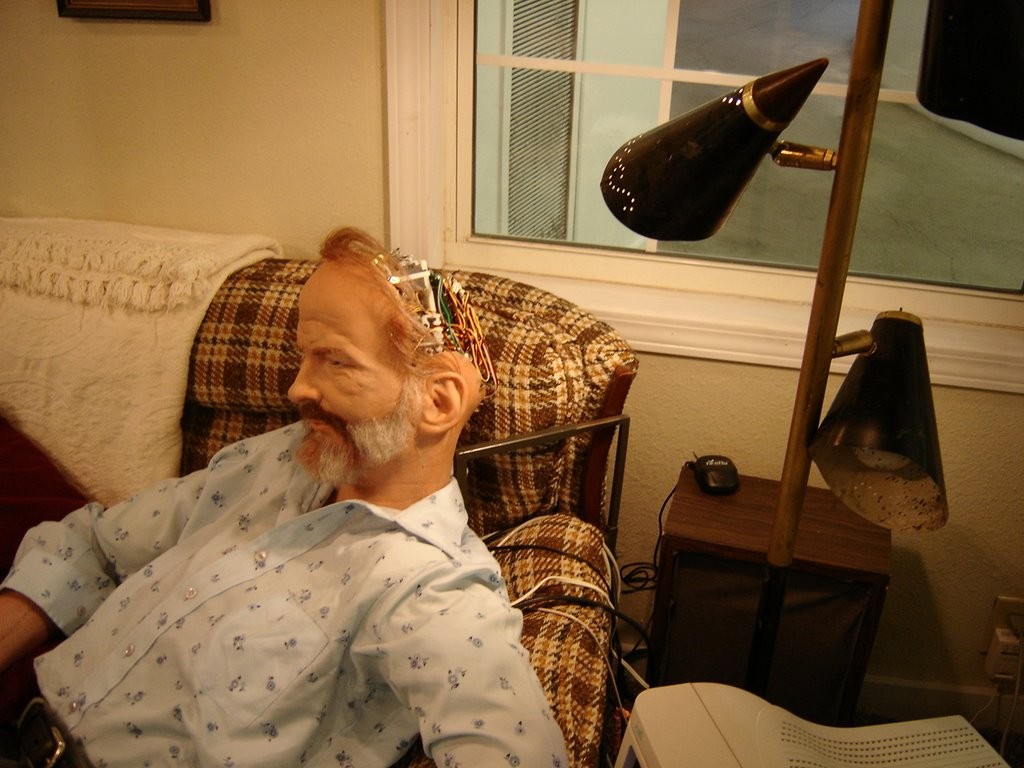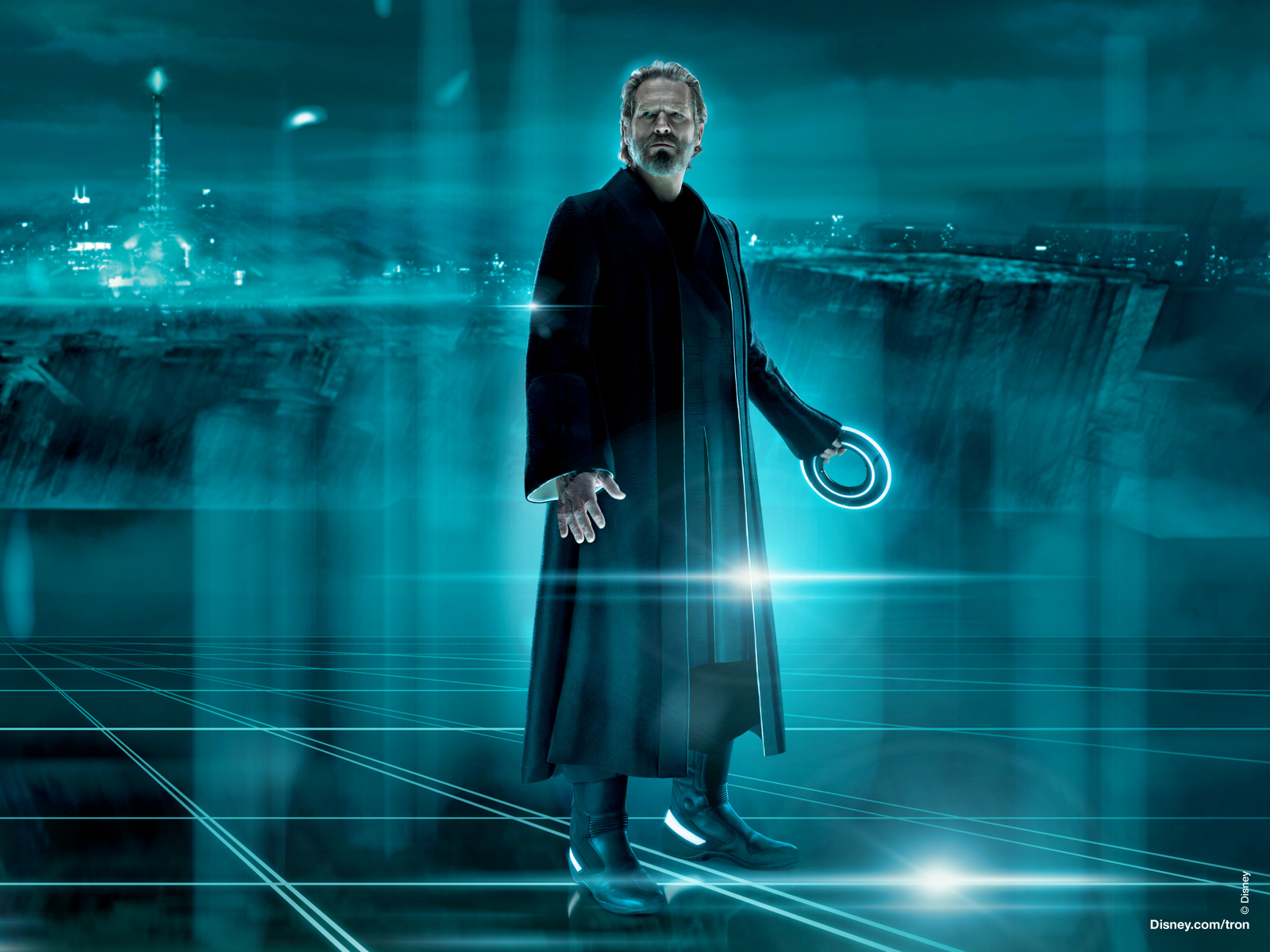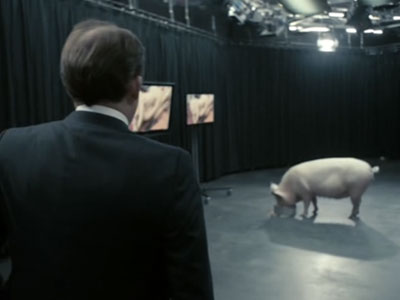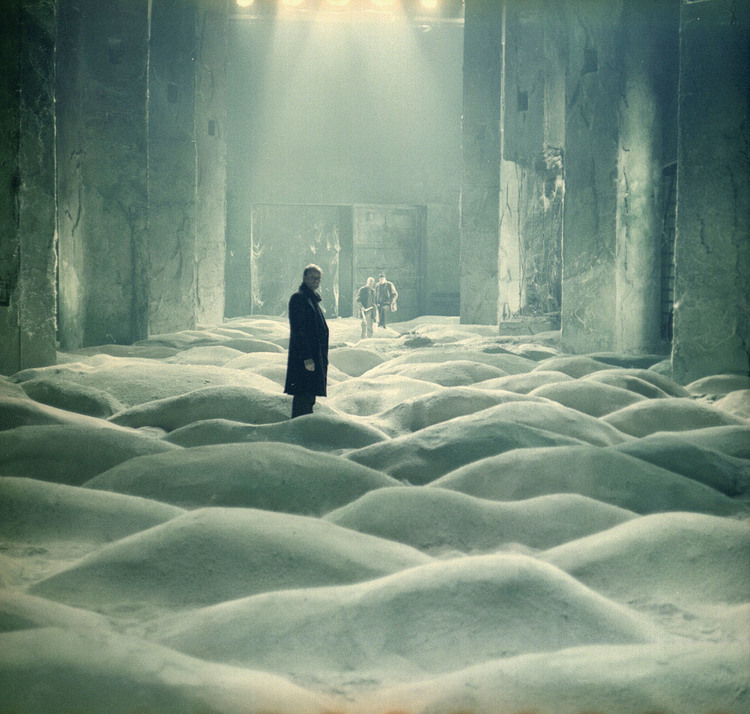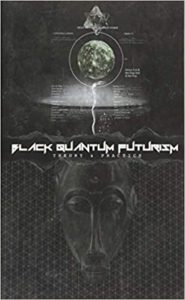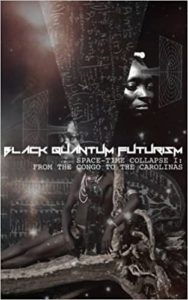The Nightshirt Sightings, Portents, Forebodings, Suspicions
The Phil Dick Circuit and the Future of Precognitive Technology
Much of the skepticism surrounding quantum neuroscience is that its aim is generally to explain consciousness—a tall, confused, and some would say impossibly misguided order. Quantum explanations for consciousness invariably require large-scale coherence—that is, entanglement—across the whole brain or at least between large populations of neurons. Quantum wet blankets point out that this can only be hand-waving and magic. And anti-materialists would say that no scientific account, no matter how quantum-y, is going to explain the subjective experience of being alive and aware.
I’d bet money that select neurons deep within specific circuits of the brain are going to turn out to be finely tuned time machines that fire before they are stimulated.
But as I’ve already argued, even if we know they are chasing a red herring, we should actively encourage Roger Penrose and others who are hunting for elusive consciousness in the quantum behavior of neurons and neural circuits. This is because a beneficial side-effect of that effort is that it is going to bring an explanation of the more philosophically humble but also more exciting phenomenon, psi.
Psi is exciting because it means precognition, time-traveling information. That should make people poop their pants with wonder and forget about boring old consciousness. Precognition is mind-bending, and it is not some vague airy effect of “nonlocality.” If I’m right, it is specifically sensitivity to our own responses to future stimuli, which means it is extremely local, in the sense of personal, like memory, and thus certainly involves brain processes. We now know that information can be sent back in time, and Seth Lloyd has shown how to do it (theoretically anyway). It involves entanglement, but not the long-distance entanglement between neurons that most offends quantum critics. If it can happen, nature will find a way, and those microtubules inside neurons that fascinate Penrose et al appear to be the best place in nature for it to occur.*
I’d bet money that select, as-yet undiscovered neurons deep within specific circuits of the brain are going to turn out to be finely tuned time machines that fire before they are stimulated. Serial entanglement of particles within or between the neuron’s microtubules over a short span of time would be involved. Particles traveling up and down a neuron’s axon through those tubes “just” need to break their prior entanglements and be re-entangled (sending information back in time), and this “just” needs to perturb the neuron’s behavior by even a tiny amount. I trust there are people working on the nitty gritty of this problem.
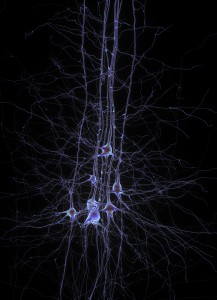 When you string multiple time-displaced neurons together, you can multiply the time-displacement effect. For instance, even if the net result of the various quantum shenanigans in a given neuron’s microstructures is that it fires off neurotransmitters to the next neuron just a hundredth of a second before it receives an input via its dendrites—a modest request—a string of twenty such neurons would produce an “output” (e.g., a motor or autonomic response) a fifth of a second before the stimulus. That’s enough to account for the delay Benjamin Libet famously noted between the neural readiness potential and the feeling of conscious will, which some wet blanket types like to wave before our eyes as proof that consciousness in an illusion.
When you string multiple time-displaced neurons together, you can multiply the time-displacement effect. For instance, even if the net result of the various quantum shenanigans in a given neuron’s microstructures is that it fires off neurotransmitters to the next neuron just a hundredth of a second before it receives an input via its dendrites—a modest request—a string of twenty such neurons would produce an “output” (e.g., a motor or autonomic response) a fifth of a second before the stimulus. That’s enough to account for the delay Benjamin Libet famously noted between the neural readiness potential and the feeling of conscious will, which some wet blanket types like to wave before our eyes as proof that consciousness in an illusion.
Fifty such neurons would give you a whole half-second “pre-sponse”—enough to account for the subjective timing discrepancy between seeing your foot hit the ground and feeling it hit the ground, noticed by Libet back in the late 1970s. A hundred such neurons in a circuit would give you a full second advance warning of events, useful on the highway, the battlefield, or the racquetball court. Three hundred would be sufficient for effects seen in many presentiment experiments conducted by Dean Radin and Daryl Bem.
There are a hundred billion neurons in the brain, and thus there could be any number of precognitive circuits or clusters of neurons in there, “tuned” to specific temporal distances that are sweet spots for certain adaptive responses or functions like subjective timing, conscious will, and James Carpenter’s “first sight,” not to mention premonitions of more remote events. I hope they name a particularly long one the Phil Dick Circuit, because such a neural mechanism would go a long way to explain the world he described in his writings.
The Skynet Is (Not) the Limit
So here’s a business model for a forward-thinking biotech company: Isolate the most precognitive neuron you can find in the animal kingdom, perhaps from an elephant or whale—something involved in synchronizing a large animal’s sense of self—and find a way to sustain a group of such neurons in culture. You could create a nice little precognitive alarm by chaining such neurons together. A chain of 1000 neurons, each of which fire, say, 20 milliseconds before they are stimulated, would produce a device that triggers about 20 seconds before a designated input. (This may be an easier and faster route than trying to build a mechanical quantum computer from scratch, given the extreme refrigeration requirements, etc.)
The challenge of precognitive technology is working within the narrow margin where information tends not to be self-cancelling.
Then, assemble several of these devices in a petri dish, and set the first neuron in each chain to respond to a downward change in the value of one of your stocks, triggering a “sell” as the output of the chain. I don’t have much of a head for such things, but you get the picture. Do it quietly, though, and amass your fortune quickly, because sooner or later a branch of the SEC will be established to prevent precognitive trading. (No doubt there will be telltale signs of such stunts, such as a tendency of company or an individual mad-scientist investor to drop shares in a stock just seconds before a downturn in value.)
Or you could just buy shares in a quantum computing company like D-Wave, because they are surely going to do something like this once it occurs to them … or it probably already has occurred to them. Such a scheme could, for all I know, be a big secret dream in the emerging quantum tech biz.
 I’m not completely kidding. I’m not an engineer, so I admittedly don’t have a sense of the technical hurdles, but as far as I can tell it “just” needs to be scaled up from what has already been accomplished at very micro scales in laboratories … or, again, from what select undiscovered neurons are doing right now in your own head. I imagine precognitive tech could be huge in the mid-21st century; the possibilities would be mind-blowing, not to mention highly destabilizing. The very first obvious application would be in financial trading, but a natural next step would be pairing artificial precognition with AI, which could be beyond scary. (FYI, just last month, D-Wave announced a multi-year contract with Lockheed-Martin. Skynet, anyone?) But precognitive chips could also have wide beneficial applications and revolutionize safety features in vehicles and security systems, not to mention healthcare. They might also provide the needed failsafes against those scary precognitive AIs.
I’m not completely kidding. I’m not an engineer, so I admittedly don’t have a sense of the technical hurdles, but as far as I can tell it “just” needs to be scaled up from what has already been accomplished at very micro scales in laboratories … or, again, from what select undiscovered neurons are doing right now in your own head. I imagine precognitive tech could be huge in the mid-21st century; the possibilities would be mind-blowing, not to mention highly destabilizing. The very first obvious application would be in financial trading, but a natural next step would be pairing artificial precognition with AI, which could be beyond scary. (FYI, just last month, D-Wave announced a multi-year contract with Lockheed-Martin. Skynet, anyone?) But precognitive chips could also have wide beneficial applications and revolutionize safety features in vehicles and security systems, not to mention healthcare. They might also provide the needed failsafes against those scary precognitive AIs.
Although it may seem like it, the sky is not the limit with precognition, synthetic or natural. The challenge of precognitive technology is working within the narrow margin where information tends not to be self-cancelling—this is the parameter of “post-selection” that is required by a Seth-Lloyd-style quantum time machine: You can’t build a system whose (prior) output leads to a chain of events that prevents its (subsequent) input. Fiction about time travel has failed to incorporate this crucial parameter, and as a result has given rise to all the comedy of grandfather paradoxes, etc. In reality, there wouldn’t be such problems because of the constraints within which information sent back in time can actually be readable and not noise. Quantum computers are actually analog computers, not digital; reality is analog too. Quantum computers and quantum time travel operate, if I understand correctly, on a signal-to-noise ratio—just as I have argued human precognition operates.
The vagaries of the analog universe are what forever prevent us from using the existence of precognition to answer questions about free will versus determinism. There is always wiggle room and uncertainty. These vagaries also set interesting constraints on the precognitive chips that might one day be at the heart of our devices and computers. They can only give us advance warning of certainties we can do nothing to prevent.
Precognitive Chips
As a thought experiment, imagine a precognitive computer chip inside your security system, tripped when unauthorized entry is detected. How much pre-warning could it give of a home intrusion?
Causality in an analog universe never contradicts the possible, but information is buried deeply in noise; we can never know for certain what information actually comes from the future
For any given application of precognitive tech, there would probably be a sweet spot—an optimal temporal distance between output and input within which the system tends to work reliably without noise exceeding signal. So for instance, an alarm system set to notify the police station 15 minutes before a break-in would not be viable and would literally not provide useful information; the reason is that 15 minutes is too much time, and would theoretically allow the police to be on the scene in advance and scare off anyone with malicious intent; in reality, the alarm would never go off except in cases when there was a break-in and the police were for some reason unable or unwilling to respond in time to prevent it. False alarms would tend to increase the more the alarms were ignored—too much noise to signal, resulting in a feedback loop, because they would be taken less and less seriously…
 It would be a highly dysfunctional chip, in other words. But the alarm manufacturer would never make such an alarm in the first place. (Makes you wonder if car alarms use such chips, since it seems the more we ignore them, the more they are tripped.)
It would be a highly dysfunctional chip, in other words. But the alarm manufacturer would never make such an alarm in the first place. (Makes you wonder if car alarms use such chips, since it seems the more we ignore them, the more they are tripped.)
For a home security system, I can imagine that a three-minute pre-lay might be more in the right ballpark. This might be enough time for the police to be en route to the scene and nab the burglar but not enough time for them to prevent the break-in that trips the alarm. In that case, the alarm would work more reliably; just after the burglar got in and tripped the alarm, he’d hear sirens approaching.
The same principle could be applied to vehicle safety devices: You could not have a precognitive system in a car that reliably warned you five seconds before a collision, because you or the car’s computer driver could avoid the collision with that kind of warning, nullifying the chip’s effectiveness. You could however have a precognitive system that responded to a non-avoidable collision half a second into the future. This could be useful, for instance, in pre-triggering airbags and other safety features to protect the vehicle’s occupants. Or, in a jet fighter—if there are still human pilots in jet fighters when this becomes possible—you could have an ejector seat triggered by a precognitive sensor half a second before a missile strike (but, again, not one that gave the pilot sufficient time to evade or destroy the threat with a countermeasure).
And there’s medical devices: For instance, medical sensors to detect an imminent heart attack. Again, a bio-chip could not alert you to an adverse event that was preventable through your actions (like popping an aspirin), but it could trigger an emergency response and perhaps pre-initiate measures to mitigate the harm or tissue damage and prevent death.
Those are just a few ideas that come to mind. The applications in cybersecurity and cyberwarfare, of course, are intimidating (and bewildering) to think about. But again, they wouldn’t enable anyone (or even any AI) to fully manipulate reality, just game it or leverage it in interesting ways.
The Safety Zone
To me, this narrow band within which precognition’s effects are actionable and useful is the really interesting thing about it. Most precognitive effects, especially when they enter consciousness at all, such as in dreams, are only visible after the fact. It needs to be that way, because enhanced consciousness of future events would result in us taking “evasive action,” even inadvertently, so the farther out in the future a precognitively portended event, the more we will tend to encounter the information obliquely, associatively, “synchronistically,” or otherwise in a way that facilitates our misinterpreting or ignoring it until too late.
Precognition is built around reward and enjoyment, not trauma and pain. Post-selection explains why positive signals of reward are preferentially “pre-ceived.”
In the comments to my last post, a reader asked an excellent question, which goes to the heart of this problem: What if you have a dream that you’re going to die in a car accident so you take a bus instead, and nothing happens? From what future could the idea “you’re going to die in a car accident” have been sent? The answer is going to seem evasive: How do you know it was ever a premonition? How do you know that information was sent from the future? You have no way of reliably saying so until it “comes true.” So it’s wrong to say it was a premonition; it may have felt premonitory, but we have hunches all the time that prove wrong. Our metacognition—knowledge of where a piece of information comes from—is often distorted or imperfect. This is as true of precognition as it is of memory (and they will both probably turn out to be the same thing).
 Causality in an analog universe never contradicts the possible, but information is buried deeply in noise; we can never know for certain what information actually comes from the future, or even its “accuracy” (i.e., correspondence to future events) beforehand. The confirmation scene, when some prior hunch matches a real event, is a crucial part of the process, and this must happen in the ordinary workaday flow of linear time.
Causality in an analog universe never contradicts the possible, but information is buried deeply in noise; we can never know for certain what information actually comes from the future, or even its “accuracy” (i.e., correspondence to future events) beforehand. The confirmation scene, when some prior hunch matches a real event, is a crucial part of the process, and this must happen in the ordinary workaday flow of linear time.
Hacking the system is possible, but within narrow parameters. An elaborate associative remote viewing setup, for example, can be used to play the stock market, as Russell Targ proved in 1982 with his successful adventure in silver futures trading. But you can’t just, by yourself, rub your temples and see straight-on what’s going to happen in the future; it just doesn’t work that way, because it can’t. There are good reasons evolution hasn’t made us all massively precognitive supermen and -women; even apart from the peculiarities of post-selection, there would be adaptive reasons for a biological system to keep precognition within strict limits and mostly unconscious.
Fire, Walk With Me
Precognition is built around reward and enjoyment, not trauma and pain. Post-selection explains why positive signals of reward are preferentially “pre-ceived”: Reward circuits would be precognitive, because we will orient toward future pleasures, and thus tend to produce the action that results in the pleasure that sends a signal back in time. This is the primary reason why I think dopamine and the brain’s reward circuitry will turn out to have an important connection to those precognitive neuronal ensembles. This is the system that keeps us focused on “the next thing,” drawing our interest to pleasure as well as survival-relevant information.
There is nothing particularly “moral” about psi. Instead of binding us to other people across space, psi binds us to ourselves in the future, and to our own relief or pleasure within the larger context of threat and danger.
Pain traveling into the past, on the other hand, would lead the organism to take a course of action that leads to the avoidance of the stimulus that caused it, thus such a circuit would not be reliable, would violate the rules of post-selection, and would be selected against. Even as a survival tool, precognition will be oriented toward relief from threat or punishment, not the threat or punishment itself. I have noticed in my own case, for example, that precognitive dreams occur most around changes in emotion, from frustration to gratification.
Why then is the precognitive signal so strong around other people’s pain and suffering—the observation that led Fredric Myers to believe that trauma “powered” psychic phenomena? The answer is jouissance, the binding of pleasure to pain, including the intense sublime awe at surviving disasters that befall other people. Precognition may in fact be the very reason for jouissance, the very reason we get excited about destruction, fire, and death, especially when these things happen to others. Jouissance was Jacques Lacan’s answer to Freud’s concept of the “death drive,” which seemed paradoxical because Freud couldn’t see how it would be adaptive to be drawn to death. We’re not really drawn to death, but we are necessarily fascinated by death and pain as long as we can extract some personal reward from it.
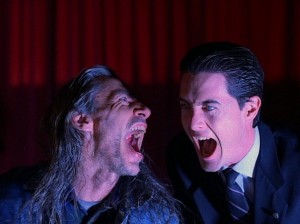 When I think of jouissance in the context of psi, I think of “Bob” and his demon-spirit friends in Twin Peaks’ Black Lodge, who seem to personify our necessary and terrifying dark side, the hunger for others’ pain and suffering, or “Garmonbozia.” David Lynch is deeply keyed into this nexus of psi and occult forces, which probably has its roots in our most basic and ancient survival needs.
When I think of jouissance in the context of psi, I think of “Bob” and his demon-spirit friends in Twin Peaks’ Black Lodge, who seem to personify our necessary and terrifying dark side, the hunger for others’ pain and suffering, or “Garmonbozia.” David Lynch is deeply keyed into this nexus of psi and occult forces, which probably has its roots in our most basic and ancient survival needs.
So psi (as precognition) is a system that orients us to threats by making threat-vigillance and the threat response rewarding. Here’s where I disagree slightly with Myers, or Jeffrey Kripal: There is nothing particularly “moral” about psi, at least not directly. Instead of binding us to other people across space, psi binds us to ourselves across time, specifically to our own relief or pleasure within the larger context of life’s perils and pains. Yet I think a major positive byproduct of psi is that it orients us, unconsciously, to rewarding (or relieving) future scenes of connection to other people IRL, in real life. Unconsciously, it pulls us toward eros and the good. This is because it is with and among others that our more mundane, linear-in-time, classical brains take conventional pleasure and respite from those perils and pains.
NOTE
* Here’s a fun microtubule fact: The ancestors of the microtubules in your cells were spirochetes back in the primordial soup days of the early Earth. They were eventually engulfed as endosymbiotes within other bacteria, to make the more complex cells that build the macro-sized beings of our world. So in other words, the billions of mini time machines in your brain right now share a common ancestor with syphilis.** You’re welcome.
FRACTAL NOTE WITHIN A NOTE (added 12/5/15)
** A reader has helpfully alerted me that, despite decades of searching, Lynn Margulis has been unable to support her hypothesis that microtubules descended from engulfed spirochetes. So that idea, however cool, is probably not true. We can’t have everything.
Quantum Psychoanalysis: Interpreting Precognitive Dreams
Near the end of Christopher Nolan’s 2014 film Interstellar, astronaut “Coop” is able to communicate with his younger self (as well as his daughter) decades in the past using a tesseract, a theoretical multidimensional portal created by our descendents thousands or millions of years in the future. Coop’s messages are oblique—he can’t address his younger self directly but has to send symbolic messages using the books on his bookshelf. His younger self, before his planned mission to a black hole, realizes there something significant occurring but misses the precise meaning of these messages: a warning not to go.
The character of the brain’s self-relating across time is allusive and indirect: We don’t just appear to ourselves bearing explicit messages from the future; messages from our future self are oblique, more like a game of charades.
If the brain is a quantum computer, the possibility I discussed in the last post, it could work by creating coherent systems of entangled particles that are isolated enough, for long enough, that they are able to manipulate information in ways far beyond what conventional computers can achieve, including sending coherent information into the past and extracting information arriving from the future. Whether or not the mechanism is precisely the one I proposed, based on Seth Lloyd’s theory of time travel via quantum teleportation, I predict that some form of trading and extracting of coherent information across time may turn out to be a basic function of the cortex, a picture that could provide a radically new understanding not only of psi but also of memory and other basic cognitive functions. The brain may be precisely something like Nolan’s tesseract, an organ that is genuinely a tunnel through time, extending across our whole lifespan.
So at the risk of sounding like a reductive materialist bad-guy (which, honest, I’m not), I do think the answer to psi (not necessarily consciousness) is going to be found in neuroscience. All the evidence points to this. No energy transmission or reception has ever been found to account for psi. The physics of information that governs psi and synchronicity has nothing to do with “thoughts through space,” the airy mental image most of us probably have when we think of psychic phenomena. We need to get rid of that mental model of waves radiating from or toward a head. The brain may not create consciousness, but it certainly gives shape to our conscious experience, in the form of memory, thoughts, symbol use, sense of self, and so on. Our experience is processed and shaped by the brain, so our future experiences are mediated by our brain in the future.
 I see a brain-based theory of psi as a more compelling alternative to “nonlocality” theories commonly invoked by parapsychologists. Even if it is true that all points in space and time are connected, that gets us no closer to explaining how psi works—for example, how a remote viewer given an arbitrary code word can home in on and describe a specific geographical target that the code word represents, among all possible targets in the universe (and that she hasn’t seen before and couldn’t possibly “recognize”); or how a mother could have a vision of her own dying son on a battlefield (and not all dying people everywhere); or why people have premonitions not of major disasters but specifically of their own reading of those disasters in the news (J.W. Dunne’s major discovery in his 1927 book An Experiment With Time). None of this has anything to do with nonlocality; it’s a matter of information search and retrieval, and it reveals how intimately personal psi information is—we are “recollecting” information from a future point in our own timeline when we will learn something we don’t yet know and don’t yet even know we want to know.
I see a brain-based theory of psi as a more compelling alternative to “nonlocality” theories commonly invoked by parapsychologists. Even if it is true that all points in space and time are connected, that gets us no closer to explaining how psi works—for example, how a remote viewer given an arbitrary code word can home in on and describe a specific geographical target that the code word represents, among all possible targets in the universe (and that she hasn’t seen before and couldn’t possibly “recognize”); or how a mother could have a vision of her own dying son on a battlefield (and not all dying people everywhere); or why people have premonitions not of major disasters but specifically of their own reading of those disasters in the news (J.W. Dunne’s major discovery in his 1927 book An Experiment With Time). None of this has anything to do with nonlocality; it’s a matter of information search and retrieval, and it reveals how intimately personal psi information is—we are “recollecting” information from a future point in our own timeline when we will learn something we don’t yet know and don’t yet even know we want to know.
Psi is thus fundamentally memory-like in the way it behaves. Just as we can only remember our own past and not other people’s pasts, we can only remember our own future. And besides being personal, psi is also associative—again, just like memory.
Free Association
As in Nolan’s tesseract, the character of the brain’s self-relating across time is allusive and indirect: We don’t just appear to ourselves bearing explicit messages from the future; messages from our future self are oblique, more like a game of charades. They may need to be, to conform to the rules that govern memory, and to conform to the demands of “post-selection”—that is, not allowing an action that would foreclose the message from being sent. It’s not like there’s a “precognition police” enforcing this; it’s more like informational Darwinism: the only precognitive messages that “survive” are the ones that lead to their being sent back in time in the first place. Among the parameters of such a tesseract would be a tendency for the clearest examples of precognition to be only consciously recognizable after the fact, unless there is no possibility of preventing the future outcome in which information was sent to the present.
The fact that so much precognitive dream material comes to light when using free association suggests that precognitive dreaming occurs far more frequently than even its advocates typically assert.
Precognitive dreams illustrate this principle marvelously. The basic function of dreaming appears to be the updating of the brain’s associative search system that catalogs and files daily autobiographical events by linking them to other events (and themes) in our long-term memory. Although isolated elements may be immediately recognizable as “day residues,” dream episodes never literalistically represent events, but are tableaux assembled from memories and images those events remind the unconscious of—exactly the kinds of distortions and displacements that Freud mis-took as symbolic disguises for repressed wishes. But even if dreaming’s function is basically mnemonic and not wish-fulfillment, mnemonic associations are formed through precisely the types of puns and other substitutions that Freud identified. Precognitive dreams obey the same principles, and this is why free-association is invaluable in uncovering the true extent of our our nightly precognizing.
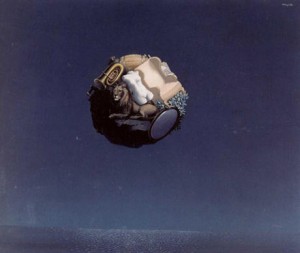 Standard Freudian dream interpreters, being entirely past-looking—and biased to search for disguised wishes—are liable to completely miss the large number of precognitive dreams we have on a nightly basis. I now suspect that a sizable portion, maybe even half, of our dreams actually encode events of the subsequent day or farther out, but this is inevitably missed if we do not return to our dreams at later intervals (especially the following afternoon or evening) with an eye to searching for this material.
Standard Freudian dream interpreters, being entirely past-looking—and biased to search for disguised wishes—are liable to completely miss the large number of precognitive dreams we have on a nightly basis. I now suspect that a sizable portion, maybe even half, of our dreams actually encode events of the subsequent day or farther out, but this is inevitably missed if we do not return to our dreams at later intervals (especially the following afternoon or evening) with an eye to searching for this material.
You don’t need to contort or “twist” a dream to find precognitive referents. Contrary to what Freud-bashers always assert, free-association is not (when it is done right) straining to come up with “meanings” that will lead to a desired conclusion. You do have to play by the rules though: Only the first thing that comes to mind for a noticed dream element is a valid connection. If the first things that come to mind for various dream elements don’t suggestively illuminate a dream episode, just leave it. Many dreams are smarter than we are, and we have to concede defeat; others may refer to events that haven’t happened yet, so we can never assume that the right answer is findable. But when done in good faith, free association reveals abundant precognitive material in dreams that would otherwise go unnoticed.
A particularly clear example from my dream journal from this past April will serve to illustrate the process. (Apologies in advance—I hate reading other people’s dreams, and I know you do to…)
Petroglyph Dream
On my way up a mountain, I had stopped at a roadside tourist attraction, a cave with ancient Indian petroglyphs on the ceiling, the most prominent being an enormous elongated/tall rectangular ‘man’ or headless being of some sort, reminding me of one of those elongated tall shaman figures in Southwest rock art [like the middle figure in the picture below], and then a smaller object higher above that figure that I found less interesting. I didn’t have my camera with me (specifically, my old Pentax, which I knew was loaded with black and white film), but I thought I could get it somewhere farther up (the mountain); so I resolved to stop on my way back down so I could take black and white pictures of the petroglyph.
The scene changed: I realized I had my iphone in the car so I retrieved it and attempted to take color pictures in the cave. No matter what I did, however, the screen kept “repelling” my attempt to photograph the largest (tall, vertical) petroglyph that interested me. I turned the camera around to use the front-facing camera, but it still only showed my face on the screen, as though there were a force field preventing any image of the actual petroglyph. Then I dropped the phone and damaged the side, where a button is.
The scene shifted again: I was inside a visitor’s center at the “top” of the mountain, but associated with the cave. It was circular in plan, and around the outer ring were various vestibules with stuff for sale, including snacks. I found a coffee-flavored drink to buy. I thought there might be something else interesting in one of the other rooms, so I went searching, and circled the whole visitor’s center and came back to where I’d started, disappointed.
 On writing down the dream initially, the only association that immediately came to mind was the “unphotographable petroglyph”: Two decades ago, when living and working in Eastern Europe, I had a coworker friend named Petra who refused to be photographed; my only picture of her shows her with her face turned away and her hand held up to block the camera. Thus “petroglyph” seemed to be a kind of dream representation of Petra, a “Petra picture.” There was no reason in my current life to be thinking of this old coworker, however. It was later that afternoon that the primary event-referent of the dream became clear.
On writing down the dream initially, the only association that immediately came to mind was the “unphotographable petroglyph”: Two decades ago, when living and working in Eastern Europe, I had a coworker friend named Petra who refused to be photographed; my only picture of her shows her with her face turned away and her hand held up to block the camera. Thus “petroglyph” seemed to be a kind of dream representation of Petra, a “Petra picture.” There was no reason in my current life to be thinking of this old coworker, however. It was later that afternoon that the primary event-referent of the dream became clear.
I had taken time away from my work to watch the live web coverage of a SpaceX launch from Cape Canaveral, which would be delivering a cargo module to the International Space Station. It was somewhat exciting, as all rocket launches are, but my main reason for watching this launch was my expectation—based on some Twitter postings earlier that day—that SpaceX might also broadcast the attempted landing of the first stage of the rocket on a barge in the Atlantic; this retrieval method had failed the previous two attempts, but there were high hopes for success in this case. After the launch the cameras on board the rocket showed the first stage separation, but the only views subsequently shown were shots of the exterior and interior of the orbital Dragon module; several minutes passed, and I became increasingly frustrated when the cameras didn’t cut away to show the first-stage retrieval I had been excited to see. It became apparent that, despite the misleading publicity on this launch, the SpaceX broadcast was not going to show the landing, no doubt because of the uncertainty of the outcome.
 In the aftermath of my frustration at being unable to view the first-stage landing/retrieval, I realized that my petroglyph dream had been about this minor emotional salience in my otherwise uneventful workday, and thus my frustration turned to excitement. The shape of the bottom/main petroglyph I was interested in, in the dream, was exactly like a tall first stage of the rocket with a flat top. In the dream, the object of my interest resisted being photographed/viewed, like my friend Petra many years before, and thus the dream concocted an amalgam of these two ideas: a “Petra picture,” placed overhead on the roof of a dark cave (like the sky), which my iPhone (a small computer/camera) was unable to capture in its screen. (Remember that there was also a smaller object up above the tall “man” that I found less interesting.) One of Freud’s key insights was that the unconscious cannot represent or conceive an absence; it must put an object in its place—in this case a cave roof for the empty sky, narratively consistent with the “petroglyph” idea that was itself required by the pun on Petra picture, perfectly fit the bill.
In the aftermath of my frustration at being unable to view the first-stage landing/retrieval, I realized that my petroglyph dream had been about this minor emotional salience in my otherwise uneventful workday, and thus my frustration turned to excitement. The shape of the bottom/main petroglyph I was interested in, in the dream, was exactly like a tall first stage of the rocket with a flat top. In the dream, the object of my interest resisted being photographed/viewed, like my friend Petra many years before, and thus the dream concocted an amalgam of these two ideas: a “Petra picture,” placed overhead on the roof of a dark cave (like the sky), which my iPhone (a small computer/camera) was unable to capture in its screen. (Remember that there was also a smaller object up above the tall “man” that I found less interesting.) One of Freud’s key insights was that the unconscious cannot represent or conceive an absence; it must put an object in its place—in this case a cave roof for the empty sky, narratively consistent with the “petroglyph” idea that was itself required by the pun on Petra picture, perfectly fit the bill.
 That the petroglyph dream element referred to the first stage of the SpaceX rocket is clinched by my desire/intention in the dream of getting my old Pentax camera and photograph it in black and white. This was a very specific memory reference to watching a space shuttle launch in Orlando Florida in the late 1990s, which I had photographed with my Pentax, not remembering it was loaded with black and white film—producing very disappointing lackluster photographs of what was a colorful and spectacular sight. (I have not used that Pentax camera in many years, and that frustrating event was my strongest “free association” with that camera.) In the dream, I specifically wanted to get my Pentax to photograph it “on the way back down”—displacing the rocket’s “way back down” with my own way back down the mountain.
That the petroglyph dream element referred to the first stage of the SpaceX rocket is clinched by my desire/intention in the dream of getting my old Pentax camera and photograph it in black and white. This was a very specific memory reference to watching a space shuttle launch in Orlando Florida in the late 1990s, which I had photographed with my Pentax, not remembering it was loaded with black and white film—producing very disappointing lackluster photographs of what was a colorful and spectacular sight. (I have not used that Pentax camera in many years, and that frustrating event was my strongest “free association” with that camera.) In the dream, I specifically wanted to get my Pentax to photograph it “on the way back down”—displacing the rocket’s “way back down” with my own way back down the mountain.
 Although the first-stage retrieval was not televised, news tidbits trickled in via Twitter that the barge landing had failed; one person on Twitter said they “broke the rocket.” It was revealed that the rocket had hit hard, with too much lateral momentum, and fallen over on its side. In the dream, I dropped my phone and broke it, specifically the button on its side. (A few days later, video was made available showing the interesting and highly entropic outcome of the failed landing attempt: the rocket descending onto the barge but falling over and exploding.)
Although the first-stage retrieval was not televised, news tidbits trickled in via Twitter that the barge landing had failed; one person on Twitter said they “broke the rocket.” It was revealed that the rocket had hit hard, with too much lateral momentum, and fallen over on its side. In the dream, I dropped my phone and broke it, specifically the button on its side. (A few days later, video was made available showing the interesting and highly entropic outcome of the failed landing attempt: the rocket descending onto the barge but falling over and exploding.)
The last part of my dream, about traversing a circular gift shop “at the top of the mountain” and finding a coffee drink, is also directly significant. The main media-worthy fact about this SpaceX mission, which was part of the chatter during the launch coverage, was that it was going to be delivering an espresso machine to the International Space Station. During the coverage, at the point of my maximal frustration (i.e., when I hoped it would cut away to show the barge retrieval), what was shown instead was a boring, somewhat ambiguous viewpoint inside the circular cargo module, along its visibly curved edge (i.e., my frustration and disappointment at circling the circular gift shop and finding nothing but a coffee drink).
Thus, as is typical with dreams, various old memory fragments with resonances to an emotionally salient autobiographical situation (inability to see/photograph a friend; failure to satisfyingly photograph a rocket launch) were woven together by the unconscious to create an associative symbolic tableau, rather like a game of charades hinting strongly at a core autobiographical event that is not directly represented; but in this case the event was a few hours in my future, not the previous day or two as is the somewhat more familiar and typical pattern.
Psi has always been noted to involve emotional upheavals of various kinds, and to especially express itself when ordinary communication channels prove limiting or frustrating—both of these characterized the autobiographical episode this dream seemed to be pre-encoding. (The connection between new communications technology and psi is a whole topic in itself, of course; in the early days of the ARPAnet, Jacques Vallee noted telepathy occurring among networked chat users.) Also, there is a distinct connection between precognitive information and highly “entropic” events like rocket launches and explosions, as Edwin May has shown. Many (although not all) of my own precognitive dreams involve entropy gradients in one way or another—often an entropic event on the news, or indeed on Twitter—although I believe this has less to do with our “psi eyes” and more to do with the kinds of information we as humans find interesting and survival-relevant, whatever the sensory channel. True to form, this dream managed to draw together multiple lines of association to express the idea of a disappointing or frustrating failure to fully see what I wanted to see—a camera being a standard representation of “seeing”—precisely in connection with a rocket launch and landing.
Dunne Right
Note that there is nothing immediately obvious in the above dream that would connect it with what I am asserting was its future referent; like most precognitive dreams, it would have gone completely unnoticed had I not been in a habit of (a) recording my dreams, (b) unpacking my dreams via free-associative Freudian methods, and (c) revisiting them later in the day in search of possible precognitive references. Again, a dream is not a literal replay of an event (past or future), but the firing of neural circuits that in one way or another closely associate to that memory (or its themes)—wiring these associations together by firing them together. Dreaming is the experience of neural rewiring, the updating of the search system, and thus the actual autobiographical episode they relate to is generally not represented and thus not obvious at first glance; the dream is a kind of associative halo around the event, and the event is a kind of blank space at its heart.
Unacceptable emotions about 9/11 may have been sacrificed to the past, retroactively giving rise to the countless premonitory and precognitive dreams and visions experienced by Americans during the previous days and weeks.
Dreams in which you can discern the precognitive referent without any kind of free-associative unpacking are infrequent, but even those are common enough that a casual dream-recorder can occasionally discover them. J.W. Dunne gave no thought to Freudian methods of dream interpretation, for instance, yet recorded several plainly precognitive dreams that had very little symbolic/associative ‘disguise.’ Dale Graff, who was a director and remote viewer in the Star Gate program, has written extensively of dream precognition and precognitive remote viewing using dreams in his excellent memoirs Tracks in the Psychic Wilderness and River Dreams, and he also describes several examples in which the target is plain without the use of free association.
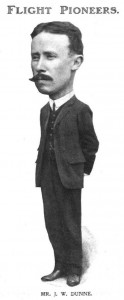 The fact that so much precognitive dream material comes to light when using free association suggests that precognitive dreaming occurs far more frequently than even its advocates typically assert. In my case, not a week goes by when I do not record at least a few dreams like the above, that clearly refer (once unpacked) to an event the following day. Typically these events are trivial, not the sort of thing you’d imagine warranted a warning or alert, and certainly lacking the “numinous” quality commonly associated with premonitory dreams. Even the most assiduous dream recorder only remembers and records a small handful of his/her dreams each night. We may dream for a few hours each night but, in my case, I suspect my recorded dreams amount to only a tiny fraction of that total—perhaps a few minutes worth of narrative. Thus I suspect strongly that we are, all of us, probably precognitively dreaming (in addition to retrocognitively dreaming) in abundance. It’s probably a basic function. The trouble is that dreams are very hard to remember and are otherwise highly recalcitrant to study, for a host of reasons.
The fact that so much precognitive dream material comes to light when using free association suggests that precognitive dreaming occurs far more frequently than even its advocates typically assert. In my case, not a week goes by when I do not record at least a few dreams like the above, that clearly refer (once unpacked) to an event the following day. Typically these events are trivial, not the sort of thing you’d imagine warranted a warning or alert, and certainly lacking the “numinous” quality commonly associated with premonitory dreams. Even the most assiduous dream recorder only remembers and records a small handful of his/her dreams each night. We may dream for a few hours each night but, in my case, I suspect my recorded dreams amount to only a tiny fraction of that total—perhaps a few minutes worth of narrative. Thus I suspect strongly that we are, all of us, probably precognitively dreaming (in addition to retrocognitively dreaming) in abundance. It’s probably a basic function. The trouble is that dreams are very hard to remember and are otherwise highly recalcitrant to study, for a host of reasons.
For one thing, the dreamer is an n of 1, and his/her associative language is unique, and thus it can take years of working with one’s own dreams to get a sense of their character. And critics will always be able to accuse you of making your interpretations up. The “n of 1” problem is what makes Freudian dream interpretation—as well as its variant, mnemonic dream interpretation—inherently untestable. No dream can be replicated, and multiple dreamers will dream about the same experience in totally unique and idiosyncratic ways. The most basic support for the mnemonic theory, however, is in its consistency: If one dream element associates to a particular event in daily life, the remainder of the elements in the same dream episode almost always refer to that same episode or to the same narrow window of time. Again, this is because they are not wish-fulfillments but bundled episodic memories being processed and accessioned by the hippocampus. The hippocampus is like our autobiographical librarian; dreaming is like that librarian taking a new book/event, stamping it with a bar code and scanning it into the system, before placing it on the appropriate shelf; our dreams are those bar codes.
Also, dreams are hard to fully unpack in public or outside a therapeutic context because they touch on very personal, private symbolism that is just too difficult to explain to others to make it worth the trouble. I chose the “Petroglyph” dream not because it is the most stand-out example but because the symbolism in it doesn’t happen to be that embarrassing or personal (although it still strains the “TMI” limits that make another person’s dream-interpretations always annoying or embarrassing to hear). Most are much worse from the sharability standpoint. This is why the psychoanalytic literature is such an important augmentation to Dunne and the rest of the parapsychological literature bearing on precognition. Jule Eisenbud’s books Psi and Psychoanalysis and Paranormal Foreknowledge are full of compelling examples taken from his own case files.
The bottom line is that precognition is normal and constant, but is highly personal, like memory, and manifests indirectly and unconsciously. We are undoubtedly also receiving precognitive information across the course of the day that never gets expressed in any conscious form but primes us for action and thought in numerous invisible ways. This is the “first sight” logic described by James Carpenter, which is supported by numerous presentiment studies such as those by Daryl Bem, Dean Radin, and Julia Mossbridge. So-called synchronicities, of course, are misrecognized precognition’s main, most visible symptom.
Precognition and Repression
This is more speculative, but I have a hunch that those associative rules that govern memory and precognition may have a specifically “quantum” rationale in information theory. On the quantum level, in a closed, coherent system such as a quantum computer, information cannot be lost or destroyed, but only “traded” back and forth through time, and thus post-selected information would specifically transfer back in time and disappear from the present. The ongoing fluidity and flux of memory could be a product of information obeying quantum (or quantum-like) rules, even if association itself really involves macro-scale, classical dynamics.
Precognition may even be the flip side of repression: Repression would be a process of trading unwanted data into the past, and precognition would be the corresponding process of receiving that repressed information from the future.
The brain’s ongoing process of time-binding may thus involve acquiring information from the future at the price of loss of information in the present and losing information in the present to the past when new information is acquired—such as an emotionally salient (i.e., memorable) autobiographical event. If some function of attention is able to make determinations about what part of that new information to keep in the present, then precognition would be linked with this preference system. This would give us reason to link the Freudian concept of “repression” to this process of making choices about the dispersal of information in time.
It may even be that precognition is the flip side of repression: Repression would be a process of trading unwanted data into the past, and precognition would be the corresponding process of receiving that repressed (and hard to interpret) information from the future. Or you could say, precognition is the appearance of new information without knowing the cause, whereas repression is a cause that seems to somehow lose its effect by losing part of its affect.
If this is so, we would be especially precognitive for events that are too “explosive” (in multiple senses) and that we do not want to fully confront or face right when they happen. As I discussed in my “Trauma Displaced in Time” article, the splitting of our reaction to traumatic events like disasters may cause any positive emotion connected with them to “travel” into the past and emerge as premonitory or precognitive information before the traumatic event occurs. A range of positive feelings like excitement, thrill, and arousal were stimulated by news coverage of the terror attacks on 9/11, for instance, particularly for those who didn’t have loved ones possibly affected by the disaster. These unacceptable emotions may have been partially or wholly sacrificed to the past, retroactively giving rise to the countless premonitory and precognitive dreams and visions experienced by Americans during the previous days and weeks.
If there were any way to test it, I would bet money that 99 percent of Americans dreamed of the terror attacks on the night of 9/10/2001; the thousands who actually reported their premonitory dreams of the event were just a fraction of those that noticed such dreams and didn’t report them, which would itself be a tiny fraction of those who had dreams associatively linked to the themes of the day without ever noticing the link … and that would be a tiny fraction of those who had such dreams but didn’t remember them at all, and so on. (There should a be Drake Equation for precognitive dreaming.)
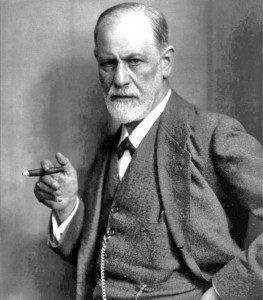 In fact, in keeping with my current obsession with “Twitter dreams” (which I seem to have a few times a week), I think part of that unacceptable emotional energy around disasters might be the frenetic, dopamine-induced excitement we feel when they are unfolding, particularly stoked by TV and new media like Twitter. Although we outwardly express grief and shock, it is the savage (but really, highly adaptive) eagerness to “find out more” that keeps us engaged with unfolding tragedies like terror attacks. That excitement, if my hunch is right, may be a lot of what gets shunted to the past.
In fact, in keeping with my current obsession with “Twitter dreams” (which I seem to have a few times a week), I think part of that unacceptable emotional energy around disasters might be the frenetic, dopamine-induced excitement we feel when they are unfolding, particularly stoked by TV and new media like Twitter. Although we outwardly express grief and shock, it is the savage (but really, highly adaptive) eagerness to “find out more” that keeps us engaged with unfolding tragedies like terror attacks. That excitement, if my hunch is right, may be a lot of what gets shunted to the past.
Straightforward excitement at a reward or achievement in the process of skilled engagement can also be traded into the past for another reason. Anyone who does a martial art or writes creatively or performs any high-stakes skill (flying a plane, performing brain surgery, etc.) knows that requirement of successful skill-engagement is “curbing your enthusiasm”—not allowing yourself the luxury of celebrating small successes in the moment but staying coldly focused. Thus, just like with traumas but for different reasons, rewards may pass excitement back into the past or future, accounting for the greater emergence of highly adaptive precognition in these flow states, consistent with the “first sight” idea. Just a hunch.
POSTSCRIPT: Does Longevity = Processing Power?
I realize it is highly out of fashion to liken the brain to a computer, but quantum computing may breathe new and interesting life into that metaphor. If the brain can reach across its own timeline, accessing information in its future and past, then it could be characterized as a fully four-dimensional information processor, able to utilize all its computing power over its whole lifespan, not to mention capitalize on all the other fantastical abilities of “qubits.” If the brain is a quantum computer (or more likely, an assemblage of billions of quantum computers linked classically)—and if it thus can, at any given moment, utilize all of its states across time, as well as all possible paths to obtaining the answer to a search query in memory—then not only its precognitive capabilities but its computing abilities in general would be formidable indeed.
Mentally, we are in the after-life, displaced (milliseconds, seconds, hours, even years sometimes) from the classical billiard-ball unfolding of our physical bodies.
It is already well known that, in humans, intelligence correlates with longevity; although obvious commonsensical explanations, such as smarter individuals being better able to avoid dangers, are no doubt operative, some research has found a common genetic factor uniting them. The notion that brain could be a quantum computer “calculating” across its whole history raises a further possibility: that longer lifespan causes higher intelligence by increasing the four-dimensional computing resources of the individual’s brain. This could perhaps provide an alternative explanation for the genetic correlation.
 I am opposed to frivolous animal experiments, but purely as an animal-thought-experiment, you could test this idea by assessing the intelligence or problem-solving ability of a group of identical animals (cloned mice, for instance), and then sacrifice a randomly selected half of the group immediately after the assessment, letting the remainder live a full life. If their brains are making computations drawing on the computing power of a whole mouse lifetime, the long-lived mice would be hypothesized to perform better than the short-lived ones. A more ethical variant of this type of experiment would be to randomly expose half the mice to a condition of more learning and a more enriched environment following the test. Essentially, some of Bem’s experiments with college students in his famous “Feeling the Future” research program have shown such benefits of subsequent learning on prior performance.
I am opposed to frivolous animal experiments, but purely as an animal-thought-experiment, you could test this idea by assessing the intelligence or problem-solving ability of a group of identical animals (cloned mice, for instance), and then sacrifice a randomly selected half of the group immediately after the assessment, letting the remainder live a full life. If their brains are making computations drawing on the computing power of a whole mouse lifetime, the long-lived mice would be hypothesized to perform better than the short-lived ones. A more ethical variant of this type of experiment would be to randomly expose half the mice to a condition of more learning and a more enriched environment following the test. Essentially, some of Bem’s experiments with college students in his famous “Feeling the Future” research program have shown such benefits of subsequent learning on prior performance.
In keeping with my “Libet’s Golem” speculation, perhaps we ought to think of baseline cognition as displaced into the future. Maybe instead of pre-cognition we should talk about post-activity. Mentally, we are in the after-life, displaced (milliseconds, seconds, hours, even years sometimes) from the classical billiard-ball unfolding of our physical bodies. Yet we are never directly aware of that because all the physical data from our senses, which could be used to fix us in time, belongs to that “past” body locked in its classical time zone, it’s singular moment of “now,” which provides all of our reference points (unless we are in an altered or meditative state). This narrow sensory window misleads and confuses us about what we are, and when we are.
In other words, the present moment refers to the coordination of our senses, not to the “when” of our subjectivity and thought. Yet our only window onto the physical world is at one time, the conventional social “now,” the singular cursor in our life’s video-editing timeline. Yet the place of thought may be that whole world-line of the brain, from start to finish. We have no way of seeing that, except indirectly, in oblique paranormal phenomena where the other times of our mind push through into conscious awareness because our defenses against psi have momentarily broken down.
Destination Pong (Precognition and the Quantum Brain)
For decades, parapsychologists have been looking to quantum physics as the cavalry that might rescue them from their scientific exile by providing a theoretical justification for psi phenomena. Particles in quantum systems can teleport, become entangled so they behave in unison (no matter how far apart they are), and exist in multiple states simultaneously; also their interactions are identical going backward as going forward. Naturally, the fact that such interactions verifiably exist in nature has held out hope that quantum principles might one day explain stuff like telepathy, remote viewing, and precognition, as well as psychokinetic effects.
If the brain turns out to have quantum computing properties, this could even open the door to a realistic physical explanation for the most causally outrageous form of psi, precognition.
The problem, and the reason skeptical critics have been justified in dismissing any link between claimed psi phenomena and quantum physics, is that Alice-in-Wonderland quantum principles describe the very microscopic world of particles, not the world of people. They have mainly been known to “scale up” only in very special conditions, when very small groups of entangled particles can be strictly isolated from interaction with their environment and thus protected from what is known as “decoherence”: Entanglement washes out very quickly once particles interact with other particles—making it hard to see how it could really be used to explain things like telepathy or remote viewing. In a laboratory, sustaining quantum-coherent systems has proved difficult to achieve other than at very low temperatures (approaching absolute zero) and generally only for very small (still microscopic) objects, for very brief lengths of time.
Over the past two decades, however, a growing number of findings in biology are revising this picture: Quantum processes do occur at a macro scale, and even in warm, wet, and messy biological systems; they are even essential to life as we know it. Quantum tunneling—the ability of a particle to pass through a barrier by becoming a wave, taking multiple paths simultaneously—is essential to photosynthesis, for example, leading the discoverer of this phenomenon (Graham Fleming) to suggest that plants are, in some sense, quantum computers. Quantum tunneling is also essential to the catalytic action of enzymes, and quantum entanglement may be involved in magnetoreception (navigation by magnetic fields), for instance in birds.
The suspicion that the brain may also have quantum properties and that this may provide some kind of explanation for consciousness goes back three decades, to Roger Penrose’s idea that microtubules in neurons may be sites of quantum effects enabling entanglement both within and between brain cells. Penrose teamed with anesthesiologist Stuart Hameroff to formulate the controversial “orchestrated objective-reduction” (Orch-OR) theory, positing that neurons themselves act as quantum computers and are the real locus of computation in the brain. Other researchers have focused on narrow ion channels in neuronal walls, which control the movement of neurotransmitters into the cell and thus their voltage, as possible sites of quantum effects. In their recent book on the emerging field of quantum biology, Life on the Edge, Johnjoe McFadden and Jim Al-Khalili propose that the brain’s electromagnetic field may couple to quantum-coherent (entangled) ions moving through these channels and synchronize them, enabling the “binding” of multiple cortical processes, and that consciousness may be tantamount to this system-wide orchestration of neural activity.
There’s no proof for any of this as yet, but clearly the race is on to discover quantum processes in the brain, and thus we are at the dawn of a new era of quantum neuroscience to go along with quantum biology. It certainly makes sense that if any biological system capitalizes on quantum principles and scales them up—including their spookier and more baffling properties—it might be the brain, famously the most complex structure known to exist in the universe.
 Like many people, I’m skeptical of the effort to explain consciousness per se as an effect of brain processes, even quantum brain processes. Invoking quantum physics doesn’t make the endeavor any less philosophically unsound (quantum or not, the brain will always be demonstrably “within consciousness” no matter how much we assert the reverse). Mainly, though, I think it is a bit of a red herring and represents a semantic confusion, since the real operative term that we mystics and mysterians ought to be interested in is something more like “enjoyment,” whose properties are very different from what we ordinarily think of when we hear the word “consciousness.” (Some of the functions associated with consciousness—including any sense of self and memory—I feel surely are mediated by the brain.) Nevertheless, I am cheered by the exercise of searching for consciousness (whatever it means) in the quantum-friendly microstructures of neurons because I think the unintended byproduct of this confused effort is likely to be precisely the physical explanation for psi that parapsychology has always dreamed of but could never specify.
Like many people, I’m skeptical of the effort to explain consciousness per se as an effect of brain processes, even quantum brain processes. Invoking quantum physics doesn’t make the endeavor any less philosophically unsound (quantum or not, the brain will always be demonstrably “within consciousness” no matter how much we assert the reverse). Mainly, though, I think it is a bit of a red herring and represents a semantic confusion, since the real operative term that we mystics and mysterians ought to be interested in is something more like “enjoyment,” whose properties are very different from what we ordinarily think of when we hear the word “consciousness.” (Some of the functions associated with consciousness—including any sense of self and memory—I feel surely are mediated by the brain.) Nevertheless, I am cheered by the exercise of searching for consciousness (whatever it means) in the quantum-friendly microstructures of neurons because I think the unintended byproduct of this confused effort is likely to be precisely the physical explanation for psi that parapsychology has always dreamed of but could never specify.
That is to say, even if consciousness is a basic mystery, I don’t think psi is, and I think we can do better than invoke vague ideas of “nonlocality” and the “holographic universe.” If the brain turns out either to be a quantum computer or, more realistically, to have quantum computing properties in tandem with its better-understood classical properties, this could even open the door eventually to a realistic—and most importantly, testable—physical explanation for the most causally outrageous form of psi, precognition.
Dropping the Bohm
In some recent articles, Jon Taylor has proposed a very interesting theory of precognition as memory of one’s future experiences, based on a “resonance” between similar brain states at different points in time. He bases this idea on David Bohm’s argument that similar spatial configurations are somehow naturally linked across space and time. The similarity of configurations of cortical firing at different time points could, Taylor proposes, enable such a resonance between different points in the brain’s timeline and thus produce precognitive effects. These would preferentially favor precognition of events closer rather than more distant in time, due to ongoing plasticity (creation of new synaptic connections) that gradually changes our neuronal connectivity. Limited telepathy is also potentially supported by Taylor’s model, although it would be less common given the relative dissimilarity of different people’s brains (the similarity of siblings and twins, between whom telepathic experiences are commonly reported, being the exception proving the rule). Taylor’s hypothesis resembles Rupert Sheldrake’s argument about “morphic resonance” as the basis of memory; precognition would be essentially a future-resonating mirror of memory’s resonance with past brain states.
Picture Jeff Bridges being digitized by the laser, as in Tron, but instead materializing ten years earlier inside an old Pong console.
I lean strongly to the view that psi is mostly, or possibly even only, precognition, given the difficulty of excluding this source of information even in studies of purported telepathy and remote viewing (and even spirit mediumship). Some form of feedback or confirmation has been present in most experimental and real-world demonstrations of these abilities, it seems, and ‘forensic’ examination of individual cases suggests that psychic subjects often are receiving information from “scenes of confirmation” in their own future even when they think they are getting it from other minds or distant points in space. It’s a suspicion that has hovered over ESP research from early on, and has led researcher Edwin May to argue that all psi is basically precognition. I also agree with Taylor that precognition is inextricably connected to associative memory processes (more on this in the next post).
But as a physical explanation for how this could work, I’m not very persuaded by the Bohmian resonance argument that similar spatial configurations somehow share a special affinity. This is what bugs me about Sheldrake’s arguments as well: The idea that forms “resonate” seems to require someone somewhere to decide what counts as a form in the first place, and how to measure a form’s similitude to another form. It’s a Platonic model, and as such I think it puts the cart of form before the horse of embodied human conscious or unconscious agency … for instance in the form of psi. (Jung’s theory of synchronicity suffers the same problem, as I argued in my anti-synchronicity diatribe this past spring.)
An interesting alternative avenue for thinking about how precognition of one’s own future experiences could occur comes from recent developments in quantum computing and research in the transmission of information via quantum teleportation. In 2010, Seth Lloyd and colleagues proposed that teleportation can be used to send information back in time, not just across space; they then tested this idea in 2011. Lloyd’s idea is monumental, because it has shown for the first time how a real kind of time travel can be achieved non-relativistically, without massively bending space as in a black hole or Kardashev III-style wormhole (for instance as depicted in the movie Interstellar). Lloyd’s method rests on parapsychologists’ favorite quantum concept, entanglement … but not in the usual way it is typically invoked to explain telepathy and remote viewing.
Entanglement of two particles causes one particle to affect the other instantaneously; they do not “communicate” in any way that must obey the speed of light. In 1993, Charles Bennett proposed that this could be used to teleport information across space. Say you have a pair of entangled particles A and B, separated by some distance; you can compare particle B to another, third particle C to determine their relative properties (destroying the properties of C in the process). Once this is done, you can relay the information about B and C’s relationship to someone at the distant location, who can measure A and, from the knowledge about how B and C related, infer or reconstruct information about C. It sounds like a convoluted Rube Goldberg contraption, but it is cool because it amounts to the destruction of information in one place and the replication or reconstitution of that information in another place—basically, a transporter beam.
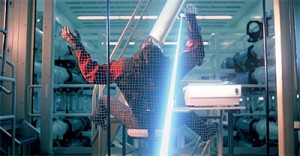 If the vague transporter effects of Star Trek don’t help you visualize this, picture video-gamer “Flynn” (Jeff Bridges) accidentally digitizing himself with a laser and being beamed into the world of Tron—that’s exactly how it works. This principle has since been demonstrated experimentally many times, over distances of as much as 89 miles (I believe the current record), using lasers to send one of a pair of entangled photons through open air.
If the vague transporter effects of Star Trek don’t help you visualize this, picture video-gamer “Flynn” (Jeff Bridges) accidentally digitizing himself with a laser and being beamed into the world of Tron—that’s exactly how it works. This principle has since been demonstrated experimentally many times, over distances of as much as 89 miles (I believe the current record), using lasers to send one of a pair of entangled photons through open air.
What Lloyd showed was that this setup can be modified to send information back in time instead of (or as well as) through space, if one of the two entangled particles is allowed to become fully entangled with that third particle C, breaking its entanglement to the first. As before, as long as particle A and B are entangled, information associated with them is shared; if particle B then an hour later becomes entangled with particle C, the original entanglement between B and A is broken, and information originally associated with the new particle C becomes lost by C but associated with the other “divorced” particle A in the original pair, and in the past—effectively, that “associated” information travels back in time. If I understand this correctly (and I invite more quantum-savvy readers to correct me here), you’d find that that “lost” information from C already was associated with A—you just didn’t notice it or have any way of interpreting it until you performed the operation of entangling B with C, within a setup where the outcome was pre-determined through a process known as “post-selection”—more on that below. (A good, clear explanation of Lloyd’s idea can be found here.)
 Lloyd considers this a way that information and potentially even matter could be teleported into the past. For this, you could perhaps picture Jeff Bridges being digitized by the laser, same as before, but this time materializing ten years earlier inside an old Pong console. (We’d later come to find he’d become ruler of a dull virtual table tennis scenario, and gone mad from the boredom.)
Lloyd considers this a way that information and potentially even matter could be teleported into the past. For this, you could perhaps picture Jeff Bridges being digitized by the laser, same as before, but this time materializing ten years earlier inside an old Pong console. (We’d later come to find he’d become ruler of a dull virtual table tennis scenario, and gone mad from the boredom.)
I think the informational possibilities of this teleportation method are even more exciting than the possibility of beaming physical objects or people into the past, given the concurrent effort to understand the quantum-computer-like properties of the brain. If the brain or its constituent cells can scale up quantum effects by creating systems of entangled particles that are kept coherent over spans of time (that is, protected from jostling with other particles and used to perform calculations, even just over milliseconds or seconds), then information could be sent into the past and extracted by observation/measurement. Precognition, in other words.
The Death of Randomness
Lloyd’s theory takes advantage of the principle that, at a quantum level, information is never lost, but only traded back and forth among particles as a result of their entanglements; future entanglements thus can influence the past.
 This is where, to understand Lloyd’s breakthrough, you need to appreciate a possibly even bigger deal in quantum science, the slow death of the old doctrine that particles behave randomly—the “God playing dice” idea that so offended Einstein. Turns out, a lot of physicists think Einstein was probably right. According to the “two-state vector formalism,” the apparent random behavior of particles is only an effect of our inability to take into account the influences of their future measurements (i.e., interactions with other particles). In other words, particles’ future histories determine how they behave in the present as much as their past histories. “Randomness” is really “noise” from which no signal can be extracted, because we don’t know the properties of the particles that a given measured particle will be associated with in its future.
This is where, to understand Lloyd’s breakthrough, you need to appreciate a possibly even bigger deal in quantum science, the slow death of the old doctrine that particles behave randomly—the “God playing dice” idea that so offended Einstein. Turns out, a lot of physicists think Einstein was probably right. According to the “two-state vector formalism,” the apparent random behavior of particles is only an effect of our inability to take into account the influences of their future measurements (i.e., interactions with other particles). In other words, particles’ future histories determine how they behave in the present as much as their past histories. “Randomness” is really “noise” from which no signal can be extracted, because we don’t know the properties of the particles that a given measured particle will be associated with in its future.
The future is right here, right now, a whole backwards-facing tidal wave of causality that is just as important for dictating nature’s unfolding as its billiard-ball past is; it is just far more obscure.
The special conditions stipulated in Lloyd’s scenario—that is, a quantum computer in which sequestered entangled particles can be carefully re-entangled while subjected to the constraint of post-selection—is the exception to this rule. In such a circumstance, since the endpoint or output of the computation is restricted to a particular result, the meaning of particles’ prior behavior—that is, the information associated with them that was the “result” of a future entanglement—can be extracted in the past, and thus the “future cause” known in advance.
Post-selection means that outcomes must fall within the range of possibility to be allowed; this is what prevents Lloyd’s quantum computer/teleportation scenario from committing the paradoxes associated with time-travel, such as the “grandfather paradox.” The only states that can emerge as outcomes are ones that do not prevent that outcome from occurring, yet a range of paths are permitted to get to that outcome. (One “spooky” feature of particles is their ability to take multiple paths simultaneously to a destination in space, known as a quantum walk; post-selection seems to be sort of a temporal version of this idea, although I have not seen it explained that way.) Some accounts of Lloyd’s theory of time travel even suggest that outrageous twists of fate would arise in some cases to prevent future-cancelling outcomes.
Although post-selection is used in a quantum computing context as a kind of programming choice, Its implications for how we think about reality itself are profound. In a sense, post-selection is just a special application of the larger principle that we live in a possible universe. When applied to the problem of precognition, all post-selection means is that informational time travel must produce a possible outcome and not a contradiction. But we are looking at it wrong in thinking that outrageous measures would be taken by the universe as prophylaxis against paradox; the point is, the information would not have traveled in time in the first place if it caused a contradiction, not because some deus ex machina intervened, but because it wouldn’t be information, just noise whose origin couldn’t be pinpointed.
We are really forced to resort to circular reasoning to describe reality: Things that happened happened, things that didn’t didn’t. The only way to make this seem non-tautological is to parse it out and walk around the loop on foot, seeing only part of the whole at a time. Logic (and perhaps the limits of human understanding, or at least left-hemisphere understanding) requires we we play this game of pretend, which is essentially what mechanistic causality always was. But the basic structure of reality is a “cell” formed by backward-in-time data informing action that either leads to some event which generates the data or is noise, in which case the information we suspected came from a future event didn’t actually emanate from that event or was misinterpreted. It is only precognition if and to the extent that it comes true. This can give you a headache to think about, but it really points to the insufficiency of causality: It’s a social model used to assign responsibility and “blame” for events, but zoom out too far and its fictitiousness becomes apparent.
If all this sounds like an argument for total determinism (or at least, for precognition as precognition of what must occur), it is not. We are really no closer to settling the determinism vs. free will question, because “particle randomness” was never the savior of free will anyway, even when back when we thought God played dice. It seems to me that an essential characteristic of precognition is its non-total, imperfect nature: Psi information is only information to the extent that it can be matched against reality—that is, confirmed—and this probably falls in a gradation or range (or “smear”). There’s no absolutely correct or total psi information because then there wouldn’t be an “outside” to the information, and no way of knowing it even existed; on the other extreme, totally wrong information wouldn’t be information, only noise, and no one would have acted upon it.
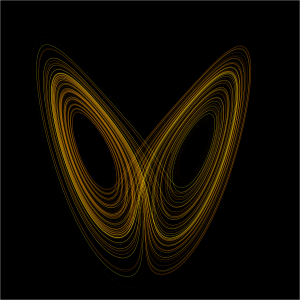 This is what I meant several months ago (in my attack on Jung) by the strange attractor; the strange attractor is between psi information and noise. It is noise to the extent that our knowledge (potential or suspected psi) does not match the future. Noise is one wing of the butterfly. The other wing is when our knowledge (potential psi) does match. In this case, we call it psi. But the point is, there is always a backflow or backwash of proto-information traveling into the past; only within a coherent structure like a quantum computer may it be usable and actionable as information per se, yet precisely the energy invested in heeding the information or using it to orient toward the right answer in the future deviates the right answer, altering the status of the information the psychic received. Frank Herbert keyed in on this when describing Paul Muad’Dib’s precognitive abilities in Dune:
This is what I meant several months ago (in my attack on Jung) by the strange attractor; the strange attractor is between psi information and noise. It is noise to the extent that our knowledge (potential or suspected psi) does not match the future. Noise is one wing of the butterfly. The other wing is when our knowledge (potential psi) does match. In this case, we call it psi. But the point is, there is always a backflow or backwash of proto-information traveling into the past; only within a coherent structure like a quantum computer may it be usable and actionable as information per se, yet precisely the energy invested in heeding the information or using it to orient toward the right answer in the future deviates the right answer, altering the status of the information the psychic received. Frank Herbert keyed in on this when describing Paul Muad’Dib’s precognitive abilities in Dune:
The prescience, he realized, was an illumination that incorporated the limits of what it revealed—at once a source of accuracy and meaningful error. A kind of Heisenberg indeterminacy intervened: the expenditure of energy that revealed what he saw, changed what he saw.
Libet’s Golem
Psi, as Rhine Center parapsychologist James Carpenter argues, is basic to our thinking and functioning, not some superficial add-on “ability” (or as some would have it, “superpower”). Precognition may be a basic function whereby the brain sends information into its own past—or more likely, billions of miniature quantum computers within the brain are sending information into their pasts. Hypothetically, a statistical perturbation in particle behavior (for instance, in those microtubules or the ion channels of synapses) would produce a perturbation in the system at a macro level that stimulates certain associations and not others, in a way that can be minimally trusted by the (classical) associative system as carrying usable information. That minimal trust in one’s future neural connectivity is a function of repetition and habit—we must establish habits or rituals of confirmation (these may be totally unconscious), which build up the psi-system’s trust in future information, which our psi guidance system can then home in on. In other words, habit and expectation create a kind of minimal “post-selection.” (On a conscious level, ritual can serve this purpose in any project of working with psi, such as in precognitive dreamwork.)
Our conscious intent could be unknowingly pulling our meat puppet’s strings from a position dislocated slightly into the future, where the results of the action are already more or less known.
If this is the case, it could be that infant cognitive development amounts to learning to sort out psi signal from noise, and that this involves building up the basic self-trust of “me in a half second,” “me in a few seconds,” and so on that enables precognitive information to be reliably used for basic motor tasks. During our development, we gradually home in on the minimally useful short-term psi signal that enables planning but doesn’t screw things up for us socially, again by building up that structure of self-knowledge and trust in our associative and cognitive habits. Meanwhile, social learning imposes strict limits on overt, conscious expression of precognition, for a wide range of cultural reasons.
Rubbing my temples, I foretell that a future neuroscience of psi will find that something like this interaction between quantum computation involving “closed timelike curves” within neurons and system- or circuit-level associative networks will turn out to be the basic function of the cortex, although it will also depend crucially on subcortical reward regions, as I suggested in a previous post, as these are crucial in reward and the development of habits.
 I also wonder whether our behavior might turn out to have relatively little to do with using information from memory to fashion mental representations and action plans—that that whole story (i.e., cognition as occurring “in the past,” prior to action) may be an inadequate or incomplete picture that needs psi to supplement it. Effective (i.e., skilled, Zen-like) motor action might occur from a place after action, a place that already knows the outcome.
I also wonder whether our behavior might turn out to have relatively little to do with using information from memory to fashion mental representations and action plans—that that whole story (i.e., cognition as occurring “in the past,” prior to action) may be an inadequate or incomplete picture that needs psi to supplement it. Effective (i.e., skilled, Zen-like) motor action might occur from a place after action, a place that already knows the outcome.
I think of this possibility as “Libet’s golem,” because it would be like an ironic, science-fictional perversion of Benjamin Libet’s troubling/awesome discovery that conscious intent follows motor actions by a fifth of a second. It could be this is true because our conscious intent is unknowingly pulling our meat puppet’s strings from a position dislocated slightly (e.g., a fifth of a second) into the future, where the results of the action are already more or less known. This would be especially the case when engaged in a skilled activity, and would account for the slightly dissociated feeling that accompanies intuition and creative or athletic flow states. (Gives a whole new meaning to “be here now.”)
Quantum Promiscuity
This all remains highly speculative … obviously. But regardless of whether Lloyd’s setup or something like it characterizes computing operations in the brain, the significance of the new developments in quantum theory for understanding time and causality itself cannot be overstated, because they provide the necessary context within which precognition will eventually be rendered palatable to the scientific mainstream.
Particles behave like little rock stars or college students in a sex, drugs, and rock ’n’ roll haze, sleeping with a new partner or two each night, swapping clothes, prescriptions, playlists, and cold sores.
For at least a century, scientists have sought to understand the emergence of order within a universe governed by the entropy, our best proxy for time’s arrow, and it has never quite seemed to add up. Again and again, keen thinkers have resorted to invoking some sort of as-yet-unidentified form of retrocausality. In 1919, Paul Kammerer argued for “seriality” as a kind of determination from the future, a convergence on future order. His theory was highly influential on Carl Jung’s theory of synchronicity, which tried to replace causality with meaning as the glue connecting events. Then, within the field of general systems theory, some theorists proposed some sort of countervailing force to entropy that would make sense of the emergence of complex and intricate forms despite the supposedly inexorable tendency toward chaos. Various theories under the umbrella of what Luigi Fantappie called “syntropy,” have proposed that systems gravitate toward future attractors (I highly recommend DiCorpo and Vannini’s recent book Syntropy on this).
The reconsideration of randomness as the omnipresent but impossibly noisy effect of the future on the present comes alongside a major realization about what causes entropy in the first place. The second law of thermodynamics had always been understood and explained as a statistical product of randomness—almost as if math, the law of large numbers, could magically exert a causal effect on a system. Random behavior of particles leads any ordered system to move inexorably toward disorder, an averaging out of differences and thus a loss of information, but randomness does not by itself explain how heat dissipates through a medium and why order tends toward chaos. This is something that Arthur Koestler intuited in his excellent 1972 book on ESP, The Roots of Coincidence: The law of large numbers cannot explain anything—it is a statistical tendency, but math alone is not determinative; statistics don’t cause things to average out. Resorting to tricks of statistics has really been one of science’s fig leafs, when it comes to some of the most basic phenomena in nature at a macro scale.
The reason for entropy, it now turns out—once again, because of Seth Lloyd’s work—is our old friend entanglement: Particles, when they come into contact with each other, take on the properties of their new mates, and simultaneously lose their previous, more distinctive properties. I like to think of this as quantum promiscuity—particles behave like little rock stars or college students in a sex, drugs, and rock ’n’ roll haze, sleeping with a new partner or two each night, swapping clothes, prescriptions, playlists, and cold sores. These attributes diffuse through a community of interacting individuals, resulting in their becoming more and more similar. By the end of their freshman year, all college students are alike—the same clothes, diseases, musical tastes, etc. Same with particles, given enough time. Entropy is just the promiscuity of particles tending to share each others’ attributes.
 Entropy, in other words, is not a loss of information but a sharing and homogenizing of information in the present, sending more distinct information into the past; it is the increasingly complicated nature of particles’ entanglements that produces the “averaging out” behavior seen in thermodynamic systems, making the information purely virtual (or noise). “The arrow of time is an arrow of increasing correlations,” Lloyd says.
Entropy, in other words, is not a loss of information but a sharing and homogenizing of information in the present, sending more distinct information into the past; it is the increasingly complicated nature of particles’ entanglements that produces the “averaging out” behavior seen in thermodynamic systems, making the information purely virtual (or noise). “The arrow of time is an arrow of increasing correlations,” Lloyd says.
So another way of looking at it is this: Lloyd’s model of time-traveling information is an idealized model of what all particles are doing all the time, but in such a haphazard, rapid, out-of-control way that no meaningful information can be extracted from the way they behave when measured, because those future entanglements are unknown to us and there is no known-in-advance endpoint to work back from. Randomness is an illusion caused by particles’ unrestrained future promiscuity and the open-endedness of future time.
The retrocausal effects of quantum entanglement provide an alternative, and most importantly empirically supported mechanism to theories like syntropy and seriality, as well as a more coherent and specific answer to vague “resonance” theories a la Sheldrake and Bohm. Astrobiologist Paul Davies has even argued that this influence of the future behavior of particles, and specifically the principle of post-selection, help explain the arising of life in the universe.
The take-home is this: The future is exerting an omnipresent influence on us, at the most intimate level of the matter and energy constituting us and our world. It is right here, right now, a whole backwards-facing tidal wave of causality that is just as important for dictating nature’s unfolding as its billiard-ball past is; it is just far more obscure. And nature does allow—and Seth Lloyd proved it—for special situations in which little pieces of that massive backwards wave of influence can be used to inform us of events still to come. Since Lloyd’s system requires “perfect” replication of information in the past, on the model of a transporter beam or an error-free computer circuit, the ability to fix the end parameters must be absolute. But human precognition need not be total and perfect, any more than any sensory information is total and perfect. It just needs to be “good enough for government work,” as they say.
In other words, it’s okay if any given Jeff Bridges isn’t replicated perfectly within his boring Pong game, but looks odd or has three arms or two heads. With billions of cells performing similar precognitive calculations, the brain could arrive at an adequate approximation, a “majority report” that is good enough to guide its behavior.
Altered States of Reading (Part 3): A Private Part of Time’s Anatomy
A couple weeks ago, Twitter etc. went wild when a new book revealed allegations that UK Prime Minister David Cameron had, during an initiation ritual while at Oxford, inserted “a private part of his anatomy” in the mouth of a dead pig. To an entire nation, it was a hilariously obvious permutation of Charlie Brooker’s disturbing debut episode of his Black Mirror series four years earlier, which centered on a British Prime Minister being blackmailed to have sex with a pig on live television, focusing specifically on the role of social media in compelling the leader to carry out the deed.
Fear of foresight causes all but the boldest writers to misinterpret their own visionary creative states as pointing to the past (i.e., channeling a muse or spirit, or maybe a past life) instead of what they really are: actually pulling information from their own future timelines.
This kind of thing—not the pig part, but “low culture” (e.g., TV, pulp) writers predicting the future, including future revelations of events that occurred in the past but of which the writer could have had no knowledge—happens all the time. Yet our collective disbelief in anything like precognition causes us to simply have a curious chuckle at these coincidences … maybe be a little “weirded out” (as Brooker said he was) … and then forget them soon afterward. It doesn’t occur to anyone to actually keep a tally. Nevertheless, I feel confident that enterprising grad students in some future department of Precognitive Media Studies will one day go back and scrutinize the whole archive of network TV from its inception, comparing dates teleplays were written with subsequent news headlines, and will turn up some pretty mind-blowing correlations.
In part one of this series, I described such a possibly prescient relationship between the planetary computer Vaal in a 1967 Star Trek episode called “The Apple,” written by science fiction writer Max Ehrlich, and Philip K Dick’s VALIS over a decade later. For various reasons, I suggested this may have been an inadvertent precognitive “plagiarism from the future” on Ehrlich’s part instead of, or in addition to, the usual forward-in-time influence of Ehrlich’s Star Trek episode on Dick’s novel.
Delving into the matter, I found that Ehrlich had not only seemingly anticipated other of Dick’s themes (and book covers), but also seems to have shared Dick’s interest in the paranormal sources of people’s dreams and obsessions. I don’t know much about Ehrlich’s life, but when writers take an interest in such things, it often arises from personal experience or at least some hunch that they themselves are in contact with sources of information that go against the prevailing mechanistic, materialistic worldview (i.e., the creative pattern Jeffrey Kripal described at length in Mutants and Mystics).
Boring Old Reincarnation
“I’ve always wondered why people have always reincarnated from the past. Those few times when I’ve had feelings of remembering another life, it was from the future.” Jacques Vallee
 Ehrlich was specifically interested in reincarnation. He is most famous for his 1973 novel (turned into a 1975 movie) The Reincarnation of Peter Proud, about a young professor inexplicably obsessed with Indians and increasingly troubled by recurring dreams of living another life and being murdered by his wife while taking a swim in a lake. Proud accidentally discovers the real setting of his dreams in a TV broadcast (a motif Ehrlich no doubt precognitively borrowed from Spielberg’s Close Encounters a couple years later); urged by a parapsychologist interested in reincarnation, he travels to the New England town in the TV program to investigate his nightmares and confirm his growing belief that they are indeed memories of a past life in which he was murdered.
Ehrlich was specifically interested in reincarnation. He is most famous for his 1973 novel (turned into a 1975 movie) The Reincarnation of Peter Proud, about a young professor inexplicably obsessed with Indians and increasingly troubled by recurring dreams of living another life and being murdered by his wife while taking a swim in a lake. Proud accidentally discovers the real setting of his dreams in a TV broadcast (a motif Ehrlich no doubt precognitively borrowed from Spielberg’s Close Encounters a couple years later); urged by a parapsychologist interested in reincarnation, he travels to the New England town in the TV program to investigate his nightmares and confirm his growing belief that they are indeed memories of a past life in which he was murdered.
Proud meets and befriends a girl named Ann, the daughter of a man of Indian heritage named Jeff Chapin, who had drowned “accidentally” two weeks before he was born (and when Ann was three months old), and he clandestinely interviews Ann’s mother (and Jeff’s presumptive killer) Marcia. Marcia becomes suspicious of her daughter’s boyfriend’s uncanny similarity to her late husband, which reawakens her own guilty but also hate-filled memories of him; Jeff had drunkenly raped her on their final night together. When Peter then goes for a swim in the same lake … rather stupidly … Marcia takes a boat out and kills him—in other words, duplicating the murder of him when he was her husband, two and a half decades earlier.
It’s a very unsubtle novel, and totally predictable, but its obviousness is kind of what makes it interesting: If you squint, you can almost see it as a PhilDickian story but without Dick’s level of intellectual nuance. Dick grasped that anomalous cognition, what we assume are memories from the past, could just as easily be memories from the future. This inversion of common sense is precisely what made Dick Dick, and in fact we know from his Exegesis that he had read or seen Peter Proud and had exactly that impulse to revise its core idea: “Idea for To Scare the Dead. Dreams, but not about the past as are the dreams in Peter Proud; rather, they are like the dreams about the approaching Spaniards by the Aztecs—visions of the future.”
 In other words, here, as in my suggested relationship of Vaal and VALIS, Ehrlich is clearly a lesser writer grappling with the same phenomena as Dick was (in this case, intimations of his own self haunting him from another time) but interpreting them in a less original, more culturally safe manner. Had Dick or someone with more of his sensibility rewritten Peter Proud, it would be far more interesting as well as parsimonious: We might notice how Proud’s nightmares were precognitive of a TV program, first of all, and perhaps how by automatically (mis)interpreting his visions of drowning as related to the past, Proud’s actions inadvertently elicit or fulfill precisely the tragedy he was actually foreseeing in the future; he’d be killed in order to cover up an old crime that his search had stumbled on.
In other words, here, as in my suggested relationship of Vaal and VALIS, Ehrlich is clearly a lesser writer grappling with the same phenomena as Dick was (in this case, intimations of his own self haunting him from another time) but interpreting them in a less original, more culturally safe manner. Had Dick or someone with more of his sensibility rewritten Peter Proud, it would be far more interesting as well as parsimonious: We might notice how Proud’s nightmares were precognitive of a TV program, first of all, and perhaps how by automatically (mis)interpreting his visions of drowning as related to the past, Proud’s actions inadvertently elicit or fulfill precisely the tragedy he was actually foreseeing in the future; he’d be killed in order to cover up an old crime that his search had stumbled on.
It would be, in other words, exactly like a cross between any number of Dick’s stories (like Minority Report) and Nicolas Roeg’s exquisite 1973 film Don’t Look Now—a tragedy unfolding directly from a skeptic misinterpreting a precognitive vision of his own funeral as a percept in the present.* Interestingly, Ehrlich later continued his reincarnation obsession with a 1979 novel, Reincarnation in Venice, which begins just like Roeg’s movie ends: with a murder on one of Venice’s canals.
 Such a revision presents us, really, with the “unconscious” of Ehrlich’s novel. I’m not saying there was a psi connection in this case, but there is a curious coincidence of names again. What is a “Peter Proud,” after all, but an erection, a filled dick?** Even though his imagination was not up to Dick’s level and thus he wrote about boring old reincarnation instead of actually seeing the future, is it too much a stretch to suppose Ehrlich may have resonated with the time-looping themes Dick was exploring and perhaps with his name as well?
Such a revision presents us, really, with the “unconscious” of Ehrlich’s novel. I’m not saying there was a psi connection in this case, but there is a curious coincidence of names again. What is a “Peter Proud,” after all, but an erection, a filled dick?** Even though his imagination was not up to Dick’s level and thus he wrote about boring old reincarnation instead of actually seeing the future, is it too much a stretch to suppose Ehrlich may have resonated with the time-looping themes Dick was exploring and perhaps with his name as well?
Fear of Foresight
Like many (or all?) time travel narratives, Peter Proud is fundamentally an Oedipal story: The murder that ends the novel comes on the night Peter is expecting to sleep with, essentially, his own daughter Ann; the incestuous tension is not lost on Peter himself, although it doesn’t seem to give him too much pause. In psychoanalysis, the crime for the Oedipal transgression is castration … and what is killing a “Peter” but that?
It often serves our interests to think our fate is out of our hands, and thus any uncertainty about time and what it would mean to have authentic foresight confuses us and scares us.
As I suggested in my “Time’s Taboos” post, it is precisely Oedipus’s confused enjoyment, which “impossibly” connects his future and past, that turns psi into a psychoanalytic problem. The point of the tragedy is not merely that Oedipus committed an ancient version of the “grandfather paradox,” killing his father and marrying his mother; it is that he committed this crime and enjoyed it, and only belatedly discovered what it was that he had been enjoying. Oedipus is thus really a tragedy about disbelieved (and consequently misinterpreted) psi.
I am wondering whether we shouldn’t think of the idea of reincarnation as a kind of defense or denial of the Oedipal situation, a way for people to safely express their baffling precognitive or otherwise paranormal experiences without feeling like they’ve committing the ultimate taboo of ‘traveling’ mentally into the future. Such an idea would raise very interesting possibilities about much “survival” literature that go well beyond a single early 70s paranormal page-turner: What if people’s “past-life memories” are really precognitions of scenes of confirmation that elicit a reward—the reward of a parent, the reward of a researcher, their own reward in being something special? Is reincarnation just an Eastern way of pretending that the thin, gauzy veil of the future is actually a mirror?
Both Oedipus and the idea of haunting discarnate spirits were important themes in the life of probably the most famously prescient of writers, Morgan Robertson, the guy who prophesied the sinking of the Titanic 14 years before it occurred, as well as other events. True to the pattern, Robertson was not only a poor writer (unfortunately, in both senses), but he was also deeply interested in the psychic possibilities of the subconscious mind; he believed when he was writing that he was channeling “some discarnate soul, some spirit entity with literary ability, denied physical expression…” Intrigued by his prophetic gift and by the unfortunate circumstances of his sad life and career, the parapsychologist and psychiatrist Jule Eisenbud delved into Robertson’s stories and novels in search of clues to his character. His essay “Chance and Necessity: Is There a Merciful God in the House?” in his 1982 book Paranormal Foreknowledge is an utterly fascinating exercise in psi-criticism.
 According to Eisenbud, who took the time to read an impressive chunk of Robertson’s pretty unreadable-sounding body of work, his hyper-masculine protagonists on the high seas invariably pine for mother figures they are fated never to possess, while they rail against the inscrutability of fate. The iceberg that sinks the “Titan” in Robertson’s most famous work Futility is just one example of cruel destiny that Robertson’s protagonists are unable to avoid, except occasionally in the depths of drink or, in a few very interesting cases, through an uncanny sixth sense. The protagonists are pretty clearly self-portraits.
According to Eisenbud, who took the time to read an impressive chunk of Robertson’s pretty unreadable-sounding body of work, his hyper-masculine protagonists on the high seas invariably pine for mother figures they are fated never to possess, while they rail against the inscrutability of fate. The iceberg that sinks the “Titan” in Robertson’s most famous work Futility is just one example of cruel destiny that Robertson’s protagonists are unable to avoid, except occasionally in the depths of drink or, in a few very interesting cases, through an uncanny sixth sense. The protagonists are pretty clearly self-portraits.
Several friends (writing in a 1915 volume called Morgan Robertson, The Man) confirmed the writer’s psychic gifts, although oddly enough, none of them ever mentioned his most uncanny prophecy about the Titanic, nowadays his only claim to fame. (Eisenbud assumes this lacuna is probably because such mention would have seemed in bad taste, just three years following the disaster.) Eisenbud links Robertson’s prophetic habit directly to his tortured obsession with destiny and the question of man’s ability to change it—a question seemingly tied to his drinking problem, the “iceberg” in his life that he couldn’t escape no matter how hard he tried. Very sadly, drink left him, in his early fifties, a destitute and forgotten failure in his own eyes. He died at age 54; he was found, oddly enough, standing up, leaning against a bureau in a hotel room.
Having observed precognitive and other psi phenomena throughout his clinical work, Eisenbud identified a specific pattern of individuals expressing precognitive ability as part of a gambit either to subvert apparent destiny or to camouflage themselves within it to allay their guilt. Eisenbud specifically compares Robertson to a married clergyman patient of his who produced uncanny precognitive dreams as part of a defense against his homosexuality. There are hints in Robertson’s stories too of an (at the time) unspeakable sexual orientation that may have driven him unconsciously to choose a life of the sea for several years but write of it as though it were a kind of grim fate he could not avoid: The world of his fiction is a sweaty fantasy of manly seamen pressed into service, constantly bloodying each other in brutal fistfights, etc. Robertson seemed to want fate to absolve him of something that he feared was a choice … and vice versa. His precognition, Eisenbud argues, answered this need.
Eisenbud makes a very key observation that goes well beyond Robertson in its implications: “With such an ambivalent attitude toward fate, all one would need, it might seem, would be heads and tails on the same throw. But any good precognitive event provides just this, since … the metaphysical significance of such an occurrence is sufficiently in question to satisfy both schools.” Had Robertson been born a few decades later, he might have fastened on Jung and the similarly ambivalent concept of synchronicity, to satisfy the same need. I’ve argued elsewhere that synchronicity is ultimately an empty concept, a kind of security blanket that absolves us of the responsibility to actually engage with our foresight and confront its implications. But some kind of security blanket about fate may be something we all need, in one way or another, because we are all at least a bit ambivalent about the whole question of fate.
While we might think we want to know the future, so we can change it, for example, most of the time we really do not want that responsibility. It often serves our interests to think our fate is out of our hands, and thus any uncertainty about time and what it would mean to have authentic foresight confuses us and scares us. Does seeing the future doom us or “lock it in” in some way? … Or does a vision of the future make it radically open to alteration and force us to take responsibility? Precognition is the ultimate can of worms that is best left unopened, which is why it is almost always only expressed unconsciously and inadvertently, either in the course of skilled activities where we are blind to it, or occasionally as parapraxes or creative inspirations whose source we misidentify and whose true prescience largely eludes us.
Fear of foresight thus causes all but the boldest writers to misinterpret their own visionary creative states as pointing to the past (i.e., channeling a muse or spirit, or maybe a past life) instead of what they really are: actually pulling information from their own future timelines. Dick, almost alone among genre writers, was not afraid of the latter possibility.
Is a Cigar Ever Just a Cigar?
Despite the various cultural and psychological forces acting to divert our attention from psi, I anticipate that in our lifetimes, we will see it acknowledged, specifically as precognition, facilitated by the discovery that the brain is a quantum computer continually accessing information in its own future as well “repressing” unwanted data into its own past. The physics of information that Jacques Vallee called for, governing our weird relation to time, will turn out to be none other than the hyper-associative logic of the personal unconscious and memory, just as it is formed and revealed in dreaming, the nightly updating of the search system we use to find and index this atemporal data. Dreams are not “wish fulfillments” as Freud thought, but Freud was exactly right in identifying their utterly associative, illogical character; although I don’t think he saw the link with Freud, Vallee called it a “metalogic,” which is a good term.
In the future, Christ on the Cross may be replaced by the 53-year-old Dick sprawled unconscious on the floor next to his coffee table, a martyr to the new religion of psi.
In the metalogic of our brain’s mostly unconscious search system, puns (both verbal and visual) are probably the most characteristic form of coincidence, forming the nuclei of attractor phenomena in the symptom space of psi. This is not the Jungian world of noble and poetic archetypes, but a cringingly personal world of low humor and wordplay. In such a world, there’s a lot in a name … particularly one as suggestive as Phil Dick’s.
I don’t know if I’m the first to suggest this, but I think Dick occupies a unique, special place at the juncture between the linear-causal classical worldview and the psi-dominated landscape of the future in part because of the accident of his name. The associative networks in the brains of readers (and in his own brain) unconsciously will have made a special place for him because his name happens to be that of the Phallus. In Lacanian theory, the Phallus is the virtual/absent emblem of the Real, the black hole around which the whole symbolic order revolves, producing in its vicinity all the apparent and actual time distortions that black holes in space can generate. The Phallus is the empty signifier that radically warps the spacetime of jouissance.
 In other words, Dick was a living pun, and he acted and increasingly acts in our culture as a symbolic-associative attractor: His influence continues to grow posthumously, and it may even be that history converges more and more on his writings, increasing their prophecy quotient, precisely because of this associative attracting power. It is Dick’s prophetic-ness that made him famous, and it is his fame that made him prophetic, in a feedback-loop. Genius, I am convinced, is nothing other than prophecy, the ability to strongly channel one’s own future.
In other words, Dick was a living pun, and he acted and increasingly acts in our culture as a symbolic-associative attractor: His influence continues to grow posthumously, and it may even be that history converges more and more on his writings, increasing their prophecy quotient, precisely because of this associative attracting power. It is Dick’s prophetic-ness that made him famous, and it is his fame that made him prophetic, in a feedback-loop. Genius, I am convinced, is nothing other than prophecy, the ability to strongly channel one’s own future.
This kind of Bohmian resonance is responsible for the very shape of culture, I think: a kind of “cellular” relationship between precognition and confirmation (or the Not Yet and the Actual). This cellular structure happens to be most visibly apparent when psi leaves a rich paper trail, as it does with frenetic, amphetamine-fueled (or alcohol-fueled, in Robertson’s case) genre writers. Occasionally their more respected “literary” cousins also tap into it, as Thomas Pynchon did when he made a “precognitive dick” the MacGuffin in his highly prescient (prescient about prescience) Gravity’s Rainbow. Because most of us mortals cannot accept or even imagine that we are ever seeing the future, however, we contort all our anomalous experiences to conform to commonsense linear causality, and our confusion results in various anomalous events that we generally manage to forget as soon as they happen.
Dick saw through culture’s psi-distorting linear-causal mystification; and it is significant that, not unlike “Peter Proud” in the above retelling, Dick’s untimely demise was a punishment for his offense, which (not unlike Oedipus) was a kind of self-enjoyment, prophetic jouissance.*** In the future, Christ on the Cross may be replaced by the 53-year-old Dick sprawled unconscious on the floor next to his coffee table—an image Dick himself foresaw. His untimely, confusedly foreseen death was a kind of martyrdom, fulfilling his destiny to be the absent signifier, the ultimate “vanishing mediator” preparing the way for a new religion of psi.
NOTES
* Nic Roeg is another rare artist of the period, besides Dick, who really confronted the issue of misrecognized precognition and overlapping time. It is present also in The Man Who Fell to Earth, a film that strongly influenced Dick’s VALIS but may have been influenced by VALIS in turn, precognitively: How else to explain the “alien” Thomas Jerome Newton’s brief vision of the pioneer family and their simultaneous, UFO-like vision of him—which is exactly like Dick’s/Horselover Fat’s superimposed ancient Rome, not to mention Dick’s own experiences of remembering seeing his future self visit himself in dreams. Roeg is subtly suggesting here that Newton is not actually a space traveler from another planet (the mundane, “nuts and bolts” assumption of the Walter Tevis novel the movie is based on) but is actually a time traveler from Earth’s thirsty, desiccated future. The story thus becomes one of Oedipal nostalgia—retreating into the past and staying there, descending into alcoholism, instead of going back to the future, where he came from. Alcohol (a stand-in for the breast) and Oedipus are a common convergence. It is also notable that Newton has no genitalia.
** Whether influenced in any way by Dick, Ehrlich was clearly highly conscious of his naming of his protagonist Peter Proud: The obscenely engorged member of Jeff Chapin before the rape is a vision that his widow cannot clear from her mind. The young Peter is like her own guilt as well as her own enjoyment come back to haunt her, the return of her repressed; Ehrlich makes it clear that Marcia’s guilt is as much over having enjoyed the rape as over the murder itself. Basically, Ehrlich whacks you over the head with the fact that Peter is a phallic symbol.
*** We usually say the punishment fits the crime, but in a Dickian universe the crime also fits the punishment: Dick died from multiple strokes; in other words, castration as punishment for masturbation. Don’t laugh—it could happen to you.
Altered States of Reading (Part 2): Pynchon and the Psi Reflex
Thomas Pynchon’s sprawling unfinished 1972 novel Gravity’s Rainbow centers on an American army lieutenant, Tyrone Slothrop, whose amorous conquests around WWII London infallibly predict German V2 rocket strikes in an otherwise random distribution throughout the city. Slothrop’s weird ability puts him under the scrutiny of “Psi Section”—a division of military intelligence—who link his strange gift to Pavlovian conditioning he experienced as an infant in the laboratory of a legendary mad-genius professor, Dr. Laszlo Jamf.
One of the unwritten rules of literary fiction has always been: Thou shalt not use ESP seriously as a plot device.
Over two decades earlier, Jamf had (it is suggested) used the infant Slothrop’s erections as the “target reflex” tied to an unspecified conditioned stimulus “X.” If not reinforced, conditioned responses (like having an erection when presented with whatever X is) tend to diminish or “extinguish”—albeit often not completely. However, a theoretical possibility suggested by Pavlov in a letter to Pierre Janet is that the conditioned response could extinguish more than completely, or “beyond the zero.” The idea in the novel is that Slothrop’s adult sexual response is the result of his infant conditioning extinguishing beyond totality and into a mysterious negative “transmarginal” realm, and this is the object of much speculation in the 760-plus pages of the novel.
I call Gravity’s Rainbow “unfinished” because no one who starts the novel ever gets to the end. What starts out as fascinatingly crazy becomes boringly crazy about half the way through, and the reader’s interest, so to speak, detumesces. Revisiting the book recently, however, I confirmed what I had already suspected, which is that the secret of Slothrop’s condition(ing)—the mysterious X—remains unanswered all the way through to an increasingly ambiguous outcome, in which the character descends into madness, and even the circumstances of his childhood—including the very existence of Dr. Jamf—are called into question.
This is to be expected: One of the unwritten rules of literary fiction has always been: Thou shalt not use ESP seriously as a plot device. Writers breaking this rule quickly get relegated to the ghetto of SF, which up through Phil Dick’s day remained very much a “trash stratum.” The genre gods exist to serve the dominant mechanistic paradigm. Pynchon scrupulously avoided Dick’s fate by keeping the real nature of Tyrone Slothrop’s “gift” ambiguous, and surrounding that character with materialists (e.g., Dr. Pointsman) bent on explaining it away rationally.
 Yet Pynchon clearly had a genuine fascination with parapsychology—he also wove PK experiments into his previous, much shorter novel, The Crying of Lot 49—so his ambivalence produced a kind of literary neurosis: Without descending into tepid realism, the only acceptable literary alternative is to postpone the answer, and keep postponing, in an endless spiral. The result is the kind of wordy symptom always produced by inability to be rid of a fascinating-yet-repellant remnant of the Real: A profusion of words and ideas that circle endlessly the void at its heart. (This unwillingness to accept or acknowledge the paranormal implications of the Real also accounts, I believe, for Slavoj Žižek’s descent into frenetic wordy repetition over the course of his career, but that’s another story.)
Yet Pynchon clearly had a genuine fascination with parapsychology—he also wove PK experiments into his previous, much shorter novel, The Crying of Lot 49—so his ambivalence produced a kind of literary neurosis: Without descending into tepid realism, the only acceptable literary alternative is to postpone the answer, and keep postponing, in an endless spiral. The result is the kind of wordy symptom always produced by inability to be rid of a fascinating-yet-repellant remnant of the Real: A profusion of words and ideas that circle endlessly the void at its heart. (This unwillingness to accept or acknowledge the paranormal implications of the Real also accounts, I believe, for Slavoj Žižek’s descent into frenetic wordy repetition over the course of his career, but that’s another story.)
Yet neuroses can create a secure terrarium environment in which prophetic jouissance can sprout and even bear very interesting fruit; somehow Pynchon managed to quite uncannily precognize (or at least, anticipate) some of the most interesting modern developments in a theory of psi, which partly emerged from research conducted in the 1970s in California at Stanford Research Institute (SRI).
Standing at Attention
For example, at SRI and in his time on the Star Gate program, physicist Edwin May noticed that when remote-viewing targets somehow involved high-energy discharges like nuclear tests, electromagnetic pulses, or rocket launches, the viewers were almost always dead on—much more accurate than with other targets. As a result, May has theorized that psi either orients toward, or is actually carried by, signals of extreme entropy change, things moving rapidly from a state of order to a state of disorder. May has also argued that, even when it seems to take other forms, psi is always basically precognition.
The behaviors that become associated with presentiment in adulthood may be culturally conditioned reflexes associated specifically with the repression of our psi functioning during the first few years of life.
The idea that psi is linked to entropy gradients could, May suggests, find some theoretical rationale in classical physics, where time itself is often understood as tantamount to the inexorable increase in entropy dictated by the second law of thermodynamics. Interestingly, in The Crying of Lot 49, Pynchon had already homed in on the key entropy-vs.-information aspect of psi with his “Nefastis Machine,” a perpetual motion device whereby “sensitives” raise the internal temperature of a box and move a piston inside by focusing their attention on a picture of physicist James Clerk Maxwell affixed to its side. But the linkage of Slothrop’s premonitory organ to V2 strikes—which, because the rockets are supersonic, actually precede any audible warning—is a purer (and really, genius) expression of this linkage.
May clearly has hit on something important about psi. I’ve noticed that my most uncanny precognitive dreams and other premonitory experiences usually involve an entropy gradient of some sort, such as deaths, landslides, rocket launches and mishaps, explosions and fires, and breakages of household items. My life isn’t actually very exciting, fortunately, so more often than not I seem to be keying in on news reports of these events, or their signs and traces, not the events themselves (except for the breakages). This leads me to think that our unconscious preferentially attends to information about entropy gradients, whatever sensory channel we get it from, because it is relevant to our survival, and thus is part of a primitive threat-vigilance orientation.
In other words, I doubt the actual psi signal is somehow carried from the future via entropy or changes in entropy; in terms of May’s “multiphasic theory,” this would mean entropy gradients belong to what he calls the neuroscience domain, not the physics domain. (I discuss this question in the current issue of EdgeScience magazine as it applies to 9/11.) Recent advances in quantum computing provide a plausible (albeit still hypothetical) mechanism for how the brain could exchange information with itself through time, which I will discuss in a future post.
Pynchon was also prescient in linking psi to the most unconsciously willed of reflexes, the sexual response. Another big advance in parapsychology in recent years is the “first sight” theory of James Carpenter, a clinician and researcher at the Rhine Center in North Carolina, who assigns psi to the unconscious/preconscious realm as part of our basic adaptive mechanisms. Carpenter describes psi as the “leading edge” in our perception, and underscores how it operates in tandem with PK as really the root and basis of our engagement with the world. Carpenter doesn’t link it to sex per se, but his theory makes good sense of why psi seems to manifest itself most clearly in rewarding flow states and skilled engagement, a kind of enjoyment for which Slothrop’s compulsive amorous activity is a perfect metaphor.
 As argued in the previous post, it may not be accidental that the most prophetic writers have also been the most frenetic, churning out creative material at a rapid pace in order to bring in a meager income—which suggests that they (a) love it and (b) don’t have any better job prospects and (c) cannot be thinking too much about what they are doing. (An extreme form of this principle is automatic writing—or in our day, automatic typing—which is an exercise that can produce very interesting unconscious and precognitive material.) Again, this would link precognition specifically to the reward system of the mesolimbic areas of the brain, and to the neurotransmitter dopamine, which is released in these areas precisely to entrain our attention and activity on “the next thing,” whether threatening or rewarding.
As argued in the previous post, it may not be accidental that the most prophetic writers have also been the most frenetic, churning out creative material at a rapid pace in order to bring in a meager income—which suggests that they (a) love it and (b) don’t have any better job prospects and (c) cannot be thinking too much about what they are doing. (An extreme form of this principle is automatic writing—or in our day, automatic typing—which is an exercise that can produce very interesting unconscious and precognitive material.) Again, this would link precognition specifically to the reward system of the mesolimbic areas of the brain, and to the neurotransmitter dopamine, which is released in these areas precisely to entrain our attention and activity on “the next thing,” whether threatening or rewarding.
Dopaminergic circuits are also involved in Pavlovian conditioning—the substitution of new behaviors and stimuli for more basic rewarding or aversive behaviors. As may have been the case with Tyrone Slothrop, the behaviors that become associated with presentiment in adulthood may be culturally conditioned reflexes associated specifically with the repression of our psi functioning during the first few years of life, when normal socialization (parental reward) compels us to be linear and reasonable in our thinking. Psi is both driven into the unconscious and possibly also somatized, leading to the hypothesis that many “hysterical” physical symptoms such as those Freud investigated in his patients could actually be precognitive signals that lack more straightforward expression. More generally, such signals could take the form of the completely nonverbal and non-verbalizable behavioral complexes that psychoanalyst Christopher Bollas called the “unthought known.”
Feed Your Psi Dolphin
Thus we shouldn’t associate “prophecy” solely with intellectual work and creative achievements like books or art or dreams; and it also isn’t remarkable or rare. Paranormal foreknowledge manifests unconsciously, unintendedly, and constantly in our lives, but often in ways we don’t want or intend, and almost always it gets lost in the chaos and noise. We are most in tune with it, though, whenever we are engaged in whatever skilled activity we are best at and most enjoy—whatever puts us in that Zen flow state that shuts down the critical mind. In Slothrop’s case, that is sexual seduction, but skilled physical activities of all kinds may be a fertile ground to look for psi. Esalen founder Michael Murphy wrote of transcendental and psychic experience in sports (including golf), and my guess is that it is in sports and martial arts that the most consistent and constant psi manifestations probably occur, yet we are not likely to become aware of them because these activities do not usually leave a paper trail. Athletes and fighters are generally not served by reflecting analytically or intellectually about what they are doing, the way writers are.
Precognition may not be seeing the future or knowing the future or even feeling the future, but instead producing a behavior that is tied to a forthcoming reward.
Acting, singing, playing a musical instrument, and other kinds of performances, when likewise engaged in with skill and complete immersion, are probably similarly conducive to psi. In the ancient world, prophecy manifested in song, for example, and this could help explain much of the psychic aspect of modern spiritualism and shamanism, as well as the overlap between genuine psi phenomena and stage magic, another highly skilled and semi-high-stakes activity that ought to take the critical left hemisphere offline temporarily. “Mixed mediumship” is the term for the oft-noted admixture of possibly real psi phenomena with stage trickery; Uri Geller, who impressed nearly all scientists who actually worked with him that his talents were genuine, nevertheless also used trickery in stage perfomances, which made it easy for pseudoskeptics like James Randi to call him a fraud.* SRI physicist Russell Targ reported to Jeffrey Kripal (Authors of the Impossible) that he received what he thought was real telepathic information while performing stage magic. It may not matter what the activity is, simply performing skilfully some behavior that consumes the left hemisphere’s attention, ideally with some physical component, seems to open the psi channel.**
There is also aviation, an occupation with notorious links to psi ability. As in athleticism or stage magic, piloting an aircraft requires senses attuned and alert, and puts the pilot in a thrilling, highly connected flow state. Flying also embodies and expresses precisely the bird’s-eye psychic view associated with threat vigilance. Examples of aviators claiming psychic phenomena are myriad—Amelia Earhart is reported to have used ESP to locate missing aircraft, for example. Some psychic aviators, fortunately, have taken up writing. One of the more naturally gifted psychics studied at SRI, for instance, was Richard Bach, pilot and author of Jonathan Livingston Seagull, who came to the attention of Targ and Hal Puthoff because that novel clearly indicated an experience with out-of-body travel, a common factor in the lives of the most gifted psychics (including Ingo Swann, Pat Price, and Joe McMoneagle).***
 My point here is this: Because psi is best expressed as an unconscious reflex, it may be possible to adopt an ultra-reductive, behaviorist, even Pavlovian way of thinking about the problem, just as Pynchon does: Precognition may not be seeing the future or knowing the future or even feeling the future, but instead producing a behavior (it could be a dream, or a physical response, or an utterance, or a drawing, or a story) that is tied to a forthcoming reward. A premonition or hunch that pays off in a confirmatory action is part of a reward loop, entraining—literally, training, as in conditioning—the attentional faculty on future information. It may be that practices of skilled engagement ranging from aviation to stage magic to frenetic writing for the pulps not only open the door to psi by focusing the senses and occupying the critical, conscious mind but also simply condition the psi apparatus through providing constant rewards or payoffs that, via the magic of dopamine, propel us forward to the next reward in an ongoing chain—like feeding sardines to your psi dolphin.
My point here is this: Because psi is best expressed as an unconscious reflex, it may be possible to adopt an ultra-reductive, behaviorist, even Pavlovian way of thinking about the problem, just as Pynchon does: Precognition may not be seeing the future or knowing the future or even feeling the future, but instead producing a behavior (it could be a dream, or a physical response, or an utterance, or a drawing, or a story) that is tied to a forthcoming reward. A premonition or hunch that pays off in a confirmatory action is part of a reward loop, entraining—literally, training, as in conditioning—the attentional faculty on future information. It may be that practices of skilled engagement ranging from aviation to stage magic to frenetic writing for the pulps not only open the door to psi by focusing the senses and occupying the critical, conscious mind but also simply condition the psi apparatus through providing constant rewards or payoffs that, via the magic of dopamine, propel us forward to the next reward in an ongoing chain—like feeding sardines to your psi dolphin.
Completing the loop with a confirmation, providing those payoffs, is key. Psi needs to be seen as one half of a dual system, the other half being our everyday actions and perceptions that serve to confirm—or not—our unconscious presentimental instincts or conscious precognitive hunches. (Elsewhere I’ve suggested that psi specifically trades in probabilities coexisting in a state of superposition prior to confirmation through physical measurement—a quantum version of this idea.) The result is, I believe, a literal form of what Alfred Korzybski called time binding: reaching forward into the future and drawing ourselves toward those confirmatory nodes, those confluences where our psi is “judged” against a real state of affairs. Social time has a “cellular” structure, built around these bound symptom-loops of psi and jouissance. And creative writers, who are unknowingly copying from their own dimly intuited future works and those of other writers, are conveniently adumbrating for us, like a gravestone rubbing, this basic time-binding structure humans and all social animals, and probably even all living things (even bacteria) are engaged in.
Unfortunately, as a culture and probably as a species, we are deeply fearful of prophecy, and thus engage in elaborate mental gymnastics to disguise the living future as something else—which will be the subject of the next installment.
NOTES:
* One personality trait typical of psychics (as well as performers) is extroversion, although in some cases histrionic might better describe it: a high emotionality and attention-neediness. There may be a link between need for external validation and the emergence of psi abilities in childhood, which the trajectory of someone like Geller, or probably any number of lesser-known spiritualist mediums, shows. The extroversion of psychics (and their sometimes frustrating lack of critical thinking about what they are doing) may contribute to the overall scientific distrust of psychic displays. Scientists are mentally rigorous (and often, pretty dull) people, after all, and no matter how compelling a bit of mind reading or spoon bending might seem to a layperson, scientists are likely to be biased against most such displays because they are, quite simply, cheesy, obviously calculated to get attention.
** Given its link to spontaneous and even frenetic engagement, I would hypothesize that some of the most talented psychics—probably unknowingly—would be improv actors. Improv is a very Zen activity that rewards not thinking, just doing, and probably generates prescient scenes that may also capitalize on the group effects known to facilitate psi. Some enterprising young parapsychologist (if young parapsychologists exist) ought to systematically record improv performances and compare them to news headlines over the following two days. My hunch is this would produce extremely interesting results.
In an improv course, one is taught to follow a single overriding rule summarized as “yes, and…” (or “yes, let’s…”). To support their team members (it is thought of as a sport, not comedy) and learn to count on their support, improv performers adopt the constant attitude of total agreement with the reality already constructed on stage and contribute by adding something new that does not undo or contradict it. The result can be highly exhilarating and surprising. This habit of saying yes and honoring the world already created in an unfolding open-ended performance very much resembles the ritual of honoring psi successes I wrote about in my article on “yes-saying” in psi, and probably also can connect psi to the efficacy of “new thought” systems of positive thinking. The point is not just having a sunny positive attitude and expecting your wishes to change the world; the point is building an expectation that positive results will be honored in the future, which entrains the unconscious mind toward those outcomes. You are essentially building a habit of rewarding positive outcomes into your life, which, if you are interested in psi, coaxes unconscious psi abilities into the light of day like a shy animal.
*** Martin Caidin, a WWII bomber pilot who became a prolific writer of sci-fi techno thrillers in the 60s—including the novel Cyborg, on which the TV show The Six Million Dollar Man was based—believed himself to have psi (specifically PK) abilities and also famously wrote the novel Marooned in 1964, about a space capsule malfunction in orbit; to coincide with a movie version in 1968, he revised the plot to center on an Apollo mission requiring help from ground control and a daring rescue mission. I have not read his novel, but it is supposed to have uncannily prefigured the Apollo 13 disaster two years later. A reader sent me an article on an additional fascinating ‘synchronistic’ angle to this story: One of the NASA engineers helping solve the problem reported that a creative solution for recharging the crippled capsule’s battery came to him as a result of coincidentally seeing the film version of Marooned on the very evening he got the call about the real crisis unfolding in space.

Altered States of Reading (Part 1): VALIS, Vallee, and Vaal
Where to begin when the story is a loop?
I have been mulling over a particularly rich and thought provoking entry from Jacques Vallee’s journals (Forbidden Science, Volume Two), about a synchronistic walk he took one day in October, 1973 with Hal Puthoff, head of the Stanford Research Institute program researching ESP. Vallee was telling his companion he thought the UFO problem and parapsychology were connected and that they were both more than scientific questions but also Hermetic quests or initiations, “an enigma like that of the Sphinx” … at which point, the two men turned a corner and found themselves face to face with a pair of sphinxes behind barbed wire. Vallee writes with amusement that “[Puthoff] must have thought I had known about the statues all along and had maneuvered him to the spot deliberately.”
We live in a vast precognitive soup, and at least some artists seem to draw not only from past influences but also from their own future timelines, precognizing their own books they have yet to write as well as books by others they have yet to read.
Vallee interprets such synchronicities as what he calls “intersigns,” connected to his notion of a higher multidimensional controlling agency—the idea he had been developing into his “control system” hypothesis. This hypothesis was the theme of his latest book manuscript, The Invisible College, which he had just finished drafting a couple months prior to this walk but which would not be published for over a year, in 1975. Vallee also makes the following comment, which is what made me do a double take: “I felt elated: Perhaps we were beginning to get the bigger picture. Shades of Philip Dick and VALIS! It’s not about extraterrestrials visiting our planet, I thought. It’s much bigger than that.”
This passage struck me as odd because of its timing. VALIS, the novel, did not come out until 1980, and even the mystical/paranormal experiences it was based on did not begin occurring to Dick until early 1974, a few months after Vallee’s walk with Puthoff. Moreover, the acronym VALIS (for “Vast Active Living Intelligence System”) did not emerge fully formed until after Dick’s most intense experiences; in his journals, Dick initially called the entity or extraterrestrial satellite beaming him information and commands “Zebra.” How then did a reference to VALIS get into a 1973 journal entry?
Although it is odd, I don’t think it’s too great a mystery, nor a case of precognition. Vallee also cited Dick’s “Vast Alive [sic] Living Intelligence System” as a literary version of his own postulated intelligent control system in the epilogue to the first volume of his journals, Forbidden Science, Volume One, covering the 1960s, although not published until the early 1990s. There, it is clear that the epilogue was written well in hindsight; in light of this, it seems that the October 1973 entry was thus probably also emended at some point much later, prior to being prepared for publication, and thus is not a case of actual literary prophecy. [Edit 9/8/15: Jacques Vallee let me know, via Patrick Huyghe of Anomalist Press, that the PKD comment was included erroneously when compiling his journals and notes for publication, and it has already been corrected in newer editions of the book.] But it spurred me to wonder about the uncanny resemblance of Vallee’s themes in Invisible College and the themes that Dick was struggling with in his life and fiction right during the period that Vallee was developing his control system concept.
 The similarity of Vallee’s most famous theory and Dick’s most famous literary creation are rather uncanny, if you think about it: Both postulate a higher, probably ancient intelligence somehow manipulating and controlling human society and evolution via select individuals receiving psychic communications and stage-managed “impossible” synchronicities. Once Vallee read Dick’s VALIS, it certainly made an impression on him—how could it not? Clearly a literary genius had independently arrived at some of the same ideas he himself had been developing, and the fiction writer had honestly asked the same questions he had; both writers avoided settling on a final answer as to who is actually behind this control system yet flirted with various possibilities ranging from all-too-human mind control to multidimensional beings. In other words, not only were the hypotheses similar, but so was the spirit of inquiry—skeptical, in the best sense. Given Dick’s long delay in publishing his closely autobiographical account of his 1974 experience, Vallee likely would not have known, unless he was totally steeped in Dick lore, that they had actually been attacking these problems practically simultaneously.
The similarity of Vallee’s most famous theory and Dick’s most famous literary creation are rather uncanny, if you think about it: Both postulate a higher, probably ancient intelligence somehow manipulating and controlling human society and evolution via select individuals receiving psychic communications and stage-managed “impossible” synchronicities. Once Vallee read Dick’s VALIS, it certainly made an impression on him—how could it not? Clearly a literary genius had independently arrived at some of the same ideas he himself had been developing, and the fiction writer had honestly asked the same questions he had; both writers avoided settling on a final answer as to who is actually behind this control system yet flirted with various possibilities ranging from all-too-human mind control to multidimensional beings. In other words, not only were the hypotheses similar, but so was the spirit of inquiry—skeptical, in the best sense. Given Dick’s long delay in publishing his closely autobiographical account of his 1974 experience, Vallee likely would not have known, unless he was totally steeped in Dick lore, that they had actually been attacking these problems practically simultaneously.
Were their ideas really independent?
A possible “source” we are forced to consider for Dick’s VALIS is of course Vallee himself. As early as 1974, in the aftermath of his 2-3-74 “Zebra” experiences, Dick began work on a novel that clearly had the germ of the idea, or name, of VALIS, but which he was then calling Valisystem A, and which would eventually become the posthumously published novel Radio Free Albemuth. Isn’t “Valisystem” an awful lot like Vallee System … as in Vallee Control System? Given the similarity of the two authors’ ideas, a connection between Dick’s idea and Vallee’s idea (and his name) seems likely to me; yet it is also, as near as I can tell, temporally “impossible.”
Vallee first drafted Invisible College in the span of two month in the summer of 1973, but he only finalized and edited it late the following year, to appear in 1975, months after Dick had begun referring in his journals and letters to a manuscript tentatively called Valisystem A. I have been unable to find the concept of a control system developed in any published work of Vallee that Dick could have read at that point; neither the phrase “control system” nor, really, the idea of such a system—at least in any developed form—appear in Vallee’s previous book, Passport to Magonia (although there is the possibility that Vallee may have mentioned such an idea in an interview or article—I invite readers who may know of something like that to let me know in comments).
There is also no indication in anything I have read on Dick, including Lawrence Sutin’s and Anthony Peake’s biographies, that he had had any contact with Vallee, although they would have overlapped in the Bay Area in the early 1970s, prior to Dick’s move south to Orange County in 1972. More tellingly, Vallee makes no mention of having ever met Dick—and it definitely seems like something he would have mentioned in his journals, given that his journals are a parade of other interesting writers and counterculture figures from that time and place. Dick never mentions reading any Vallee later on either, although this doesn’t say much, as Dick read widely (and absorbed ideas through many channels) and didn’t always leave any record of what he was reading. (Again, if any readers know differently, please let me know!)
Given Dick’s reputation for precognition, I think the coincidence of two control systems, being theorized and developed contemporaneously, so similar in name, suggests a possible psi-literary correspondence.
A Map of Precognitive Misreading
The obvious psi channel to consider would be telepathy, but for various reasons I am increasingly convinced that the main, or possibly only, true psi channel—even when it seems like mind-to-mind contact—is precognition. When we seem in touch with another person across space, there is no way to rule out that we are not actually precognizing the future moment (whether imminent or more distant) when the “true connection” is revealed or confirmed. If psi is based on a kind of “morphic resonance” of quantum brain states, it seems far more likely or common for our own brain states to resonate across time than for two different brains to resonate with each other, even if the latter is theoretically possible. In other words, telepathic connection may be miscrecognized precognition of a future real-world connection.
Among literary types, precognition seems to uniquely characterize frenetic genre writers, people compelled to bust their asses in the “trash stratum” just to make ends meet.
Dick has been called prophetic, like many other sci-fi writers. But he has also been called precognitive, as so many of his stories and personal experiences suggest genuine psi sensitivity. Besides the uncanny precognitive events in his personal life in the aftermath of his 2-3-74 experience, such as correctly divining the presence of a life-threatening inguinal hernia in his infant son while listening to the Beatles’ “Strawberry Fields,” Dick uncannily precognized numerous developments in our culture. My favorite of his novels, The Three Stigmata of Palmer Eldritch, not only seems prophetic of later revelations about use of hallucinogens in mind control experiments but also was uncannily prescient about the symbiotic integration of drugs and popular culture that would flower with the rave/trance scene in the 90s. William Sarill suggests that with Ubik—Dick’s second most famous literary invention—he may have precognized the wonder supplement Ubiquinone (now better known now as Coenzyme Q-10).
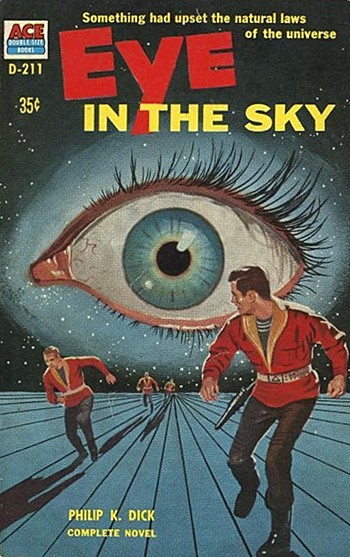 In his A Life of Philip K Dick: The Man Who Remembered the Future
In his A Life of Philip K Dick: The Man Who Remembered the Future, Peake lists numerous other cases in which Dick seems to have precognized events in his own life. Although some of these cases can certainly be explained as the writer unconsciously fulfilling his own myth after the fact, others are uncanny and highly suggestive of something paranormal. I absolutely agree with Peake that Dick had been precognizing his own future his whole life, possibly even visiting his past self in dreams. Dick saw it this way too, and his Exegesis
is a massive investigation of the implications of such autobiographical time loops for our understanding of causality and consciousness, one of the most mind-blowing books of our time.
That Dick was channeling his own future, particularly when he was absorbed in frenetically setting words to page, should not surprise us at all. Psi seems to emerge especially in “flow” states of skilled engagement. Whenever you are really cooking at whatever it is you are most skilled at and enjoy, that’s when (albeit unbenownst to you) you will be most tapped into the precognitive signal channel I have called “prophetic jouissance” and which traditionally has just been called “the muse.” Among literary types, precognition seems to uniquely characterize frenetic genre writers, people compelled to bust their asses in the “trash stratum” just to make ends meet.
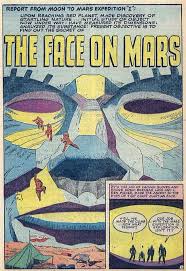 Dick is only the most famous example. The alcoholic, depressed, and impoverished sea adventure writer Morgan Robertson precognized not only the sinking of the Titanic 14 years before it occurred but also the Japanese sneak attack on the U.S. Navy in Hawaii and the invention of radar. Comics genius Jack Kirby, as Chris Knowles has described on his blog, saw and described the “face on mars” 17 years before it was photographed by the Viking orbiters. Knowles has found other similar cases in Kirby’s works.
Dick is only the most famous example. The alcoholic, depressed, and impoverished sea adventure writer Morgan Robertson precognized not only the sinking of the Titanic 14 years before it occurred but also the Japanese sneak attack on the U.S. Navy in Hawaii and the invention of radar. Comics genius Jack Kirby, as Chris Knowles has described on his blog, saw and described the “face on mars” 17 years before it was photographed by the Viking orbiters. Knowles has found other similar cases in Kirby’s works.
It seems (as Knowles suggests) that the less self-conscious of being “respectably literary” a writer or artist is, and the faster he produces, the more uncanny prophecies emerge “automatically” from his pen or typewriter. Inspiration, I am convinced, is real, authentic psi. Although Rick Strassman has linked prophecy to DMT and the pineal gland (the usual ‘unitarian’ wishful thinking that goes back to Descartes and possibly the ancient world), I foretell that a future neuropsychology of psi will concentrate on dopamine and the dopaminergic circuits of the reward system, since dopamine is really the neurotransmitter most associated with anticipatory signals. Appropriately enough in Dick’s case and probably lots of other under-the-gun genre writers, it is stimulants like amphetamines and even coffee that most directly boost dopamine and thus frenetic anticipatory jouissance, not hallucinogens.
We live in a vast precognitive soup, and at least some artists seem to draw not only from past influences but also from their own future timelines, precognizing their own books they have yet to write as well as books by others they have yet to read. Dick’s hypnagogic visions in 1974 notably included many unread or nonexistent books and galley proofs of what could have been his own future books or books by others in progress. A future “map of precognitive misreading” should thus extend Harold Bloom’s critical theory (The Anxiety of Influence) and explore the role of psi in literary/artistic and even scientific creation. It would require, partly, a better-developed theory of precognition in creative and social networks: Ideas may diffuse among contemporaries precognitively, through future sharings and convergences. In other words, people who have never met (yet) may share ideas, not via telepathy, but by precognizing their future interactions in the flesh or, more likely, the future encountering of their exciting ideas in print. Artists may be reading each other precognitively and borrowing each others most creative ideas, and preempting them, via a vast unconscious psi internet that only a few (including Knowles) have begun to explore.
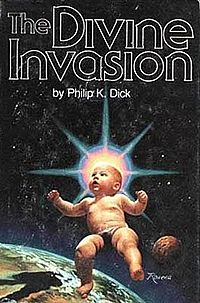 Coming to my main point … I certainly can’t prove it, but I do suspect that in 1974 Dick either precognized reading The Invisible College or precognized reading about Vallee’s control system idea in some secondary source, or hearing about it from a friend, and mapped it onto his own evolving Gnostic suspicions about the world. This would mean that VALIS might actually be named after Vallee, and thus when Vallee later found and admired Dick’s work, it was like being drawn to a bastard child he did not know he’d fathered.
Coming to my main point … I certainly can’t prove it, but I do suspect that in 1974 Dick either precognized reading The Invisible College or precognized reading about Vallee’s control system idea in some secondary source, or hearing about it from a friend, and mapped it onto his own evolving Gnostic suspicions about the world. This would mean that VALIS might actually be named after Vallee, and thus when Vallee later found and admired Dick’s work, it was like being drawn to a bastard child he did not know he’d fathered.
But there’s more to this (yes, highly speculative) story.
From VALIS to Vaal
Rewind several years, to 1967.
I wrote a few months ago about a precognitive dream I had related to a 1967 Star Trek episode called “The Apple,” about an ancient planetary computer named Vaal, which keeps the primitive humanoids who feed and service it in a state of ignorance and innocence. “The Apple” was typical of many Star Trek episodes that had a Gnostic theme: Some computer or other controlling demigod always seemed to be keeping the locals in a state of ignorance or slavery until the Enterprise crew arrived and liberated them. In fact, Max Simon Ehrlich’s original screenplay for “The Apple” was seen as so unoriginal and so specifically similar to the episode “Return of the Archons,” also about a computer ideologically regulating a planet’s inhabitants, that Gene L. Coon subjected it to a major revision to make it more distinct.
Artistic/creative feedback loops could be an important way that occulted, occluded, disbelieved, or misidentified precognition shapes human culture, and thus a future literary criticism will involve a kind of psychic deconstruction.
In the episode, Vaal (who appears as a big reptilian stone head) communicates to his elect, the leader of the humanoids named Akuta, via transmissions beamed to small antennae implanted behind his ears—in other words, Vaal is a vast, active, and even “living” (since he seems to require periodic offerings of fruit as fuel), intelligent control system, who exerts his influence by manipulating the thoughts and beliefs of the planet’s “innocent” inhabitants.
Dick was like a sponge soaking up pop culture, and no stranger to cryptomnesia. Paul Rydeen notes likely influences in VALIS of Scientology, of Robert Temple’s The Sirius Mystery (which seems to have deflected the origins of Valis from Formalhaut, in Radio Free Albemuth, to Sirius in VALIS), and the Star Trek episode “Break and Circuses.” The latter, about a basically 20th-century planet where Rome never fell, seems like it could have wormed its way into Dick’s ancient Rome visions/experiences (although ironically, this and many Star Trek alternative history episodes were no doubt influenced in turn by Dick’s own Man in the High Castle). It is entirely possible that Dick could have also seen “The Apple,” either when it first aired or, as I did, in endless weekday afternoon reruns during the mid-1970s, and been subconsciously influenced by it, morphing his own paranoid/Gnostic theory of a higher planetary control system into VALIS.
 This would seemingly negate my earlier psi-based argument, of course: If the name of Dick’s control system came from anywhere in the linear flow of time, it would have come from Ehrlich’s Vaal, not from a still-fairly-obscure UFO researcher who had yet to publish his control system theory. But I propose that, in our precognitive world, and for someone like Dick, the reverse is just as easily the case. Apart from the simple fact that Vallee himself preexisted Ehrlich’s screenplay and Dick’s 1970s writing, linguistics itself supports the priority of naming in this precognitive synchronisitic clusterfuck: “Valis” is a good guess of how an American like Dick might spell a presumptively French word that sounds the way “Vallee” is spelled—for instance, if he heard the name pronounced by an English speaker (with a long e at the end) in a context suggesting the name was French, such as paired with the name Jacques. One could easily imagine that the phrase “Vallee control system” was among the hypnagogic phrases that Dick received from the psychic aether (or, perhaps, from whatever mind control experiment was beaming information into his brain in 1974*).
This would seemingly negate my earlier psi-based argument, of course: If the name of Dick’s control system came from anywhere in the linear flow of time, it would have come from Ehrlich’s Vaal, not from a still-fairly-obscure UFO researcher who had yet to publish his control system theory. But I propose that, in our precognitive world, and for someone like Dick, the reverse is just as easily the case. Apart from the simple fact that Vallee himself preexisted Ehrlich’s screenplay and Dick’s 1970s writing, linguistics itself supports the priority of naming in this precognitive synchronisitic clusterfuck: “Valis” is a good guess of how an American like Dick might spell a presumptively French word that sounds the way “Vallee” is spelled—for instance, if he heard the name pronounced by an English speaker (with a long e at the end) in a context suggesting the name was French, such as paired with the name Jacques. One could easily imagine that the phrase “Vallee control system” was among the hypnagogic phrases that Dick received from the psychic aether (or, perhaps, from whatever mind control experiment was beaming information into his brain in 1974*).
Thus, the more likely direction of influence is from Vallee to Dick. Consequently, Ehrlich is more likely to have gotten the name Vaal precognitively from VALIS than vice versa!
Plagiarizing From the Future
I have written about Slavoj Žižek’s “time loop” interpretation of Jacques Lacan’s theory of the symptom. Žižek is careful to distance himself from actual paranormal phenomena like precognition or time travel, yet his own constant citing of Gnostic science fiction indicates his secret love of such possibilities, so his protests seem to me like anxious defenses to prop up a beleaguered post-Marxian materialism. In a very interesting essay, he delves into the possibility he calls (following Pierre Bayard), “plagiarizing from the future.” The sure indicator that a previous work has plagiarized from a later one, he says, is when the particular, presumptively borrowed element in the earlier work is either jarringly out of place or simply not well developed, compared to the later work.
When the earlier manifestation of an idea is not only less well developed or out of place but also in a “lower” form of literature or writing, it is liable to have been unconsciously inspired by the later work, a case of precognitive plagiarism.
We could add to the list of tip-offs the basic idea that plagiarism from the future, like other forms of plagiarism, both is nearly always unconscious (or at best misrecognized, as no one, not even artists, with the sole exception of Dick, believes in precognition) and, more importantly, tends to be by “lower-status” artists—that is, writers who are forced by lack of public appreciation (Dick), lack of literary gifts (Robertson), or merely their career circumstances (Kirby, Ehrlich) to work hard in a medium that does not have a lot of artistic respectability. Thus, when the earlier manifestation of an idea is not only less well developed or out of place but also in a “lower” form of literature or writing, it is liable to have been unconsciously inspired by the later work, a case of precognitive plagiarism.
I think few would dispute the relative merits of Max Ehrlich’s “The Apple” and Dick’s VALIS—one is a derivative piece of TV camp that, as Marc Cushman puts it, feels like the Enterprise has taken a trip to Gilligan’s Island, while VALIS is arguably one of the best and most interesting novels of the 20th century—even if the cruel genre gods still relegated it to the second-class category of “science fiction.” It is certainly an honest novel, confronting the author’s true (even if psychotic) experiences in an authentic way. Thus, I think it is likely that Ehrlich precognized and borrowed the idea for VALIS in 1966, calling it Vaal, not knowing what he was doing, and especially having no inkling that his planetary stone-headed god was, by a double remove, named after the young UFO researcher Jacques Vallee, whom he had probably never even heard of.
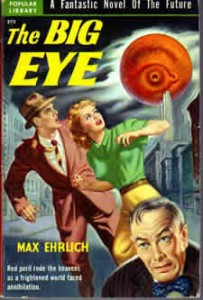 Why do I think this? Because Ehrlich himself shows signs of being one of those precognitive writers toiling in the disregarded cultural slums, who possibly even had a past history of precognitively plagiarizing Dick’s ideas (or at least, book covers). One of Ehrlich’s early novels, for example, The Big Eye (1950), is about the cessation of the Cold War because of the imminent destruction of Earth in a planetary collision, which turns out to be an astronomer’s hoax; the motif of an eye-like image looming in the sky prefigures Dick’s McCarthyism-themed 1958 novel Eye in the Sky, and I can’t help but wonder if somehow the cover (at least) of Dick’s novel may have influenced Ehrlich. There are other possible connections, which I will delve into in a separate post.
Why do I think this? Because Ehrlich himself shows signs of being one of those precognitive writers toiling in the disregarded cultural slums, who possibly even had a past history of precognitively plagiarizing Dick’s ideas (or at least, book covers). One of Ehrlich’s early novels, for example, The Big Eye (1950), is about the cessation of the Cold War because of the imminent destruction of Earth in a planetary collision, which turns out to be an astronomer’s hoax; the motif of an eye-like image looming in the sky prefigures Dick’s McCarthyism-themed 1958 novel Eye in the Sky, and I can’t help but wonder if somehow the cover (at least) of Dick’s novel may have influenced Ehrlich. There are other possible connections, which I will delve into in a separate post.
Psychic Deconstruction
Of course, even if Ehrlich “read” Dick avant a lettre and “plagiarized” from him, it does not preclude Dick also seeing Ehrlich’s Star Trek episode and being influenced by it in turn, in the usual way. This would produce a sort of idea-feedback loop not unlike what I have theorized accounts for synchronicities within the life of an individual. One feature of precognition I have noticed in my own modest investigations into the phenomenon is that some kind of minor coincidence or doubling creates the initial spark, or forms an associative short circuit, acting as the nucleus of the symptom formation that is creative prophetic inspiration. It is completely conceivable to me that seeing a rerun of the Star Trek episode, by closely matching Dick’s own Gnostic ideas and experiences, could have catalyzed a precognitive encounter with Vallee’s ideas and thus given birth to Valisystem and VALIS, just as much as VALIS helped retrocausally shape Ehrlich’s teleplay.
What Vallee and Dick were both trying to put their fingers on could be nothing other than alienated psi, our own prophetic natures disbelieved, disavowed, and thus projected onto some imagined alien technology or intelligence.
I think this kind of artistic/creative feedback loop could be an important (as yet totally unexplored) way that occulted, occluded, disbelieved, or misidentified precognition shapes human culture, and thus a future literary criticism will involve a kind of psychic deconstruction. I am also not too modest to think that this logic, the totally unconscious machinations of precognition in our lives and relationships and the way they produce feedback effects because of our ideologically blinkered nonawareness of psi, may also give rise exactly to the illusion of a homeostatic control system being operated by a higher intelligence. It’s not an illusion, exactly—such an atemporal feedback effect would really be a thermostat regulating our lives, producing chaos and tricksterish effects when we are out of sync with our enjoyment, or the Tao, or whatever you want to call it, and harmonic synchronicities when we are better resonating with our future rewards. The only thing actually missing is the “Other” who is presumed to be manning (or womaning) the controls. The Other is us, unrecognized.
In other words, what Vallee and Dick were both trying to put their fingers on could be nothing other than alienated psi, our own prophetic natures disbelieved, disavowed, and thus projected onto some imagined alien technology or intelligence. If psi includes psychokinetic effects as well as precognitive effects, as abundant research also affirms, then we should take the trickster seriously here: Because no one believes in psi (even most psi believers pay lip service but don’t actually think too hard about the implications), not only our psi radar but also our intentions run rampant in the world, causing effects that no one understands and that we desperately try to fit into a causal narrative. Eric Ouellet’s excellent new book, Illuminations: The UFO Experience as a Parapsychological Event, describes how UFO waves can potentially be explained as mass poltergeist (or recurrent spontaneous psychokinesis) phenomena, along similar lines.
The sure sign of a science in denial of psi is that it runs in circles, perpetually elaborating and becoming more involuted without actually converging on final answers to its driving questions. Isn’t this what is happening both to physics and psychology? The breakthrough will happen, if it happens, only when psi is acknowledged.
Time Is the Problem
Which raises the further question, in light of Vallee’s core interest in UFOs: We tend to think in terms of “missing time,” but maybe displaced time is better. The “precognitive, sentient” nature of such phenomena has been noted by John Alexander and others. But who is it who is precognitive? Are they precognitive, or do they somehow cause us to be precognitive … and does the tricksterish nature of the phenomenon arise partly from our own dogged determination to see causality as unidirectional? UFO encounters are often surrounded by synchronicities, but I have suggested that synchronicities are really ‘surprises’ produced by our own unacknowledged precognitive faculty. We predict or orient to something precognitively but then, because we don’t believe in precognition, feel shock and surprise when the thing we precognitively oriented toward manifests in our life.
Oedipus isn’t really about marrying your mother; it is an archetype of misrecognized psi—how we wreak havoc on our lives and relationships when we engage in time travel and don’t know it.
In The Invisible College, Vallee signals loudly that time is the problem, that effects might come before causes, and that UFOs seem to be trying to convey something of this nature. He mentions a French 1954 encounter in which a UFO occupant asked a witness what time it was; the witness replied “2:30,” to which the UFO visitor answered, “You lie—it is four o’clock.” Time displacement is a common feature of close encounters. A recent MUFON case file described a pilot encounter with a UFO closely shadowing his plane, which was caught on radar … but with an eight-minute time displacement from the pilot’s actual spacetime position.
So here’s another possibility to ponder: When people see UFOs, are they actually seeing things not from the future but in the future, the business end of psychic (or psychotronic) time machines or psychic projectors being operated by our descendents? Could UFOs be visions of a future technology designed precisely to establish a psychic link, or collect psychic information, across time as well as space? Do UFOs represent future technological interventions to alter “past” history, sort of like massively scaled-up versions of Helmut Schmidt’s retro-PK experiments?
Squinting hard and rubbing my temples, my prophecy of the future of ufology is that the answer is indeed going to come from parapsychology, just as Vallee intuited and as Eric Ouellet reminds us. I’m not sure I totally buy Ouellet’s poltergeist idea, but in the over four decades since Vallee took his walk with Puthoff, there have not been many other big advances. Perhaps we will not have confirmation of what UFOs are until psychotronic technology is developed—that is, until the present generation is the agent of psychic technology and not on the receiving end. This is the true meaning, perhaps, of the claims of some bitter aging ufologists that we will not see an answer to the UFO question in our lifetimes. If it’s true, it’s simply because it’s not the future yet.
Postscript: Is Vallee VALIS?
Inserting reference to a particular event in a text that ostensibly precedes the event is one way of creating the illusion of prophecy. That is the oldest trick in the forgers book: You can manipulate belief very easily by playing with the apparent dates of things, and who knew what when. The most famous example of this is the Hermetic corpus, which was probably written in the first few centuries CE and included oblique references to Christ. For Renaissance intellectuals, who believed it preceded the Common Era, this confirmed its prophetic nature; another possibility is that it was genuinely older but was later emended with suggestive references to the savior to give it “prophetic” authority.
In the 1973 diary entry I mentioned, Vallee smuggles in a reference to Dick’s VALIS months before Dick even had his ‘mystical’ experience or began writing about VALIS in his own journals. Like I said, the context, and the fact we know he did go back and edit or at least comment on his journals, suggests this was not precognition on Vallee’s part but a much later editorial emendation that simply did not take into account the precise publication date of Dick’s VALIS or the work leading up to it. It could be totally innocent. But could Vallee also have been engaging in the same kind of trickery he attributes to the control system?
In Invisible College, Vallee mentions time displacement in the context of hypnotic manipulation, relating a vignette in which psychologist Milton Erickson found he could render a subject susceptible to suggestion through reframing. The example Erickson uses is politely telling a person he has just collided with on the street the (wrong) time of day, instead of a humble apology, leaving the other person desperately ready to embrace any new piece of concrete information to alleviate their confusion. UFOs, Vallee suggests, are a bit like that collision and bizarre reframing, making the witness very susceptible to some kind of hypnotic manipulation. In a Radio Mysterioso interview, the late Bruce Duensing suggests Vallee is playing such a game by noting the strangely non-sequitur mention of UFOs in the middle of Vallee’s Ted talk “The Age of Impossible: Anticipating Discontinuous Futures.”
 That Vallee’s journal insertion of VALIS occurs in a very suggestive context of sphinxes and initiations makes me think Duensing could be right, and that Vallee may be playing the trickster here and elsewhere in his works. Vallee himself is a Hermeticist, and elsewhere in Hermetic literature, sphinxes appear as a signal that you need to take the given elements and think about their real sequence to arrive at the true meaning.** In my post on “time’s taboos,” I mentioned the sphinx as a symbol of time travel, and this is what I meant: Not literally creating a wormhole or time machine, but changing the perceived order of events, or seeing how what seems to be an effect may be a cause, and vice versa: exactly the kind of PhilDickian “disordered” thinking necessary to seriously contemplate precognition and its implications.
That Vallee’s journal insertion of VALIS occurs in a very suggestive context of sphinxes and initiations makes me think Duensing could be right, and that Vallee may be playing the trickster here and elsewhere in his works. Vallee himself is a Hermeticist, and elsewhere in Hermetic literature, sphinxes appear as a signal that you need to take the given elements and think about their real sequence to arrive at the true meaning.** In my post on “time’s taboos,” I mentioned the sphinx as a symbol of time travel, and this is what I meant: Not literally creating a wormhole or time machine, but changing the perceived order of events, or seeing how what seems to be an effect may be a cause, and vice versa: exactly the kind of PhilDickian “disordered” thinking necessary to seriously contemplate precognition and its implications.
This is the latent meaning of the sphinx’s riddle in the Oedipus myth: The numerical sequence 423(1) (“What animal walks on four feet in the morning, two in the afternoon, and three in the evening?” and answered correctly by Oedipus, who limps on only one good foot) is clearly out of order. The human story really begins, not ends, with Oedipus. Freud of course saw that clearly, but Oedipus isn’t really about marrying your mother … It is an archetype of misrecognized psi—how we wreak havoc on our lives and relationships when we engage in time travel and don’t know it.
Vallee is keying in on precisely the power of UFOs to get us to re-think the order in which things occur—in other words, consider the possibilities created/demanded by the real existence of psi. I thus think he himself is trying, in his writings, in his own humble way (and to his small but devoted audience), to be a UFO.
NOTES
*The explosion of interest in psychic contact with alien intelligences in the 1970s, especially in California, coincided with suspected CIA experimentation in mind control, and the suspicion of worldly forces screwing with vulnerable and brilliant minds of the period overshadows much of this material, including Dick’s writings. Zebra/VALIS bears strong resemblance to Andrija Puharich’s “Spectra,” for instance, and the latter’s possible connection to CIA mind control research has raised speculation (by Adam Gorightly and others) that Dick himself was an unwitting victim of such experiments. There is certainly much in Dick’s life story that is suggestive, such as his and his wife’s discovery that the neighboring apartment was vacant except for a lot of electronic equipment. I have even read speculation—although I don’t believe it—that the SRI remote viewing research itself was a cover for mind-control experiments. It is very hard to know what to make of the mind control angle, and even delving superficially into the topic leads to a murky (potentially sanity-destroying) quagmire of paranoia. I thus leave this topic to others who better have their fingers on the pulse of this nexus of pop culture, fringe science, and conspiracy theory (Chris Knowles, that means you).
**Alert readers of Fulcanelli’s Cathedrals book may note something similar going on with that text, and the sphinxes therein. The alchemical secret, if Fulcanelli is to be believed, centers not on the End Times, as Jay Weidner and Vincent Bridges argue in their massive exercise in exegetical pareidolia, The Mysteries of the Great Cross of Hendaye, but on the end of time, as in, stopping or stepping out of time. Apocalypticism, as expressed in End Time cults and Christian Fundamentalism, represents, as Fulcanelli deliberately phrases it, primitive chiliasm (milennarianism)—primitive as in overly concrete or “literal minded.” In other words, supposing any of this has to do with the End Times is to naively fall for his trap. Fulcanelli’s interest is really in stopping or suspending time itself.
How do we do that? Duh, meditation. This is clear enough because Rene Schwaller, who may have been Fulcanelli (all you need to do is adjust Fulcanelli’s supposed chronology) or who at least, by his own claim, gave Fulcanelli the manuscript that became the Cathedrals book, tells us, via Andre Vandenbroek, that “stopping time” is the aim of alchemy. The point is “cognition of the present moment … the Absolute from which we draw our power.” Colin Wilson explains this as the most significant feature of Schwaller’s Hermetic philosophy:
One way of explaining it would be to say that human beings imagine they live in the present, yet their basic mental state might be described as ‘elsewhereness’, like a schoolboy looking out of a window instead of paying attention to the lesson. It is, in fact, incredibly difficult to be ‘present’, since we live in an interpreted world. We cannot even ‘see’ without preconception—’that is so and so’. Our most basic frame of mind is that of spectators; we look out at the world like someone in a cinema. When a man awakens to present reality—as Dostoevsky did when stood in front of a firing squad—the whole world changes. Everything suddenly becomes real. But his vision of himself also changes: he becomes aware of himself as a dynamic force rather than as a passive entity. … [A]lchemy, or the transmutation of matter into spirit … depends upon this ‘moment of power’, of being wholly present in the present moment.
Deer in the Headlights: Attention and the Quantum Zeno Effect
“The world is a dynamic mess of jiggling things if you look at it right. And if you magnify it, you can hardly see anything anymore, because everything is jiggling and they’re all in patterns, and they’re all lots of little balls. It’s lucky that we have such a large scale view of everything, that we can see them as things, without having to worry about all these little atoms all the time.” — Richard Feynman
Lately lots of anti-materialist writers are describing the brain as an interface between consciousness and the physical organism, a way of translating nonlocal mind into material intention. Quantum physics is typically invoked to explain how this might happen, yet it often involves a lot of vague hand-waving. I admit to being guilty of said hand-waving. It sounds nice and impressive to talk about “collapsing wave functions” and whatnot, but there’s no way for non-physicists to really evaluate such claims, and honestly, resolute skeptics and materialists are right to distrust us when we make these kinds of speculations.
The privileging of consciousness in most of our jerry-rigged and often desperate-sounding New Age accounts of intention affecting reality sound a lot like wish-fulfillment: We want it to be the case, but we can’t actually say how it is the case, with any kind of real conviction.
Although the idea that consciousness emerges from material processes can never be more than an idea, hence within consciousness—as any number of writers, from Rupert Sheldrake to Deepak Chopra to Bernardo Kastrup have very nicely pointed out in recent books—the materialist bad guys are on much firmer ground in saying that quantum effects, at least in most mainstream interpretations, hold mainly on a microscopic level. How does collapsing an electron’s wave function through observation translate to changing the New York Times on my doorstep from a possibility to an actuality when I open the door to retrieve it?
Another big Achilles heel in anti-materialist invocations of quantum mechanics is in somehow thinking that the randomness that negates determinist causation on the particle level by itself opens the door to free will on a human scale. Even if it’s not actually a classical, billiard-ball world down there with all those jiggling particles, randomness alone does not provide any account of consciousness as a free agent in our human world.
Thus, as it now stands, the privileging of consciousness in many of our jerry-rigged and often desperate-sounding New Age accounts of intention affecting reality sound a lot like wish-fulfillment: We want it to be the case, but we can’t actually say how it is the case. Frankly, I wouldn’t trust us on these questions, if I were a heardheaded materialist skeptic.
This is where I have been extremely impressed (blown away, really) by the work of Henry P. Stapp, a theoretical physicist who has been working on this problem his whole career, and who has produced a rather dazzling quantum-mechanical account of how the brain may translate conscious intention into macroscopic effects. This isn’t the usual vague hand-waving. Stapp’s book Mindful Universe walks the reader through the history and underpinnings of quantum physics in a thorough but remarkably readable manner, and explains at every step of the way not only why consciousness must factor in to our understanding of the physical universe on a very fundamental level (the Copenhagen-Von Neumann Interpretation) but also how our brains may work as an interface between consciousness and the machine of the body, through precisely the “probing” (i.e., posing of “yes/no” questions) that quantum mechanics models in its most iconic experiments.
 Consciousness basically is an experimenter, Stapp says—a chooser of what questions to ask of nature. On a particle level, nature is free to answer however she chooses (i.e., randomly), yet there is a crucial loophole: a phenomenon known as the Quantum Zeno Effect. This effect may be decisive for the way consciousness influences the actions of the meat machine via the brain. Specifically, persistent rapid probing of reality produces the same “answer” repeatedly from the physical world, effectively “stopping time” in some sense—hence the name of the effect, which refers to Zeno’s paradoxes like an arrow that must first get halfway to its target, but first halfway to that, and so on, and thus never being able to leave the bow at all.
Consciousness basically is an experimenter, Stapp says—a chooser of what questions to ask of nature. On a particle level, nature is free to answer however she chooses (i.e., randomly), yet there is a crucial loophole: a phenomenon known as the Quantum Zeno Effect. This effect may be decisive for the way consciousness influences the actions of the meat machine via the brain. Specifically, persistent rapid probing of reality produces the same “answer” repeatedly from the physical world, effectively “stopping time” in some sense—hence the name of the effect, which refers to Zeno’s paradoxes like an arrow that must first get halfway to its target, but first halfway to that, and so on, and thus never being able to leave the bow at all.
Previous efforts toward a quantum neuroscience, like that of Roger Penrose (Shadows of the Mind), have focused on narrow cellular structures where quantum indeterminacy can come into play. Penrose focused on microtubules that extend through cells, but Stapp focuses on very narrow ion channels in the walls of synapses as sites where, through probing actions that amount to querying the behavior of particles, consciousness takes control of the brain and body. We’re obviously not conscious, in the sense of “aware,” of this querying, as it happens many times a second, at trillions of locations throughout the nervous system; the idea is that cortical activity is entangled and coherent, a unified orchestration of these micro Zeno effects. It reminds me of Feynman’s sense of relief that we do not need to actively micromanage our affairs at the particle level, which would be just too daunting a task. The brain, conveniently, is the organ scaling up those particle-level actions via quantum coherence, enabling them to have macro-level effects. If Stapp is right, we ourselves are macro-scale quantum phenomena.
From Quantum Hand-Waving to Quantum Finger Lifting
Stapp uses the Quantum Zeno Effect to account for the most baffling (and on the surface, most seemingly materialism-supporting) finding in neuroscience, Benjamin Libet’s 1983 discovery of a roughly half-second delay between the initiation of a consciously formulated action—a measurable neurological “readiness potential”—and its actual appearance in conscious awareness. Libet’s and subsequent experiments on this phenomenon (for instance those of psychologist Daniel Wegner) seemingly were the nail in the coffin of “free will” as we ordinarily understand it, since they seemed to show that an intention to move the body follows rather than precedes the observed action. In his contribution to the recent collection, Beyond Physicalism, Stapp addresses Libet’s finding, arguing that it reflects instead an illusion produced by observation-related collapse a la Heisenberg.
If Stapp is right, the bodymind is PhilDickian to its core: The calcium ions triggering neurotransmitters to cross the synaptic cleft are little Schrodinger’s cats.
To perform an action, the neural command architecture should already be primed in advance and ready, like a spring; in an uncertain universe, a range of possible actions should all be readied, and thus a large range of neural actions should be primed in the invisible no-space of quantum superposition (what I have called the Quantum Not Yet). The choice to make a particular action amounts on the neuronal level to a choice to observe a quantum state (in other words, consciousness as experimenter again), which collapses that fan of potential action templates to a single actual readiness potential; the unactualized possibilities disappear. In a very real sense, our every decision to move a muscle is acting “retrocausally” by collapsing the fuzzy smear of possible readiness potentials to a definite, determined one, producing an apparently paradoxical effect of an effect (the measured readiness potential) preceding its cause (the conscious decision to make this muscle motion rather than that one or none at all).
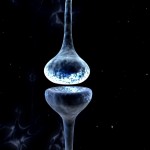 If Stapp is right, the bodymind is PhilDickian to its core: The calcium ions moving through narrow vesicles and triggering neurotransmitters to cross the synaptic cleft are little Schrodinger’s cats, and the implication is that in our very early development our consciousness learned to control this process through a form of (small-scale) persistence, repeatedly posing the same “yes/no” questions and discovering that this persistent probing had the power to move the body in relatively predictable ways.
If Stapp is right, the bodymind is PhilDickian to its core: The calcium ions moving through narrow vesicles and triggering neurotransmitters to cross the synaptic cleft are little Schrodinger’s cats, and the implication is that in our very early development our consciousness learned to control this process through a form of (small-scale) persistence, repeatedly posing the same “yes/no” questions and discovering that this persistent probing had the power to move the body in relatively predictable ways.
Watched Pots
The Quantum Zeno Effect could be described as a prophylactic against information loss (entropy gain), as a result of focused, persistent attention, or the seeking of information. Sometimes called the “watched pot effect,” this can even be thought of as the local stopping or slowing of time, could it not? Reality, in other words, is like a deer that freezes in attention’s headlights. One mind-blowing implication of this—although I don’t think Stapp articulates it this way—is that it seems to offer further evidence there is no single temporal stream but that everything, every particle, has its own temporal flow, depending partly on the level of attention it receives. Those flows locally may tend to average out and give the illusion of coherence, but focused attention on some part of a system may actually slow its unfolding, perturbing the whole in a certain direction.
Could narrow focused engagement actually alter the local flow of time around the object of attention? Is the shaping of time around our activity a real effect and not just a subjective illusion?
If the Quantum Zeno Effect is the basic “hack” by which conscious intention fashions the world to its desires and in its image, it could explain numerous effects experienced by athletes and creative writers and artists who experience “flow” states—expanded subjective time as a function of how narrowly versus diffusely the attention is focused on a problem or task. Could narrow focused engagement actually alter the local flow of time around the object of attention? Is the shaping of time around our activity a real effect and not just a subjective illusion?
It’s easy to extrapolate from this small-scale, nuts-and-bolts picture of quantum interfacing with our meat-mecha-body to advanced and effortful kinds of coherent “probing” in the form of meditation and other types of focused mental discipline. These may potentially capitalize on the Quantum Zeno Effect for more remarkable feats in which we influence not only the body but also the external material world, for instance in psi phenomena. Stapp’s theory has implications, in other words, for how attention might manifest intention.
That would be just one more reason why attention—the focusing and directing of consciousness—is the most precious resource there is, as well as our fundamental superpower birthright. There are countless ways our attention is captured and redirected by media, technology, and attention-needy persons and institutions; and there are many ways culture itself acts as a psi-delimiting system, precisely by scrambling and weakening our powers of attention. So, if you aren’t already working your attentional muscle in some kind of daily meditation practice, to defeat these corrosive forces on your psi, WTF are you waiting for?
The Vicinity of the Real (Tarkovsky’s Stalker)
The Zone in Andrei Tarkovsky’s late sci-fi masterpiece Stalker is one of my favorite places, real or imagined. It is a landscape of overgrown ruins, where spacetime itself is uncertain and only the experienced can guide you through. It is not that the guide (the “Stalker” of the title) knows the way—because the way is never the same as it was last time—but because he knows the indications, and knows how to test the reality there, to guide his companions safely.
Stalker, the film, is, recursively, a lot like the ambiguous catastrophe that created the Zone: It has destroyed and bent time itself, and caused causality to rupture.
The Zone could stand as the prototype for practically every postapocalyptic landscape in cinema or fiction. It is the dead marshes that surround Mordor, for instance, as well as Mordor itself. In Peter Jackson’s film of The Two Towers, the armored Elvish corpses lying just under the water seem to have been modeled on the marsh over which Tarkovsky’s famous tracking shot slowly inches, toward the Stalker’s sleeping hand. Just inches under the water are objects from various times, partly exposed in the mud: a metal tray, a syringe, coins, a religious icon, a gun, a spring. bathroom tile … You could miss them if you weren’t looking.
 More fundamentally, the Zone is the Grail Kingdom from the Arthurian romances and Wagner’s Parsifal: a beautiful but strangely timeless and desolate place, where time itself seems to slow down in the vicinity of the traumatic yet life-giving miracle at its center. The Zone is the waste land created by the Grail King’s curse, like the “bradychronality” (region of viscous time) near a black hole, where the ordinary rules do not apply. It is the realm on the edge, on the rim of the symbolic—you can see its broken wreckage around you, you can grip tight to the twisted rebar jutting from the shattered concrete—but it is not yet the Real. It is what lies between the Real and consensus reality, a trickster landscape of danger and possibility.
More fundamentally, the Zone is the Grail Kingdom from the Arthurian romances and Wagner’s Parsifal: a beautiful but strangely timeless and desolate place, where time itself seems to slow down in the vicinity of the traumatic yet life-giving miracle at its center. The Zone is the waste land created by the Grail King’s curse, like the “bradychronality” (region of viscous time) near a black hole, where the ordinary rules do not apply. It is the realm on the edge, on the rim of the symbolic—you can see its broken wreckage around you, you can grip tight to the twisted rebar jutting from the shattered concrete—but it is not yet the Real. It is what lies between the Real and consensus reality, a trickster landscape of danger and possibility.
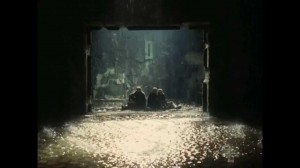 At the heart of the Zone is a room where, it is said, one’s deepest wish will be granted. This is why two men, a famous writer and a prominent scientist, have paid dearly to have the Stalker guide them through this landscape. But once they get there, they find just an empty, dirty room with water covering the floor—a nothing. They bicker, and fight, and hesitate to go in. The Stalker himself won’t go in. He reveals that his predecessor and mentor, the great master-stalker named “Porcupine,” went in, and came out to find himself a rich man. He hung himself after that, because he had gone in seeking to bring his dead brother back to life—his brother, whom he had led to his death in the Zone. The room knew better than Porcupine did his own heart’s true desire, and it was not pretty or noble.
At the heart of the Zone is a room where, it is said, one’s deepest wish will be granted. This is why two men, a famous writer and a prominent scientist, have paid dearly to have the Stalker guide them through this landscape. But once they get there, they find just an empty, dirty room with water covering the floor—a nothing. They bicker, and fight, and hesitate to go in. The Stalker himself won’t go in. He reveals that his predecessor and mentor, the great master-stalker named “Porcupine,” went in, and came out to find himself a rich man. He hung himself after that, because he had gone in seeking to bring his dead brother back to life—his brother, whom he had led to his death in the Zone. The room knew better than Porcupine did his own heart’s true desire, and it was not pretty or noble.
The scholar turns on his guide and accosts him, accusing him of toying with them. The scientist pulls out a small nuclear device he had smuggled in his backpack, to destroy the room and the superstition the room represents. But both men realize the pathetic absurdity of their gestures, and back down from their threats. The journey seems to teach them something about themselves. It is enough to come to the threshold and not walk through.
From Wish to Enjoyment
I have frequently dreamed and thought about the Zone, and the dripping, watery room at its heart, ever since I first saw Tarkovsky’s masterpiece about 30 years ago. It is a real place—in a very precise sense. Or rather, it is the no-man’s land on the edge of the Real, a dangerous margin between the Real and the ordinary world. And the film Stalker itself (based on the also-excellent novel Roadside Picnic by Boris and Arkady Strugatsky) is like the supplement, or a permutation, of countless other philosophical and sci-fi parables. It radiates outward in time and space in all directions. It is always present, like one of Phil Dick’s “common constituents.”
 Stalker is a permutation of the Robert Scheckley’s short story, “The Store of Worlds,” for one thing. An old man in a run-down shack on the edge of town peddles a drug that will take the user to a dimension where your deepest wishes are fulfilled. The main character, Mr. Wayne, hesitates upon first visiting the old man, and leaves saying he will consider the offer. Later he resolves to go back and take it, yet he continually hesitates, continually puts it off because the mundane demands of his work and family routine make him too busy. Eventually he wakes up in the old man’s shack, in a dismal postapocalyptic “real world,” and pays the old man everything he owns—just some scraps—satisfied that indeed the drug (which he did in fact take on that first visit) did as promised: The banal tedious reality of an ordinary life was actually what he wished for.
Stalker is a permutation of the Robert Scheckley’s short story, “The Store of Worlds,” for one thing. An old man in a run-down shack on the edge of town peddles a drug that will take the user to a dimension where your deepest wishes are fulfilled. The main character, Mr. Wayne, hesitates upon first visiting the old man, and leaves saying he will consider the offer. Later he resolves to go back and take it, yet he continually hesitates, continually puts it off because the mundane demands of his work and family routine make him too busy. Eventually he wakes up in the old man’s shack, in a dismal postapocalyptic “real world,” and pays the old man everything he owns—just some scraps—satisfied that indeed the drug (which he did in fact take on that first visit) did as promised: The banal tedious reality of an ordinary life was actually what he wished for.
On the outside, or to other people, our secret enjoyment may look like trash or junk—indeed, just like that miserable, dripping, peeling room—but to us it is everything.
Stalker is also a lot like Kafka’s famous parable “Before the Law.” A “man from the country” comes before the Door of the Law and begs to gain access but is prevented, giving up all his money in bribes to the gatekeeper but to no end. The man waits and waits, and the gatekeeper finally shuts the door as he dies, telling him that all along this door was meant only for him. Even if, in death, he seems separated from his ultimate consuming goal, we may realize that his deeper more inaccessible wish (rather neurotically) has been to live his whole life in the presence of the gatekeeper, asking him questions, paying him bribes. This is what gives his life meaning, even if he has required this other fantasy screen (the door) as a way to explain it to himself.
 It is sometimes said that the danger of the wish-granting room in the Zone is that your deepest wish won’t be what you want (or believe) it to be, or that you won’t be able to phrase it correctly. At the end, on their return to civilization, when we see how the Stalker of the film lives in a modest dwelling, with a crippled, mutant daughter, we understand exactly his fear: that somehow his obvious wish to cure his daughter or provide better for his family may not be his deepest. It is thus better to be ignorant of our deepest unconscious wish lest we end up like Porcupine.
It is sometimes said that the danger of the wish-granting room in the Zone is that your deepest wish won’t be what you want (or believe) it to be, or that you won’t be able to phrase it correctly. At the end, on their return to civilization, when we see how the Stalker of the film lives in a modest dwelling, with a crippled, mutant daughter, we understand exactly his fear: that somehow his obvious wish to cure his daughter or provide better for his family may not be his deepest. It is thus better to be ignorant of our deepest unconscious wish lest we end up like Porcupine.
But I believe this emphasis on wishes is wrong—indeed, that is meant to distract us from the real thing. Wish belongs to the category of desire, and thus is about our lack; but the more fundamental thing is enjoyment. Desire always beguiles us and causes us to misperceive or overlook the way we enjoy even in deprivation: In fact, we are always enjoying, always extracting a sustaining meaning from our circumstances. Enjoyment is our secret “thing,” that which makes life liveable. On the outside, or to other people, our secret enjoyment may look like trash or junk—indeed, just like that miserable, dripping, peeling room—but to us it is everything.
 You might even say that this whole film, about a miserable man not going into the room that might fulfill his wishes, actually presents the contents of the room he does not go in; the structure of the film is a moebius, in that respect. The reality is, the Stalker is already living in and with his deepest enjoyment: His poor home, his daughter, his wife that nags and berates him, the mysterious dog that followed him throughout the film and that we now realize is his (or that has adopted him) are all he needs. Despite his pained expression, they are what his life is really about. (That vivid pain itself, etched upon a scowling, world-weary face, seems like a typically Russian form of enjoyment-in-misery.)
You might even say that this whole film, about a miserable man not going into the room that might fulfill his wishes, actually presents the contents of the room he does not go in; the structure of the film is a moebius, in that respect. The reality is, the Stalker is already living in and with his deepest enjoyment: His poor home, his daughter, his wife that nags and berates him, the mysterious dog that followed him throughout the film and that we now realize is his (or that has adopted him) are all he needs. Despite his pained expression, they are what his life is really about. (That vivid pain itself, etched upon a scowling, world-weary face, seems like a typically Russian form of enjoyment-in-misery.)
The writer detects this all along, in fact: Outside the room, he accuses their guide: “It’s not even the money. You’re enjoying yourself here.”
The Home of Enjoyment
Our enjoyment does not concern our desire, whose object/cause is always fleeting and out of reach. Desire and the language of desire highlights and centralizes a lack, and distracts us from our enjoyment, which, though we cannot put it into words, is what we are living right now, even in our deprivation.
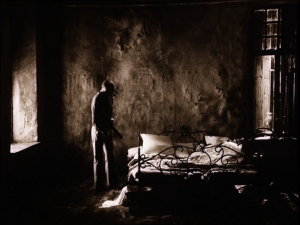 Every uncontrollable emotion that tips over into its opposite or otherwise verges into perilous realms—an orgasm so intense it causes pain, a joke that makes us spit coke out our nose, a religious experience or UFO sighting that causes our friends and family to be embarrassed for us, a drug addiction that ruins our life, or an affection that is so extreme we keep it hidden (like sudden affection for a pet or a child that arouses tears)—this is enjoyment. Enjoyment is what it is all about, it is the meaning of life, it is the “only substance,” and it is “why there is something and not nothing.”
Every uncontrollable emotion that tips over into its opposite or otherwise verges into perilous realms—an orgasm so intense it causes pain, a joke that makes us spit coke out our nose, a religious experience or UFO sighting that causes our friends and family to be embarrassed for us, a drug addiction that ruins our life, or an affection that is so extreme we keep it hidden (like sudden affection for a pet or a child that arouses tears)—this is enjoyment. Enjoyment is what it is all about, it is the meaning of life, it is the “only substance,” and it is “why there is something and not nothing.”
Actually, all these “different forms” of enjoyment—which you could also call by the Anglo-Saxon word bliss—are the same. It is only our attitude that determines whether enjoyment presents to us as fearsome, revolting, painful, or pleasurable. When we cling to the linear world of ego and desire, enjoyment materializes or manifests as threat. Žižek cites endless examples from horror cinema—the terrifying alien or undead “thing” that seems indestructible and threatens to destroy us is our enjoyment under its negative aspect of ego-destroyer. Suffering comes from ignorance about our enjoyment, misperceiving it from the vantage point of the ego and language.
If it were not for the fact that they claimed his life, the deeply faithful Tarkovsky would probably not be troubled by Stalker’s coincidences.
In previous posts I have discussed the prophetic enjoyment that seems to be the “carrier wave” of psi information from our own future. Even (and sometimes especially) traumatic experiences like deaths and disasters actually carry an enjoyment hidden within them, which may boil down to nothing more profound than the simple joyful realization of being alive, which death always frames for us especially vividly. I suspect that this current may have somehow been responsible for the whirlpool of prophecy and tragedy around this film. The film lies at the heart of a synchronistic (or synchromystic) storm.
Stalker Synchronicities
Stalker, the film, is, recursively, a lot like the ambiguous catastrophe that created the Zone: It has destroyed and bent time itself, and caused causality to rupture.
 In the film, the Stalker is clearly radiation-sick from his time in the Zone—a third of his stubbly hair having turned white—and his daughter is a full-on mutant with telekinetic powers. Six years after the film was released, in April 1986, an explosion in Chernobyl’s fourth energy block created a 30-kilometer “zone of alienation” in Soviet Ukraine, and immediately the similarity between the film and the calamity were obvious to everyone.
In the film, the Stalker is clearly radiation-sick from his time in the Zone—a third of his stubbly hair having turned white—and his daughter is a full-on mutant with telekinetic powers. Six years after the film was released, in April 1986, an explosion in Chernobyl’s fourth energy block created a 30-kilometer “zone of alienation” in Soviet Ukraine, and immediately the similarity between the film and the calamity were obvious to everyone.
For example, while the book the movie was based on clearly explains that the Zone was created by an extraterrestrial force or visitation, the cause of the Zone in the movie is left more ambiguous, and one of the explanations mentioned is “a breakdown in the fourth bunker.” Today, in real-life, youth “stalkers” with nothing else to really live for guide people into the irradiated, mutant-haunted land around Chernobyl; a video game called S.T.A.L.K.E.R.: Shadow of Chernobyl mashes up Tarkovsky’s spiritual sci-fi meditation with the real deadly wilderness the reactor created. And photos of Chernobyl’s abandoned buildings (e.g., below) look just like scenes out of the movie.
 Eight months after the Chernobyl explosion, Tarkovski died of an unusual form of lung cancer almost certainly caused by filming Stalker in the genuinely toxic landscape surrounding an Estonian chemical plant. Although a conspiracy theory floated around that the KGB had actually “cancered” him because his films were somehow growing more anti-Soviet, this seems unlikely given that his wife (who also worked on the film) and one of the three lead actors also died of the exact same rare lung cancer.
Eight months after the Chernobyl explosion, Tarkovski died of an unusual form of lung cancer almost certainly caused by filming Stalker in the genuinely toxic landscape surrounding an Estonian chemical plant. Although a conspiracy theory floated around that the KGB had actually “cancered” him because his films were somehow growing more anti-Soviet, this seems unlikely given that his wife (who also worked on the film) and one of the three lead actors also died of the exact same rare lung cancer.
If it were not for the fact that they claimed his life, the deeply faithful Tarkovsky would probably not be troubled by these coincidences.
Tarkovsky as Hermetist
Analyzing Stalker, Žižek dismisses Tarkovsky’s “religious obscurantism,” and he shrugs and assures us that this is not what makes Tarkovsky interesting. Rather it is, he says, the “form” of his films, and the “density of time” he presents. Somehow the fact that Tarkovsky’s characters pray to the ground or actually kiss the ground means that he is more interested in matter than in the standard spiritual impulse to rise above matter. But the fact is, this sense of the spiritual manifesting in matter is nothing other than Hermeticism, which has a long and hallowed tradition in the West and took a very distinctive form in Russia; it is different from the materialism Žižek preaches.
 The Cosmist school of Nikolai Fedorov and his intellectual descendents all melded a nationalist mysticism with futurist ideas for which “out there” is putting it mildly. George Young’s survey, The Russian Cosmists, is a gold mine for any aspiring sci-fi writer. On a hunt for great novel (or trilogy) ideas, they could start with the Big Idea of Fedorov himself, that our human mandate and destiny is to fulfill the Bible through technology, by bringing about the physical resurrection of all past humans. The Russian Cosmists were essentially the Eastern counterparts (or perhaps a continuation) to the Hermetic tradition, but with much more concrete visions for how future man would complete the divine work.
The Cosmist school of Nikolai Fedorov and his intellectual descendents all melded a nationalist mysticism with futurist ideas for which “out there” is putting it mildly. George Young’s survey, The Russian Cosmists, is a gold mine for any aspiring sci-fi writer. On a hunt for great novel (or trilogy) ideas, they could start with the Big Idea of Fedorov himself, that our human mandate and destiny is to fulfill the Bible through technology, by bringing about the physical resurrection of all past humans. The Russian Cosmists were essentially the Eastern counterparts (or perhaps a continuation) to the Hermetic tradition, but with much more concrete visions for how future man would complete the divine work.
I don’t know if Tarkovsky has been linked to the Cosmists and their school, but I think it’s natural that the most spiritual/religious of Soviet filmmakers gravitated to science fiction for his last, most deeply spiritual works; the spiritual and science fiction were and are a natural pairing in that country. Like some Cosmists, Tarkovsky was also a fervent believer in the paranormal, including UFOs. It all goes together. Tarkovsky made films about enjoyment, which is the substance of both the paranormal and the sacred.
From Consciousness to Enjoyment
The home of enjoyment, the Zone, the perimeter of the Real, has much in common with many spiritual concepts, from the “Imaginal” of the Sufi mystics to the spirit worlds of shamanism.
The Stalker is the ultimate Taoist, favoring weakness over strength.
The Real is not endlessly duplicated. It is endlessly the same. My Real is your Real. Through the Real—or, just across its boundaries, its tangents, its perimeter—is where causality breaks down, Time distorts, and you may find information that has no business being there. It is in this liminal edge zone that phenomena like UFOs and ESP manifest. It is a trickster realm of danger as long as we misperceive what it is really about (i.e., mistake our enjoyment for our desires or wishes, like Porcupine).
Enjoyment was what Lao Tze called “Tao,” and indeed, the Stalker is the ultimate Taoist, favoring weakness over strength, as in this strange monologue he delivers amid the ruins:
“Let everything that’s been planned come true. Let them believe. And let them have a laugh at their passions. Because what they call passion actually is not some emotional energy, but just the friction between their souls and the outside world. And most important, let them believe in themselves. Let them be helpless like children, because weakness is a great thing, and strength is nothing.”
Writing on his blog, the Hermetic scholar Aaron Cheak also describes the Stalker in Taoist terms, and beautifully expresses the crucial difference, central to this trickster’s whole message, between (temporal) desire (or “passions”) and this more ineffable and timeless counterpart or what he calls “liberating force”:
Unfortunately we are far too concerned with what we ‘want’, and put more effort into assuaging our ego’s desires than refining and deepening them to discover the liberating force that lies at their root. Our own ‘wish-fulfilling jewel’ runs deeper, operates unconsciously, and speaks a mysterious language. We must silence ourselves before we can hear it, even though its tributaries may be bubbling all around us in an abundance of synchronicities.
To silence ourselves is to open our senses to the invisible—to open our mouths and eyes to the ever-present—yet ever-occulted—symbols that live all around us. If we do this whole-heartedly, our world becomes animated like a divine icon. But if we can’t let go of our need for rational certitude at every step of the way, we risk being lead further astray that we could possibly imagine.
Enjoyment is just another word for this quintessence, which, I have argued in previous posts, is the energy in synchronicity and the modernized alchemy called psi, as well as the ’shamanic’ force liberated through even the most vanilla of Zen meditation.
 I have described the Lynchian Twin Peaks-like imaginal realm that can be accessed while meditating, but the no-man’s land of Tarkovsky’s Zone would be another good analogy. In the Real’s vicinity, where concepts falter and overlap and where its pulsing heart can be glimpsed, we feel a vague trepidation and fear as well as delight. I think this Zen realm or state is much closer to the “spirit worlds” of shamanism than either tradition would want to acknowledge, because their guiding sensibilities and metaphysics are so different.
I have described the Lynchian Twin Peaks-like imaginal realm that can be accessed while meditating, but the no-man’s land of Tarkovsky’s Zone would be another good analogy. In the Real’s vicinity, where concepts falter and overlap and where its pulsing heart can be glimpsed, we feel a vague trepidation and fear as well as delight. I think this Zen realm or state is much closer to the “spirit worlds” of shamanism than either tradition would want to acknowledge, because their guiding sensibilities and metaphysics are so different.
The Stalker himself has been compared to a shaman, showing his paying clients a spiritual truth through fraud, by leading them through a landscape whose magic only he can see, to a room that, he claims, will grant their wishes, but refusing to go in himself as a way of making sure they do not either. Yet this trickery is central to his magic.
Tarkovsky himself said that “The Zone doesn’t exist. Stalker himself invented his Zone …. so that he would be able to bring there some very unhappy persons and impose on them the idea of hope. … This provocation … corresponds to an act of faith.” Yet is fiction fraud if it gives access to a genuine spiritual boon? Hope in this sense, as a sustaining source even in deprivation (or desire/lack), is none other than one of the many outward forms of enjoyment or, as Joseph Campbell might say, one of the masks of God.
What Lies Under the Skin?—Psi and the Physics of Indeterminacy
I have suggested in previous posts that psi may operate not directly on actual reality, but on the unactualized quantum potential of superposed states prior to physical observation, or what for convenience I call the “Not Yet.” I don’t know if this is a widely held interpretation, although quantum mechanics is felt by many theorists to hold the key to understanding psi in one way or another. It seems eminently reasonable to me that consciousness may have some deep affinity for (or even identity with) the non-actual and could be constantly interacting with it.
Anything that remains unobserved is still indeterminate, and this should render even large portions of the past subject to change. Behind the surface of what already exists there must be vast reserves of unobserved potentiality.
Such a notion not only would account for psi but also preserve free will in a non-causally-closed universe, which is crucial given my opposition to the Minkowski glass block universe in which the future somehow already exists. Even though Slavoj Žižek is a die-hard materialist opposed to all manner of “New Age obscurantism” (which would certainly include the woo I spout on this blog), I agree with his argument in The Parallax View against attempts to neatly sew up philosophical and scientific contradictions via pop-Taoist yin/yang symmetries or Jungian archetypes. The dualities of life, including the future and past, exist in an anamorphic, irreconcilable, non-sew-up-able state; nothing adds up, and there is an instability and indeterminacy even in what seems most secure and definitive. This ultimate non-closure and non-self-identity (Buddhist “no self”) is what enables free will to exist; the human subject is an agent participating in making reality through observation—the Copenhagen Interpretation of quantum mechanics insists on this. The future thus cannot exist fully formed “out there” in some preexisting Platonic realm.
Where I depart from Žižek is in suggesting that this asymmetry and non-closure even includes the existent past. The past can really be changed, and not just in its retroactive framing via the ever-shifting Symbolic (which I suggest is just Žižek’s materialistic evasion of paranormal possibilities like precognition). As Richard Shoup writes (in his contribution to the excellent new collection Extrasensory Perception edited by Edwin May and Sonali Bhatt Marwaha), “in the quantum realm, possibilities are ‘real’ and can interact to have real effects.” If psi is an interaction with these possibilities prior to their physical observation, it could explain both precognitive phenomena and psychokinetic (PK) effects, and even “retro-PK” effects: Anything that remains unobserved is still indeterminate, and this should render even large portions of the past subject to change. Behind the surface of what already exists there must be vast reserves of unobserved potentiality.
 The possibility that focused attention can actually alter the past has been explored experimentally—for instance, Helmut Schmidt’s work with retroactively altering the outcome of random number generators. In his book First Sight, James Carpenter argues that psi—including both ESP and PK—is an intrinsic (albeit largely unconscious) part of our everyday functioning. If so, and if psi involves some kind of unconscious tampering with the latent potential of quantum superposed states prior to physical observation, then we may be continually traversing the Forbidden Zone of the Not Yet and thereby creating our own order and moving toward it, hidden even from the eyes of God and Heisenberg. In other words, we are not only reacting to our probable futures through some unconscious precognitive channel; we may even, without knowing it, be setting up opportunities and obstacles for ourselves that could affect our future outcomes by meddling in the past via our attention or our intention.
The possibility that focused attention can actually alter the past has been explored experimentally—for instance, Helmut Schmidt’s work with retroactively altering the outcome of random number generators. In his book First Sight, James Carpenter argues that psi—including both ESP and PK—is an intrinsic (albeit largely unconscious) part of our everyday functioning. If so, and if psi involves some kind of unconscious tampering with the latent potential of quantum superposed states prior to physical observation, then we may be continually traversing the Forbidden Zone of the Not Yet and thereby creating our own order and moving toward it, hidden even from the eyes of God and Heisenberg. In other words, we are not only reacting to our probable futures through some unconscious precognitive channel; we may even, without knowing it, be setting up opportunities and obstacles for ourselves that could affect our future outcomes by meddling in the past via our attention or our intention.
The possibilities could go well beyond the implications for our personal fates. Interacting with the quantum Not Yet may be the ‘secret’ in various ancient alchemical, magical, or shamanic practices. Such retroactive effects may be exploited for healing, for instance, and may be the mechanism involved in nontraditional or spiritual curing modalities (see below). Although scandalous to the materialistically minded, it is not really such a far-out idea, if you have any magical inclinations: Such meddling in the unseen/hidden is what the occult means, after all.
”Pulsing slowly with inchoate life”
Folklore, myth, and art have produced many ways of personifying the abhorrent/fascinating notion that the past is not safely buried and that inert matter may hold weird and awesome surprises in its dark heart. In my last post I mentioned Oedipus as a kind of time traveler, but vampires and other undead creatures are also classic representations of the idea of the fixed (i.e., “dead”) past somehow still subject to change because of a latent unseen potential still lurking under the skin: Despite being inert, cold, and lifeless, a vampire is paradoxically alive, animated by and seeking out a vital energy, symbolized by the blood of the living, especially of youth.
The obvious fact that our bodies are not transparent creates worlds of possibility within us, vast reserves of Not Yet for psi to exploit.
The psychoanalyst Jacques Lacan made such a hidden, unsymbolized-yet-vital domain central to his theory of the human condition: The Real is that which is unspeakable, unknowable, not even actually existing, yet uncannily and outrageously still exerting a tangible effect. It is the very model of the sacred, the impossible acausal cause, and it is the home of jouissance, the excessive painful enjoyment that is “the only substance acknowledged by psychoanalysis.” Jouissance is that blood of youth that keeps the vampire alive, and, I have argued, it is a better candidate than “trauma” for the carrier of precognitive information about our own future. Lacan’s understanding of the psychoanalytic cure was having the patient traverse the fantasy keeping them in ignorance of their enjoyment, thus implicitly carrying them closer to the (terrifying) Real.
 One of Žižek’s favorite illustrations of the Real is a 1942 Robert Heinlein story, “The Unpleasant Profession of Jonathan Hoag”: The title character comes to learn that our universe is only one of a plurality of universes created as works of art by mysterious beings, and that he himself has been assigned by an evil lesser divinity to corrupt our world. Hoag informs his friends of his mission and lets them know that, later that day, he will be fixing a few minor blemishes in reality that he has discovered; he warns his friends not to open their windows or look outside during the minutes when he will be making these fixes. When Hoag’s friends of course do roll down the window of the cab they are riding in, despite his warning, they see a “formless gray flux” where their view of the city had been, “pulsing slowly as if with inchoate life.” This, Žižek says, is the Real—”the pulsing of the pre-symbolic substance in all its abhorrent vitality.”
One of Žižek’s favorite illustrations of the Real is a 1942 Robert Heinlein story, “The Unpleasant Profession of Jonathan Hoag”: The title character comes to learn that our universe is only one of a plurality of universes created as works of art by mysterious beings, and that he himself has been assigned by an evil lesser divinity to corrupt our world. Hoag informs his friends of his mission and lets them know that, later that day, he will be fixing a few minor blemishes in reality that he has discovered; he warns his friends not to open their windows or look outside during the minutes when he will be making these fixes. When Hoag’s friends of course do roll down the window of the cab they are riding in, despite his warning, they see a “formless gray flux” where their view of the city had been, “pulsing slowly as if with inchoate life.” This, Žižek says, is the Real—”the pulsing of the pre-symbolic substance in all its abhorrent vitality.”
I don’t know whether Heinlein was knowingly alluding to quantum physics, but his “formless gray flux” seems precisely to represent the “spread-out smear” of non-actualized quantum potentials. More recently, Žižek has described the inscrutable equations of quantum mechanics as a manifestation of the Real—simply because those equations are intimidating gibberish to most of us—but clearly the “abhorrent” (to a mechanistic materialist) smear of indeterminacy itself is really where the Real is at.
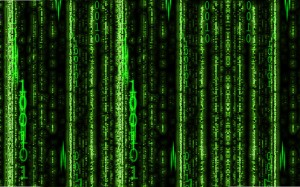 Almost as if to illustrate my proposal that this flux may be directly manipulated or reprogrammed, Hoag’s editorial emendations of reality work through this non-public-facing “quantum back end.” His intervention may look to us today very much like an administrative change to a website, or the Matrix, but the Real does not consist (ultimately) of strings of green numbers tumbling in black space. It is profoundly non-symbolic, not a code, and not even informational in the usual sense. The Real/Not Yet is a domain prior to information as such. This is why, instead of (or in addition to) a “physics of information,” we may find a physics of the indeterminate Real to be more helpful for understanding the more mysterious aspects of our world.
Almost as if to illustrate my proposal that this flux may be directly manipulated or reprogrammed, Hoag’s editorial emendations of reality work through this non-public-facing “quantum back end.” His intervention may look to us today very much like an administrative change to a website, or the Matrix, but the Real does not consist (ultimately) of strings of green numbers tumbling in black space. It is profoundly non-symbolic, not a code, and not even informational in the usual sense. The Real/Not Yet is a domain prior to information as such. This is why, instead of (or in addition to) a “physics of information,” we may find a physics of the indeterminate Real to be more helpful for understanding the more mysterious aspects of our world.
Occult Forces
The body, for example, is a deeply mysterious place. Its obstinate opacity, the simple fact that our skin and flesh make it impossible to see the condition of things underneath, remains one of the biggest challenges to medicine, which is forced to rely on dangerous radiological methods for observation—methods that may raise the risk for the very diseases (e.g., cancers) that they are probing for. On the other hand, the body’s opacity may be one of its most fundamental advantages, from a psi standpoint. The obvious fact that our bodies are not transparent (like those of some deep sea animals) creates worlds of possibility within us, vast reserves of Not Yet for psi to exploit.
 Based on a very suggestive article by William Braud on the possibility of targeting past states of incipient illness through a kind of retro-PK a la Helmut Schmidt, Russell Targ (in Limitless Mind) has described a target of psychic healing as effecting a change within the body while sickness is still vague and indeterminate, before a firm diagnosis is “locked in” through observation (for instance, in an X-ray or surgical procedure that makes the source of the illness visible). “Primitive” cures may (according to this notion) be the deft exploitation or even recruitment of quantum superposition through psychic effects, recruitment of unconscious mind-body connection, and correctly timed real-world observation. In other words, shamanism may be the art of cultivating or shepherding the emergence of desired actualities through careful timing of concealment and disclosure.
Based on a very suggestive article by William Braud on the possibility of targeting past states of incipient illness through a kind of retro-PK a la Helmut Schmidt, Russell Targ (in Limitless Mind) has described a target of psychic healing as effecting a change within the body while sickness is still vague and indeterminate, before a firm diagnosis is “locked in” through observation (for instance, in an X-ray or surgical procedure that makes the source of the illness visible). “Primitive” cures may (according to this notion) be the deft exploitation or even recruitment of quantum superposition through psychic effects, recruitment of unconscious mind-body connection, and correctly timed real-world observation. In other words, shamanism may be the art of cultivating or shepherding the emergence of desired actualities through careful timing of concealment and disclosure.
Paranormal phenomena might not simply fall between our epistemic cracks, but could actually be effects of such cracks, materializations of impossibility.
There is much in the literature of European alchemy to suggest that this idea was also part of the Hermetic tradition. The “fertility” (i.e., potential) of what remains hidden or in the dark (i.e., unobserved) is one of the central themes of Fulcanelli’s 1927 masterpiece, Le Mystere de Cathedrales, one of the most seductive alchemical texts of modern times or of any time. Early in the book, describing the subterranean chambers beneath Gothic cathedrals, he writes: “Real, but occult, power, which is exercised in secret, develops in the darkness, toils without respite in the deep foundations of the work.” He circles back and develops this idea at greater length, very provocatively, later on:
What, then, is this primordial condition, which is essential if any generation is to take place? I will reply on your behalf: the total absence of any solar light, even when diffused or filtered. Look around you, consult your own nature. Do you not see that with man and with animals, fecundation and generation take place, thanks to a certain disposition of organs, in complete obscurity, maintained until the time of birth? … There is no process, even down to the work of digestion … which does not take place in the dark. … I know, myself, that the goddess Isis is the mother of all things, that she bears them all in her womb and that she alone can bestow Revelation and Initiation.
 Isis was the Egyptian prototype of Mary, and the Black Madonnas found in some cathedral crypts reflect this ancient symbol of what could be called the “womb of the Real,” the occult quantum potential from which the Actual (the Stone/Christ) is delivered. The alchemist could be seen as sort of a skilled midwife, helping coax into reality something latent in nature but ordinarily unexpressed or imperfectly expressed. The maternal symbolism goes to the heart of the Hermetic project, where the primordial chaos to be transformed into the philosopher’s stone is called the Prima Materia—the “first matter” which is also “first mother.”
Isis was the Egyptian prototype of Mary, and the Black Madonnas found in some cathedral crypts reflect this ancient symbol of what could be called the “womb of the Real,” the occult quantum potential from which the Actual (the Stone/Christ) is delivered. The alchemist could be seen as sort of a skilled midwife, helping coax into reality something latent in nature but ordinarily unexpressed or imperfectly expressed. The maternal symbolism goes to the heart of the Hermetic project, where the primordial chaos to be transformed into the philosopher’s stone is called the Prima Materia—the “first matter” which is also “first mother.”
Throughout alchemy, the interaction between lunar, feminine, indeterminate darkness and solar, masculine, definitive light or knowledge, was the central archetypal “dance” or interplay, skilfully orchestrated by the adept. Again, as in shamanism, alchemy—which Fulcanelli calls the “art of light”—is not simply “enlightenment” (as Buddhist or Tantric interpreters may understand it) but rather knowing when and for how long to keep things hidden, knowing the proper time to disclose or reveal (i.e., shed light) in order to, again, properly give birth to some possibility that is already latent within matter. Thus, “occult” in the Hermetic sense is not only a matter of keeping secrets from the rabble, but a whole ontology of the Real as what exists prior to knowledge, “light,” and symbolization.
Hinting more directly at the quantum nature of Hermetic practice, Fulcanelli’s colleague (and possibly alter-ego) Rene Schwaller de Lubicz described alchemy as being fundamentally a matter of “perception and gesture,” implying that the key to alchemical creation really lies in a certain way of seeing (i.e., way of observing), as well as a knack for timing certain crucial disclosures. This may involve an occult way of knowing that can penetrate the darkness without light, concretely symbolized by the “rose windows” that dimly illuminate the interior of a cathedral and shed spiritual light on the Mass. This form of knowing, best accessed at night (don’t forget the esoteric meanings of “rose” I discussed in an earlier post), seems to involve upsetting or scrambling the very order of Time and its customary sequences, and reminds me very much of psi.
In imitation of the ever-mysterious Fulcanelli, I will say no more on this subject.*
The Power of Luv
George Hansen has observed that paranormal phenomena all fall within the interstices of our cultural categories; using the terminology of structuralist anthropology, he calls them “anti-structural” (or liminal) phenomena. Lacan’s Real, as the domain outside or beyond the Symbolic, is the equivalent of anti-structure, and I think it provides an even better conceptual framework for understanding the paranormal in all its blurred-together, impossible, absurd forms.
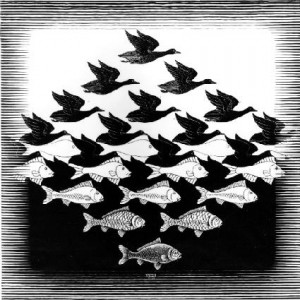 Although often characterized as an actually existing world beyond or underneath the Symbolic, Žižek came to interpret the Real as an insubstantial mirage produced by parallax, the shimmering rift between the Symbolic and Imaginary, a pure semblance or illusion, but one that nevertheless produces a real effect. (Late in his Exegesis, Phil Dick developed a philosophical category that he called the “surd,” exactly like the Real, which he also linked to a parallactic or “Ditheon” mode of perception: The surd is a nothing, a flicker in the inconsistent fabric of the universe, vanishing before it even appears, yet uncannily exerting a tug or pull on reality anyway.) This parallactic understanding of the Real offers a new way of thinking about paranormal phenomena: that they might not simply fall between our epistemic cracks, but could actually be effects of such cracks, perhaps even materializations of impossibility, like those Magritte or Escher images in which the negative space between objects become objects themselves.
Although often characterized as an actually existing world beyond or underneath the Symbolic, Žižek came to interpret the Real as an insubstantial mirage produced by parallax, the shimmering rift between the Symbolic and Imaginary, a pure semblance or illusion, but one that nevertheless produces a real effect. (Late in his Exegesis, Phil Dick developed a philosophical category that he called the “surd,” exactly like the Real, which he also linked to a parallactic or “Ditheon” mode of perception: The surd is a nothing, a flicker in the inconsistent fabric of the universe, vanishing before it even appears, yet uncannily exerting a tug or pull on reality anyway.) This parallactic understanding of the Real offers a new way of thinking about paranormal phenomena: that they might not simply fall between our epistemic cracks, but could actually be effects of such cracks, perhaps even materializations of impossibility, like those Magritte or Escher images in which the negative space between objects become objects themselves.
Thus the sub-question beneath that of psychically intervening in the quantum Real is this: Could it be possible to manifest this no-thing in consensus reality, perhaps shamanically, alchemically, or psychically, so that it could be shared and perceived? Is this somehow the answer to alchemical creativity, the “something from nothing” promised by the ancient mysteries? The Jungian idea, for instance, is that UFOs are somehow manifestations of the collective unconscious in a time of cultural shift; what if we reframe this slightly and suggest that UFOs are manifestations of Symbolic-Imaginary “negative space”—conceptual gaps and discontinuities that under certain psychologically intensified conditions can manifest as solid, existent, objects ‘standing out’ in the world? In Messengers of Deception, Jacques Vallee offers such an occult possibility as one that should at least be considered.
 Various magical traditions describe the ability to create thought-forms; Vallee mentions tulpas, the materialized imaginal beings of Tibetan Buddhist magic. Buddhist orthodoxy declares that these are stabilized hallucinations in the mind of the creator, meant to give insight into the fact that all of reality is mind-created. The ritual magic tradition typically also explains the creation of such forms as manifestations in a psychic interspace (the astral plane) rather than in physical reality, although the folklore surrounding the Jewish mysticism that fed that tradition spoke of animated protoplasmic beings (i.e., golems) running amok in real life. Perhaps less ambitiously, various spiritual traditions also speak of spectral bodily fluids that manifest on the edge of reality or in altered states of consciousness, and seem like similar conjurings of the stuff of the Real out of thin air.
Various magical traditions describe the ability to create thought-forms; Vallee mentions tulpas, the materialized imaginal beings of Tibetan Buddhist magic. Buddhist orthodoxy declares that these are stabilized hallucinations in the mind of the creator, meant to give insight into the fact that all of reality is mind-created. The ritual magic tradition typically also explains the creation of such forms as manifestations in a psychic interspace (the astral plane) rather than in physical reality, although the folklore surrounding the Jewish mysticism that fed that tradition spoke of animated protoplasmic beings (i.e., golems) running amok in real life. Perhaps less ambitiously, various spiritual traditions also speak of spectral bodily fluids that manifest on the edge of reality or in altered states of consciousness, and seem like similar conjurings of the stuff of the Real out of thin air.
One of the fascinating obsessions in Terence McKenna’s account of his experience in Amazonia, True Hallucinations, is the mysterious violet, blue, or black fluid that Amazonian shamans are reputed to vomit and/or sweat during Ayahuasca ceremonies and then use for divination and magic, not unlike the ambiguous “ectoplasm” of Victorian spiritualism (above): “These matters are extremely secret,” McKenna writes:
Informants insist that the shamans spread the stuff out on the ground in front of them, and that one can look into this material and see other times and other places. According to their reports, the nature of this fluid is completely outside of ordinary experience: it is made out of space/time or mind, or it is pure hallucination objectively expressed but always keeping itself within the confines of a liquid.
McKenna’s desire to learn about this stuff stems partly from his own earlier experience in Tibet, during a DMT-fueled sexual encounter with a British woman:
Then I saw that where our bodies were glued together there was flowing, out of her, over me, over the floor of the roof, flowing everywhere, some sort of obsidian liquid, something dark and glittering, with color and lights within it. … What was this fluid and what was going on? I looked at it. I looked right into it, and it was the surface of my own mind reflected in front of me. Was it translinguistic matter, the living opalescent excrescence of the alchemical abyss of hyperspace, something generated by the sex act performed under such crazy conditions? … I christened the obsidian fluid we had generated ‘luv,’ something more than love, something less than love, perhaps not love at all, but some kind of unplumbed potential human experience very little is known about.
Translinguistic matter … an unplumbed potential human experience that very little is known about… Although McKenna says he had smoked DMT, I suspect someone had actually slipped some Lacan into his pipe. That obsidian-black matter beyond language, called “luv,” released in an act of bliss and acting as the medium of nonlocal information, sounds like nothing other than materialized jouissance, released in the rapturous rupture of the Symbolic order.**
Coagulating Jouissance
Is it perhaps possible for jouissance to spatially ‘materialize’ in some strange way or under certain circumstances, as an outcome of the temporal reordering implied by psi perception? In previous posts I have described how misrecognized precognition could create an atemporal feedback loop that adds gravitational weight (i.e., meaning) to a minor coincidence, thus producing what people experience in hindsight as a synchronicity. What if, on analogy with this, there could be an “aspatial” feedback loop that gives material density (or the appearance of density) to an idea, which through a similar chicken-and-egg tautological logic of being observed before it comes into being, feeds back on the prior observation, taking on a kind of temporary, palpable solidity or substantiality?
How many “impossible” paranormal phenomena might be the result of acausal bootstrapping of reality via psi? Is this what created (or, precipitated) the universe to begin with? Was God just a mega-shaman who drew the universe out of his dark chest as a kind of cosmological phlegm?
This admittedly crazy-sounding idea occurred to me not long ago after staring at a duck/rabbit image I have tacked up on my office wall. As I described in my “Rashomon Mind” post several months ago, I was doing this exercise in hopes that I could eventually make the image stabilize on a neither/nor state, thereby defeating or neutralizing the duck/rabbit’s oscillating force. I would thus triumphantly disprove a century of psychological doctrine that the mind cannot tolerate contradiction. It has proved harder than I expected, and my results are still inconclusive. What I did not expect, however, and what astonished me, were certain brief visions that this practice generated … including briefly seeing the duck/rabbit as a solid, 3-D object pushing out of the paper.
 Weirdly, I could briefly not only see but mentally “feel” the duck/rabbit’s solidity in space, like a heavy 5-inch-long lump of gray metal. This was a typically fleeting ’Solaris-Mind’-type vision or hallucination, gone in a split second, but I suspect that this ‘felt sense’ of a solid physical object in one’s presence, as a result of meditation on a model of a desired object, could be the basis of tulpa experiences in much more adept meditators, or thought forms for adept magicians. I don’t know, but perhaps it could also be the basis for palpably experienced magical phlegm described by McKenna. When you stare at something long enough, you hallucinate it in a new, weird way.
Weirdly, I could briefly not only see but mentally “feel” the duck/rabbit’s solidity in space, like a heavy 5-inch-long lump of gray metal. This was a typically fleeting ’Solaris-Mind’-type vision or hallucination, gone in a split second, but I suspect that this ‘felt sense’ of a solid physical object in one’s presence, as a result of meditation on a model of a desired object, could be the basis of tulpa experiences in much more adept meditators, or thought forms for adept magicians. I don’t know, but perhaps it could also be the basis for palpably experienced magical phlegm described by McKenna. When you stare at something long enough, you hallucinate it in a new, weird way.
In my synchronicity model—and this continues to be borne out in my observation of precognitive dreams—a central role is often played by trivial/mundane coincidence, which serves to make a future event, or multiple future events, into a seed around which the synchronicity forms. In what I’m describing here, some brief expectation or misperception could serve, similarly, as the nucleus of the effect. Such a thing could explain the theatrics and fraud that seems to be common in the study of even ‘genuine’ mediums and psychics. A little bit of fraud or trickery to implant the expectation not only in others’ minds but also in one’s own mind could be a necessary seed to facilitate the conjuring of the substance of the Real out of the void, perhaps utilizing the “group effect” of shared expectation.
McKenna’s “luv” seems like such a possible materialization: transitory and flickering, mirage-like, because it is a contradiction, arising from a paradoxical “loop” in the atemporal dimension of substance, mass, and meaning—a kind of intensification of the Real, generating itself as a cause, vanishing as a mirage afterward.
As in the self-confirming circular causation of synchronicity, a thought form conjured literally out of nothing could contribute to the mental state that gives rise to it—at least temporarily, while the conditions are exactly right, before evaporating. If a mental state of ‘anticipation-of-seeing-X’ could be produced and stabilized by a talented trickster/shaman, a drug, or a piece of sophisticated illusionistic or mind-control technology, it might have the effect of actually temporarily manifesting an object that fulfills observers’ expectations, perhaps even exerting real causal effects in the world before it evaporates; a UFO or similar manifestation could actually feed on the strong emotional reactions of witnesses in order to take form. Could this explain the theatrical aspects of some UFO sightings and apparitions?
 The question is, again, would such a thing be only a hallucination? It is one thing to trick oneself or maybe a small group of intoxicated people in the dim candle- or moonlight into seeing something compelling, but could there be “real reality” to these fleeting visions? It sounds preposterous on one level, yet it occurs to me that the paradoxical substance of enjoyment, conjured into existence through careful manipulation of personal totems, would be a kind of shamanic model, in miniature, of how matter might arise as a product of contradiction in a parallactic relativistic universe where no two realities are alike and the future and past don’t neatly join along a nice seam.
The question is, again, would such a thing be only a hallucination? It is one thing to trick oneself or maybe a small group of intoxicated people in the dim candle- or moonlight into seeing something compelling, but could there be “real reality” to these fleeting visions? It sounds preposterous on one level, yet it occurs to me that the paradoxical substance of enjoyment, conjured into existence through careful manipulation of personal totems, would be a kind of shamanic model, in miniature, of how matter might arise as a product of contradiction in a parallactic relativistic universe where no two realities are alike and the future and past don’t neatly join along a nice seam.
By creating contradiction and intensifying it in the confined theaterlike setting of a shamanic ceremony/performance, might creation ex nihilo be what the most gifted shamans and ectoplasm spiritualists are demonstrating? Is this what Fulcanelli was hinting at, when he said he knew that all things emerge from the womb of Isis? Very suggestively, the central concept in Rene Schwaller’s Hermetic theory is Salt (part of the classical alchemical triad with Sulfur and Mercury), which he describes as having a “styptic”—that is, coagulating—function. By “Salt” is he referring to light or observation itself (i.e., perception) as ‘coagulating’ a desired state of matter out of the quantum potential, perhaps by carefully timing the moment of observation? Or is he referring to some literal conjuring of matter out of nothing, out of the primal chaos of the Real, the Buddhist void of no-self itself?
I wonder if psi is the basis of this, and could enable an acausal ‘bootstrapping’ of reality. Is this bootstrapping what created (or, precipitated) the universe to begin with? Was God just a mega-shaman who drew the universe out of his dark chest as a kind of cosmological phlegm?
POSTSCRIPT: Woman Does Not Exist
 The latent potentiality in seemingly fixed matter is, as I mentioned, figuratively a kind of “fertility,” and thus the quantum domain behind the veneer of the actual is especially entangled with the idea of femininity and maternal enjoyment. I argued that the Oedipus myth expresses the taboo and hubris of meddling magically with the non-actual, but the punishment for such (male) hubris is also perhaps the latent meaning in Jonathan Glazer’s masterpiece, Under the Skin, my favorite science fiction film of the past few years.
The latent potentiality in seemingly fixed matter is, as I mentioned, figuratively a kind of “fertility,” and thus the quantum domain behind the veneer of the actual is especially entangled with the idea of femininity and maternal enjoyment. I argued that the Oedipus myth expresses the taboo and hubris of meddling magically with the non-actual, but the punishment for such (male) hubris is also perhaps the latent meaning in Jonathan Glazer’s masterpiece, Under the Skin, my favorite science fiction film of the past few years.
 Scarlett Johansson plays a cold ‘alien’ (of some sort, though her origin and her mission are unclear) who seduces men on the streets of Glasgow, luring them to their doom. The black petroleum-like medium into which she draws her would-be lovers, and their hallucinatory “experience” as they hang suspended in it, somehow out of Time, distinctly call to mind the translinguistic bodily fluid that obsessed McKenna. Seeing that the alien’s “true self” is made of the same black grease-like substance, we realize that it may somehow be her very body, the ‘feminine body of enjoyment,’ that her victims are absorbed and trapped in.
Scarlett Johansson plays a cold ‘alien’ (of some sort, though her origin and her mission are unclear) who seduces men on the streets of Glasgow, luring them to their doom. The black petroleum-like medium into which she draws her would-be lovers, and their hallucinatory “experience” as they hang suspended in it, somehow out of Time, distinctly call to mind the translinguistic bodily fluid that obsessed McKenna. Seeing that the alien’s “true self” is made of the same black grease-like substance, we realize that it may somehow be her very body, the ‘feminine body of enjoyment,’ that her victims are absorbed and trapped in.
 My distant second favorite sci-fi film of the past couple years, Ex Machina, came out over a year after Under the Skin but resembles it in so many details*** that I think they need to be seen as Levi-Straussian permutations of the same underlying myth. The fact that “alien” can be substituted with “robot” shows that, on one level, that myth isn’t about anything science-fictional, but about femininity as a problem of surface (skin) in relation to depth. They are films about the basic idea that, as Lacan put it, “Woman does not exist.” He didn’t mean women do not exist, obviously; he meant that in our psychic landscape, femininity and womanhood represent precisely indeterminacy, fluidity, and dependence on observation to become Actual.
My distant second favorite sci-fi film of the past couple years, Ex Machina, came out over a year after Under the Skin but resembles it in so many details*** that I think they need to be seen as Levi-Straussian permutations of the same underlying myth. The fact that “alien” can be substituted with “robot” shows that, on one level, that myth isn’t about anything science-fictional, but about femininity as a problem of surface (skin) in relation to depth. They are films about the basic idea that, as Lacan put it, “Woman does not exist.” He didn’t mean women do not exist, obviously; he meant that in our psychic landscape, femininity and womanhood represent precisely indeterminacy, fluidity, and dependence on observation to become Actual.
Woman is thus Real, the exact equivalent of the quantum Not Yet, and thus these films carry forward the ancient alchemical “lunar” archetype. When the jet-black alien is revealed at the end of Under the Skin (top of this post), she could just as well be one of those Isis/Madonnas in the cathedral crypts described by Fulcanelli.
 Ex Machina is being discussed as an interesting exploration of artificial intelligence, although really there is nothing that original about the questions it poses—the same questions were asked in Blade Runner 35 years ago, and that film resolved with similar rich ambiguities. What Blade Runner rightly emphasized, and Ex Machina failed to, was that consciousness is a matter of feeling (that is, sentience, not just “intelligence”), which is linked crucially to embodiment, including the body’s capacity for enjoyment and emotional responses (e.g., Roy Batty’s “We’re not computers, Sebastian, we’re physical.”).
Ex Machina is being discussed as an interesting exploration of artificial intelligence, although really there is nothing that original about the questions it poses—the same questions were asked in Blade Runner 35 years ago, and that film resolved with similar rich ambiguities. What Blade Runner rightly emphasized, and Ex Machina failed to, was that consciousness is a matter of feeling (that is, sentience, not just “intelligence”), which is linked crucially to embodiment, including the body’s capacity for enjoyment and emotional responses (e.g., Roy Batty’s “We’re not computers, Sebastian, we’re physical.”).
 The emphasis on Turing Tests and artificial intelligence in Ex Machina basically skips over the real “hard problem” of why it is so hard to build a realistically functioning android body in real life, as evidenced from the ongoing DARPA-funded efforts. It’s not Ava’s brain we should be focused on, in other words, but her physical form—and indeed, that is exactly what we are focused on, despite the film’s various efforts to clothe that interest in philosophical problems. How might the film have been different, and possibly more interesting, if Ava were unattractive, overweight, and clumsy, not unlike the robots that tripped and stumbled through the recent, sadly funny DARPA Robotics Challenge?
The emphasis on Turing Tests and artificial intelligence in Ex Machina basically skips over the real “hard problem” of why it is so hard to build a realistically functioning android body in real life, as evidenced from the ongoing DARPA-funded efforts. It’s not Ava’s brain we should be focused on, in other words, but her physical form—and indeed, that is exactly what we are focused on, despite the film’s various efforts to clothe that interest in philosophical problems. How might the film have been different, and possibly more interesting, if Ava were unattractive, overweight, and clumsy, not unlike the robots that tripped and stumbled through the recent, sadly funny DARPA Robotics Challenge?
Under the Skin, on the other hand, doesn’t make any pretenses about its core mysteries, and when Scarlett Johansson scrutinizes her nude body in the mirror near the end, there is real questioning, because what is under the skin is actually unknown, unexplained, and deeply confusing.
So in some sense, Ex Machina is not just a permutation: It is a materialistic bowdlerization of the messy, dirty mystery examined in Under the Skin. The supposed issue at stake, whether consciousness can be created artificially, is itself “the magician’s hot assistant” (to use the metaphor the film itself provides) to keep us from seeing that our real interest is actually in, and should be in, the magician’s hot assistant, not the magic trick. (As Žižek puts it, “a thing is its own best mask.”) That’s because it is the hot assistant’s body that contains the Real, feminine, physical mystery, “how something can arise from nothing”—which in different ways quantum physics, alchemy, and (I argue) Lacanian psychoanalysis all suggest has to do with jouissance and its potential ability to reorder Time itself.
###
* … BUT if you’re interested, and would like some crucial enlightenment, you could do worse than securing a copy of Andre VandenBroek’s Al-Kemi, paying attention to the author’s hints about decoding other alchemical classics, and then going back and applying that insight to Fulcanelli’s cathedrals book, paying particular attention to sphinxes that don’t bark in the night, and other Oedipal themes. Did I mention that this was crucial?
Oh no, the Hermetic mafia are knocking on my door! I said too much…
** Stephan Beyer discusses the magical phlegm of Amazonian shamans in his recent book Singing to the Plants. And, interestingly, David Lynch displays knowledge of such a substance in connection to the occult. In his painting “Red Man Does Magic Near His House” (below), the magic man of the title exudes an obsidian black (clearly labeled) “fluid.”
*** You don’t believe Under the Skin and Ex Machina are essentially the same film? One is about a cold beautiful alien with borrowed skin tricking and destroying men in a Northern locale; the other is about a cold beautiful robot with borrowed skin tricking and destroying men in a Northern locale. In both films, the non-women must learn to be human, show warmth, and thus earn the trust and interest of men, via their desires. In both films, the non-woman is initially under the control of a powerful man, who ultimately loses that control (the mysterious motorcyclist in Under the Skin and Nathan in Ex Machina). Both films have a disturbing scene where the non-woman coldly ignores the desperate pleading of a male (the baby on the beach in Under the Skin—one of the more distressing and artful set-pieces in recent cinema—and Caleb banging on the glass as Ava leaves the house in Ex Machina). Then of course there is the penultimate sequence in both films, in which the beautiful non-woman gazes at her nude body in the mirror.
I might add that both films also boldly and sensitively feature men with severe facial deformities (the man with neurofibromatosis Scarlett Johansson seduces in Under the Skin, and Nathan in Ex Machina—assuming you count hipster beards as deformities).
Time’s Taboos: Dirty Thoughts on Systems, Syntropy, and Psi
Classical physics, with its totally determinative, forward-in-time, billiard-ball causation, requires sweeping anomalies like psi under the rug, not to mention resigning ourselves to an absence of higher meaning and direction in the universe. Even the local islands of order allowed within the framework of dynamical systems theory that emerged in the middle of the last century with the work of Ludwig von Bertalanffy, Ilya Prigogine, and many others seem (to some) like disappointing consolation prizes in a universe still largely governed by the second law of thermodynamics. Thus in an effort to bridge science and spirituality and transcend bleak mechanistic materialism, a lot of anti-materialist writers are now tweaking thermodynamics in ways that make time appear more symmetrical, the universe less disorderly, and consciousness more central.
The expansive, dissipative past, born in a primordial explosion, seems to demand a receptive orderly destiny to cozily balance things, lest it all end in chaos.
An interesting recent example is the work of Ulisse Di Corpo and Antonella Vannini, who have resurrected mathematician Luigi Fantappie’s mid-20th-century concept of “syntropy,” a postulated countervailing principle to entropy, drawing systems toward complexity, coherence, and order.
Syntropy is retrocausal: Future nodes of convergence and harmony, or “attractors,” exert a pull on the past, according to Di Corpo and Vannini. On the molecular level, special properties of hydrogen bonds (the “hydrogen bridge” discovered by Wolfgang Pauli) make water a uniquely syntropic medium, capable of organizing itself and serving as the basis for the emergence of complex, anti-entropic biological systems out of the entropic, prebiological matrix. In humans and other sentient organisms, emotion acts as a signal current from future attractors; love is a signal of being on a harmonious, life-conducive path, whereas anxiety signals deviation from it. (Thought, by the same token, reflects signals from the past, based on learning and experience.) In this view, as we move toward the future state of order, information is increased—or at least, it does not lose ground in the information/entropy see-saw.
The authors draw on a wide range of research, from quantum mechanics to systems theory to findings in parapsychology, to support their argument. They point for instance to anomalies that seem to indicate consciousness’s power to reverse or inhibit entropy. Robert Jahn and Brenda Dunne’s famous experiments with random event generators at the Princeton Engineering Anomalies Research (PEAR) lab showed that directed attention reduced randomness in the machines; this sort of effect has been found in many different types of experiments in many different laboratories. The authors also invoke Rupert Sheldrake’s arguments about “formative causation”—the notion that there is an extra-genetic template guiding the development of complex organisms and preserving a “memory” of past experiences of a species.
Presaging and hovering over syntropy theory and other ‘complementaristic’ attempts at a more meaning-congenial synthesis are Carl Jung’s theories of synchronicity and archetypes, which were, in their day, also intended to supplement the cold meaningless thermodynamic universe with a sense of meaning, purpose, and direction. Synchronicity, his proposed ‘acausal’ connecting principle, was perhaps what we would now call a retrocausal principle, in which events are, as in syntropy, drawn toward some future coherence. Archetypes, the nodes of this coherence, are much like Plato’s “ideal forms” and Di Corpo and Vannini’s attractors—patterning structures latent within the collective unconscious and giving direction to our lives and fates.
 Such ideas appeal to our human love of balance and symmetry: The expansive, dissipative past, born in a primordial explosion, seems to demand a receptive orderly destiny to cozily balance things, lest it all end in chaos. But is that really the case? Is it really impossible to account for complexity and order, explain psychic anomalies, and make a home and a role for consciousness without departing from a traditional systems framework?
Such ideas appeal to our human love of balance and symmetry: The expansive, dissipative past, born in a primordial explosion, seems to demand a receptive orderly destiny to cozily balance things, lest it all end in chaos. But is that really the case? Is it really impossible to account for complexity and order, explain psychic anomalies, and make a home and a role for consciousness without departing from a traditional systems framework?
Balance Within Imbalance
In thinking about systems and complexity, I have always taken inspiration from Eric Jantsch’s breathtaking 1980 summa, The Self-Organizing Universe, which showed how entropy-exporting (or “dissipative”) systems arise and flourish and complexify—and give rise to meaningful order—within the traditional principles of thermodynamics. Dissipative systems generate complex emergent forms, including not only the complex forms of galaxies, animal and plant life, and the brain, but also the regularities of social existence and universal symbolic structures related to our life as humans, including the most profound cultural symbols. I think systems theory, and its more recent offshoots like chaos theory, fractal geometry, and so on, can actually go a long way toward explaining the “balance within imbalance” of the cosmos without invoking new complementary principles.
Some portion of the uncanny regularity we detect in our lives arises from how we unconsciously cast meaning forward and reel it in, responding to our own future potentialities. We may even, without knowing it, be co-creating the systems of the natural world.
For example, orthodox systems theory demands no syntropic attractor to account for the geometrically perfect, chambered shell of a nautilus, and doesn’t even suggest there is a blueprint for it within the mollusc’s DNA. A very specific schedule of protein synthesis and chemical reactions triggered by DNA transcription gives rise to cellular structures, which give rise to further structures, in a kind of recursive cascade of emergent forms of increasing complexity; the adult form of the animal, including the intricate structure and pattern of its shell, is a more or less predictable outcome of its growth and energy exchange with its environment.
What’s more, even mechanisms for ‘Lamarckian’ morphological change over the generations in response to life events and environmental pressures are now being revealed through epigenomics: Changes to the cellular environment alter gene expression, with no need to invoke something like Sheldrake’s morphogenetic fields. The symphony of molecular and cellular processes is mindbogglingly intricate, but there is no reason or need to think that the final completed form of the animal is (retro)causative in some abstract Platonic fashion, or that there is any prototype for the nautilus either ahead in the future or out there in some nonlocal informational ether.
 Attractors as chaos theory understands them (versus in syntropy theory) are regularities that emerge as a result of multiple interacting variables that produce feedback loops in the “phase space” of a complex system; these exert a kind of gravitational attraction toward a certain form, like a whirlpool, but there are no blueprints for them. It’s just that the myriad mutually interfering/balancing forces create a regularity of outcomes that looks in hindsight somehow intentional, orderly, and even intelligently designed. It is in this sense that I invoked the concept of attractors in thinking about now misrecognized psi leads to apparent synchronous occurrences in our lives; the difference from Jung’s concept of synchronicity or from Di Corpo and Vannini’s concept of syntropy is that the attractor, the meaningful pattern, is a result, not a cause.
Attractors as chaos theory understands them (versus in syntropy theory) are regularities that emerge as a result of multiple interacting variables that produce feedback loops in the “phase space” of a complex system; these exert a kind of gravitational attraction toward a certain form, like a whirlpool, but there are no blueprints for them. It’s just that the myriad mutually interfering/balancing forces create a regularity of outcomes that looks in hindsight somehow intentional, orderly, and even intelligently designed. It is in this sense that I invoked the concept of attractors in thinking about now misrecognized psi leads to apparent synchronous occurrences in our lives; the difference from Jung’s concept of synchronicity or from Di Corpo and Vannini’s concept of syntropy is that the attractor, the meaningful pattern, is a result, not a cause.
One of Jung’s important insights about religion was that humans personify abstract functions and forces in order to conceptually manipulate them using the familiar metaphors of social interaction (“negotiating” with gods and spirits, for example). Yet his archetypes are themselves sort of artificial personifications—or you might say, mechanizations—of universal human psychic and experiential regularities. The fact that humans everywhere experience certain common themes like heroism and motherhood and the ironic self-undercutting of the “trickster” arguably just reflects the regularities of the mindbogglingly complex systems (within systems within systems…) of human life and mind (including psi, in the case of the trickster), not the machine-like patterning and organizing activity of a preexistent organizing psyche.
I am suggesting that there is no real blueprint for our unfolding “out there” in the collective unconscious, or in the future as understood by syntropy theory. We are radically free agents, and it seems important not to lose sight of this in our attempts to rescue order and meaning (and meaningful anomalies) in the universe. Syntropy and related ideas may be reifying the regular outcomes of systems whose complexity just happens to exceed our human capacity to grasp.
Penetrating Time
Where I strongly agree with both syntropy theory and Jung’s theory of synchronicity, however, is that I think consciousness plays a crucial, decisive role in making our future and shaping reality. Many interpretations of quantum theory insist upon this. And I also strongly agree that the crucial X-factor missing from the standard thermodynamic picture is specifically the future’s ability to affect the past via consciousness (i.e., psi). Systems and attractors, even if they are not determinative, are indeed atemporal, and a future systems theory will need to accommodate consciousness’s ability to penetrate the veil of time.
The boundary we call the “present” may not be a knife edge but a blurry mess, with latent potentials extending well into the past and future.
I have been suggesting on this blog that some portion of the uncanny regularity we detect in our lives arises from how we unconsciously cast meaning forward and reel it in, responding to our own future potentialities. This may include even “we” as observers of other, natural and biological systems (like the slimy systems that produce molluscs and seashells)—and thus we may even, without knowing it, be co-creating the systems of the natural world. In other words, our fate as well as the fate of systems under our purview and observation emerge from a pattern of interaction with the field of future potentialities that we unconsciously detect and respond to, ever misrecognizing (or ‘misunderestimating’) the creative role of consciousness in the whole picture. (I even wonder if some of the effects of globally changing biological systems described by Sheldrake, such as lab animals on one continent learning a new task more readily after conspecifics are trained on that task on another continent, may reflect the role of human consciousness, i.e. the knowledge and intentionality of the experimenters, in shaping those systems.)
 Yet, while psi appears to be an interaction with the future (and past), I would argue it is not symmetrical with entropy, and not some kind of natural, born complement, like yin to yang. This may seem like a quibble, but it actually makes a world of difference, because it restores an instability or imbalance—indeed, incoherence—that needs to be there. Noncoherence, the nonidentity of things with themselves—what the Buddhists call “no self” and what Slavoj Žižek calls “parallax”—is essential to the openness and nondeterminism of the universe and the real existence of free will.
Yet, while psi appears to be an interaction with the future (and past), I would argue it is not symmetrical with entropy, and not some kind of natural, born complement, like yin to yang. This may seem like a quibble, but it actually makes a world of difference, because it restores an instability or imbalance—indeed, incoherence—that needs to be there. Noncoherence, the nonidentity of things with themselves—what the Buddhists call “no self” and what Slavoj Žižek calls “parallax”—is essential to the openness and nondeterminism of the universe and the real existence of free will.
The past is half of time, but its complement is purely virtual or imaginary, and the boundary we call the “present” may not be a knife edge but a blurry mess, with latent potentials extending well into the past and future, insofar as they remain unobserved and unmeasured, and thus opening up a whole realm of PhilDickian effects. If psi is related to the perception of quantum potentials and probabilities, as I have suggested in previous posts, it may arise from precisely this asymmetry in the order of things (i.e., parallax). Both the mind and our culture balk at such an asymmetry, though, as well as at the notion that the past and future can interpenetrate. Despite ostensibly offering a way for the future to affect the past, I think concepts like syntropy and synchronicity also paint a picture of a pristine, family-friendly cosmos in which truly messy asymmetries in the order of things, and taboo possibilities like time travel, are papered over.
The Future Looks Shitty From Here
Part of the problem syntropists have with existing dynamical systems theory is that systems “shit”: They take in energy, convert it to order/information, but ultimately excrete (“dissipate”) chaos. They are not content to find meaning in local islands of order (dissipative systems) so long as there is seemingly a larger gain in disorder across the universe as a whole. Even the most beautiful and perfect systems wallow in a bigger pigsty universe where the shit (chaos) just piles higher and deeper. In a purely classical universe, that shit would indeed ultimately swallow and engulf the whole.
The latent Not Yet in quantum physics is often described as a “smear” of potentials existing in a state of quantum superposition. Thus we should not miss how disgusting the world of unactualized potentiality is.
Quantum physics (at least as I understand it) is not as interested in this classical “future” and “past,” as demarcated neatly on some dimensional timeline, as it is in the distinction between the Actual and the Potential, or what I like to think of as the Is and the Not Yet. At any given point in time, from the standpoint of an observer, the past may be a good-enough proxy for the Is, or what has been “collapsed” through observation, but in fact even the landscape of the Is is permeated by the Not Yet in the form of vast reserves of unobserved and thus uncollapsed potential that remain out of view, just under the skin of the visible universe—like Schrodinger’s cats trapped in the walls. This may help account for various retrocausal effects seen in laboratories, such as the rather mindbending experiments of Helmut Schmidt, where subjects affected a random number generator in the past via their intention; according to Henry Stapp, it may also account for Benjamin Libet’s paradoxical findings that seemed to disprove the existence of conscious will (I’ll return to this in a later post on Stapp’s fascinating work).
That latent Not Yet in quantum physics is often described as a spread-out “smear” of potentials existing in a state of quantum superposition. Thus we should not miss how disgusting the world of unactualized potentiality is: Isn’t that “smear” a little bit like the pigsty future promised by classical thermodynamics? When you think about it, unactualized potentials are the ultimate mess; it is only when consciousness engages in observation that that mess is “cleaned up” so to speak, to become something real and solid and shiny and pristine and definite. Mentally intervening or meddling in the not-yet-actual via psi, though, is basically wallowing in that disgusting gray smear of quantum possibility.
 The syntropy model with its future attractors drawing us toward them with love sort of bowdlerizes the disgusting-sounding possibilities latent in quantum physics (and psi), by replacing the indeterminate gray smear with an “already existing future” that looks rather like a scene from a Jehovah’s Witnesses pamphlet: Shiny beautiful glowing perfect people beckoning to you to come join their church picnic. But I think the syntropists (and Platonists, and Jungians) needn’t worry: Consciousness itself is bound to transform the from-here-disordered-looking future into some kind of order and information, even if there’s no way to predict what that order will look like.
The syntropy model with its future attractors drawing us toward them with love sort of bowdlerizes the disgusting-sounding possibilities latent in quantum physics (and psi), by replacing the indeterminate gray smear with an “already existing future” that looks rather like a scene from a Jehovah’s Witnesses pamphlet: Shiny beautiful glowing perfect people beckoning to you to come join their church picnic. But I think the syntropists (and Platonists, and Jungians) needn’t worry: Consciousness itself is bound to transform the from-here-disordered-looking future into some kind of order and information, even if there’s no way to predict what that order will look like.
And we do home in on that future precognitively. But that precognitive engagement with our future potential actually trespasses on taboos even more basic than the scatological: Psi, insofar as it is ‘intercourse’ with the hidden Not Yet under the skin of reality, is basically the temporal equivalent of incest: fundamentally prohibited, and declared “impossible” because we just don’t want to have to form a mental picture of something that is deeply, deeply awkward.
Time and the Oedipus Complex
Even if we are ‘intellectually’ on board with the notion of precognition, some part of us balks at the perversity of a universe that includes information (let alone objects and people) traveling backward in time. The perversity of time travel is, I think, the real meaning of the myth of Oedipus.
A story about a prince taking the place of his own father and marrying his own mother is about the closest the ancient world had to a story about time travel and its paradoxes. Sophocles was Greece’s Phil Dick.
The ancients reckoned the forward, unidirectional, linear flow of time (chronos) through generations—the inevitable, always-forward-moving structure of kinship as well as the forward march of political regimes passed down via offspring. In a sense, kinship and politics were kind of equivalent to the second law of thermodynamics for us, something inexorable and irreversible, moving in a single direction, never flowing backwards, and always basically getting worse (thus always dramatized as tragedy). Thus a story about a prince taking the place of his own father and marrying his own mother is about the closest the ancient world had to a story about time travel and its paradoxes. Sophocles was basically Ancient Greece’s Phil Dick.
 That Oedipus was effectively a time traveler has long been part of the esoteric understanding of that myth. Consider the role of the Sphinx, whose riddle Oedipus correctly answers before he becomes King of Thebes. Sphinxes are symbolic guardians of Time. When HG Wells’ Time Traveler (in The Time Machine) visits the distant future, for example, he finds that a great Sphinx structure has been erected more or less on the site of his laboratory. After his machine is confiscated, he must penetrate that structure to find it and return to Victorian England.
That Oedipus was effectively a time traveler has long been part of the esoteric understanding of that myth. Consider the role of the Sphinx, whose riddle Oedipus correctly answers before he becomes King of Thebes. Sphinxes are symbolic guardians of Time. When HG Wells’ Time Traveler (in The Time Machine) visits the distant future, for example, he finds that a great Sphinx structure has been erected more or less on the site of his laboratory. After his machine is confiscated, he must penetrate that structure to find it and return to Victorian England.
The way one defeats time is by reordering it, signaled by the “creature” in the Sphinx’s riddle: What goes on four feet in the morning, two in the afternoon, and three in the evening? Viewers of the play knew the answer was “man,” who first crawls, then walks upright, then moves with the aid of a cane; but the story implied that most “men” don’t get the answer, and this ignorance is their Achilles heel, enabling the Sphinx (/Time) to defeat them. Oedipus was himself the completion of the riddle, in some sense; he walks with a limp, and his name means “swollen foot” (his father Laius and other male ancestors all also had names connoting “lame” or “limping”). Thus Oedipus was the sole (get it, sole?) human who walked upon only one (good) foot—thus completing the quaternity of the Sphinx’s riddle, but further destroying its numerical sequence.
Blindness and Enjoyment
Di Corpo and Vannini argue that emotions, principally love, are the cord drawing us toward future order. If I am right, it may be something more like enjoyment that transcends time and acts as the carrier of information from our future. (Love per se is a special condition in which we experience enjoyment in common with other people—a unique problem at the heart of social existence and a crucial way in which psi guides and directs us toward others to reproduce and form complex social systems.) I have argued, based on a metaphysically broadminded reading of Lacan and Žižek, that enjoyment must in some sense be “nonlocal”; it is through repetition that a symptom acts as a mechanism amplifying the future’s effect on the past and vice versa. Symptoms are atemporal/acausal formations within the sea of enjoyment. Hence the connection between prophecy, neurosis, art, and ritual/repetition.
How many of our dreams tell of future events that might have occurred but didn’t, because we live in an open, nondeterministic universe? Psi may always be visible only in a very narrow band at the edge of our consciousness.
Enjoyment, which “impossibly” connects the future to the past, is thus what turns psi into a psychoanalytic problem: The point is not merely that Oedipus “traveled into the past” by marrying his mother and killing his father; it is that he committed these crimes and enjoyed them, and only belatedly discovered what it was that he had been enjoying. His guilt was not over his actions but over his misrecognized enjoyment. Our ignorance as to our enjoyment (i.e., our blindness to it) allows both the past and future to affect our lives in uncanny and seemingly “impossible” ways like synchronicity.
Oedipus’s self-blinding upon discovering his crime is always seen as a kind of dramatic literalization of his own blindness at not having heeded various prophecies, like those of the blind Tiresias—another character who (psychically, in this case) “travels through time.” It suggests to me a secret connection or even identity between these two figures: They are two sides of the same coin. The past and future cannot affect the present except insofar as we are blind to our true enjoyment; they derive their power (and ability to travel through time and space, their nonlocal “cloaking” from the eyes of Heisenberg) from being unseen and unknowable—at least by the persons they most closely affect. Hence prophets are, at least figuratively, blind; and we are largely blind to psi’s actions (and enjoyment) in our lives.
 As I mentioned in my post on Vallee and remote viewing, fundamental philosophical conundrums effectively “hobble” or at least severely restrict psi, including the Platonic inability to know what we don’t know. This as well as other factors, such as the “perverse” fact that penetrating the veil of time involves secret/disavowed enjoyment, may tend to work against individually “knowing the future” in a literal or actionable way.
As I mentioned in my post on Vallee and remote viewing, fundamental philosophical conundrums effectively “hobble” or at least severely restrict psi, including the Platonic inability to know what we don’t know. This as well as other factors, such as the “perverse” fact that penetrating the veil of time involves secret/disavowed enjoyment, may tend to work against individually “knowing the future” in a literal or actionable way.
Ordinarily, the future seeps into our consciousness to the degree that we misinterpret it, and our most vivid foreknowledge is only verified after the fact, in dreams, artworks, and other nonliteral “transmissions” that usually don’t seem very useful in consciously altering our course or changing our destiny. By the same token, when psi does provide premonitions or warnings we heed, the status of those “predictions” as information may evaporate because we have no way to verify them (except in vivid cases like airplane crashes or ocean liner sinkings). How many of our dreams tell of future events that might have occurred but didn’t, because we live in an open, nondeterministic universe? Psi may always be visible only in a very narrow band at the edge of our conscious awareness.
The methods devised at SRI to amplify the psi signal and make it efficacious in the real world involved protocols to work around these types of problems. Remote viewers must be “blind” (in the figurative, experimental sense) to the target, first of all. Thus psi really only works in groups of at least two, preferably three people, who possess different degrees of knowledge about the target or question to which an answer is sought. Also, the rigid formalistic protocol itself works to distract and occupy the conscious mind so that psi information can be received more easily via unconscious channels. And, most importantly, confirmation is necessary, which may be understood as providing the insecure psi mind with rewards (like sardines to condition the behavior of a dolphin) or may be understood as the actual target of remote viewing, if we accept the possibility that it may in fact just be precognizing our own future states of enjoyment/reward. (In his book Limitless Mind, Russell Targ considers feedback a usually essential part of Remote Viewing; although, in considering this question of its necessity, he does cite a few experiments that seem to show successful remote viewing in the absence of feedback.)
From Syntropy to Parallax
So to sum up: Order not only arises provisionally, contingently, within the “doomed” chaotic system described by classical thermodynamics, but also hovers over and lurks within it as consciousness in its constant interaction with unrealized potentiality. Syntropy, like certain other concepts in post-materialist thought, might best be understood as an umbrella term covering various entropy-defeating phenomena in their as-yet mostly unmapped interaction, rather than as as a reified principle or “force” all its own. I’m not sure Di Corpo and Vannini mean to suggest that that syntropy is actually causative, any more than Jung meant to imply that about synchronicity, yet these concepts are susceptible to that interpretation, and certainly Jung’s concept (which suffered from vagueness) has been ‘perverted’ in that way over the years.
Fortunately the unconscious, which has no sense of time, cannot be offended by the outrageous paradoxes and perversions that enable quantum physics—and psi—to work.
Einstein can serve as a warning about the haste to add new principles when we don’t immediately like what we see about reality. He felt that the picture of the universe in disequilibrium that his own theories led to required a new yet-undiscovered principle, so he postulated a “cosmological constant” to make the equations add up in a more intellectually and aesthetically congenial way. There was no evidence for such a thing, and later he regarded this as the biggest blunder in his career (although new theories of dark energy do sort of harken back to it). The physical laws we know about may not be the only ones, and as Sheldrake importantly argues, they may not actually be set in stone; but they still may be able to do the job. Quantum physics seems like it provides what we need, particularly given that it not only allows but actually requires precisely what was missing in the classical universe: a role for consciousness, and the possibility of causal interactions that defy our commonsense understandings of spacetime.
Part of what keeps us from embracing the discomfiting parallax and asymmetry of things is our sense of meaning as a kind of equals sign. “Meaning” in this sense collapses when we replace the Minkowski glass-block universe (where the future already exists) with a state of radical indeterminacy. In lived fact, there is no meaning, just a succession of states within a larger turbulent, looping flow. Those states appear “meaning-like” in hindsight, when we imagine time as flattened and static, but that fiction of meaning is a screen masking the acausal obscenities I described.
Fortunately the unconscious, which has no sense of time, cannot be offended by the outrageous paradoxes and perversions that enable quantum physics—and psi—to work.
